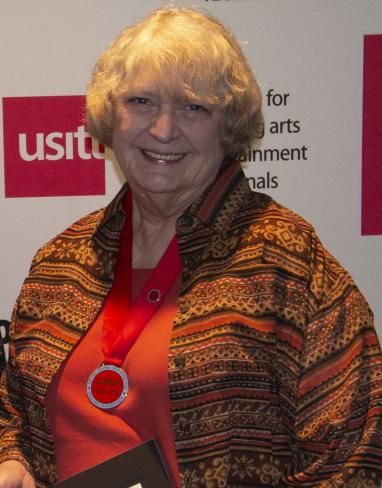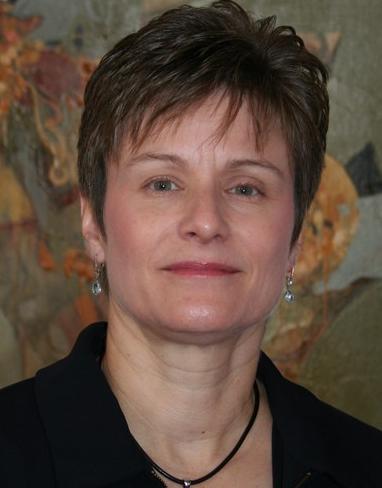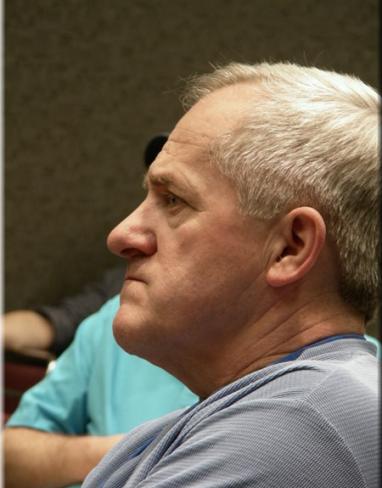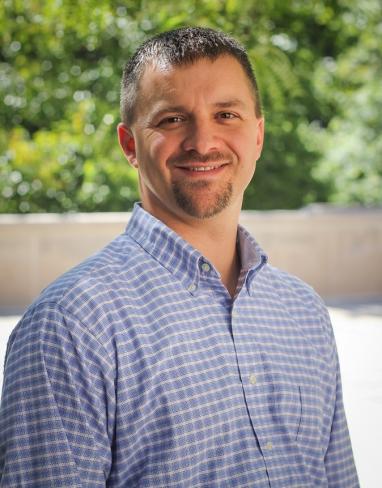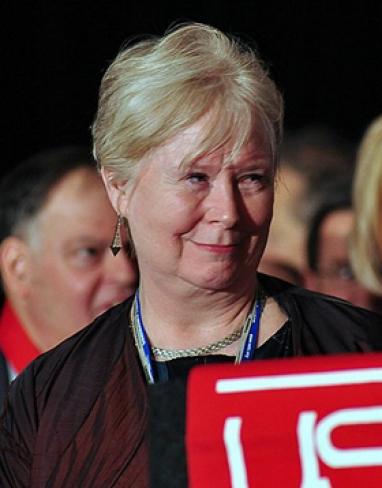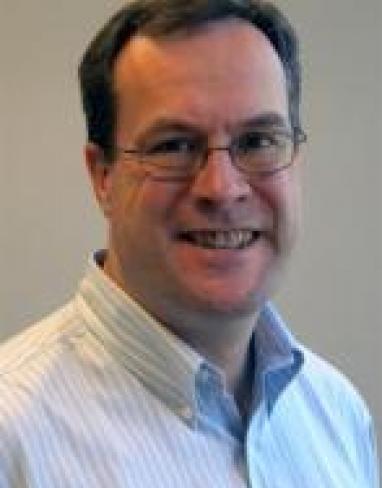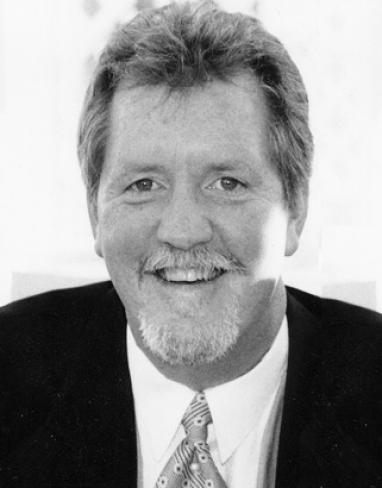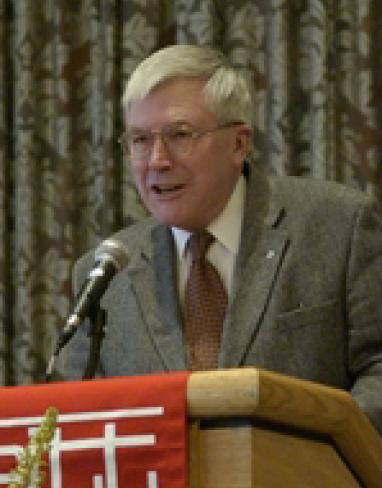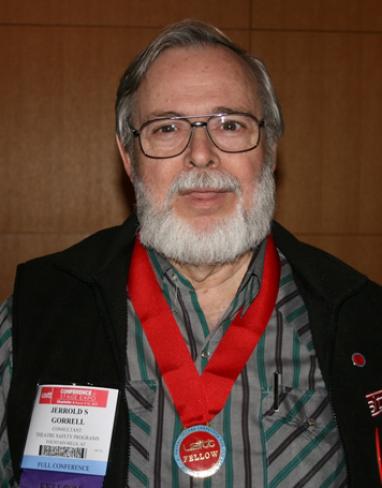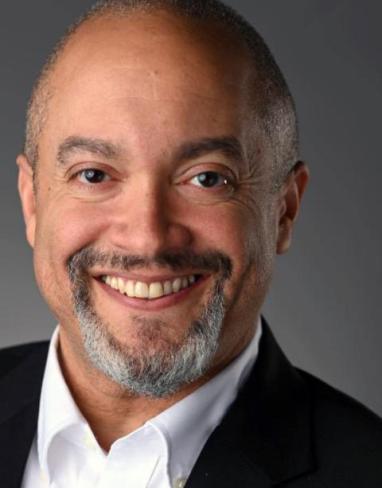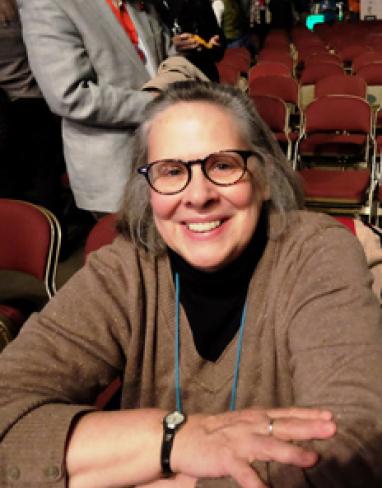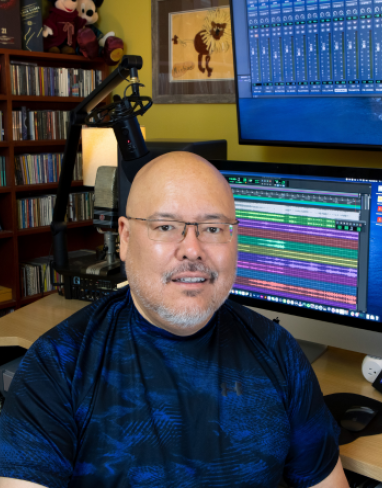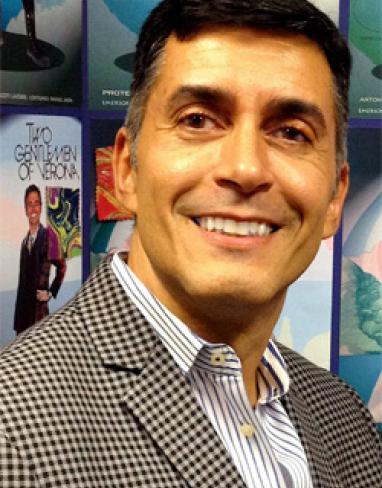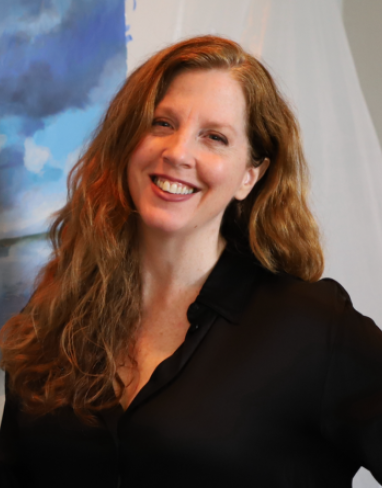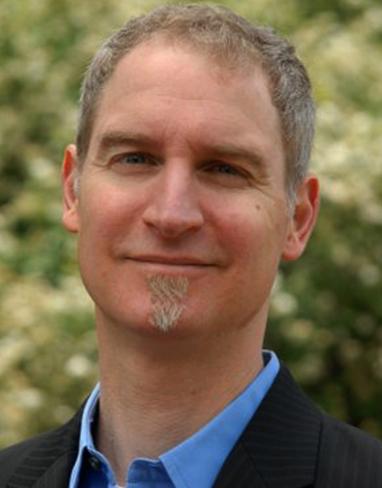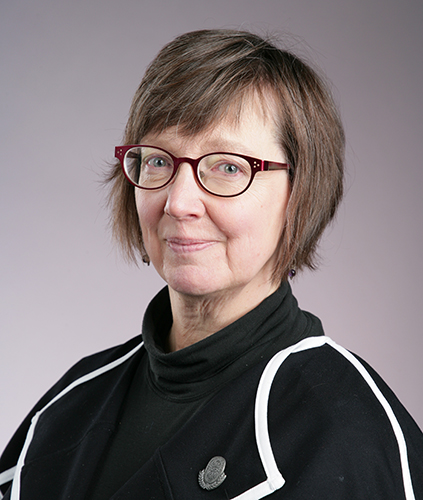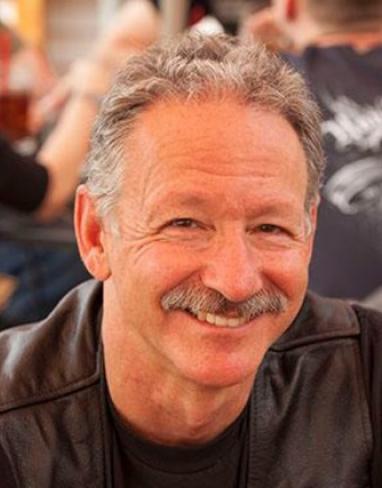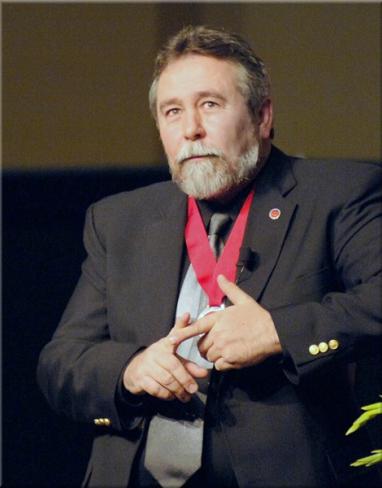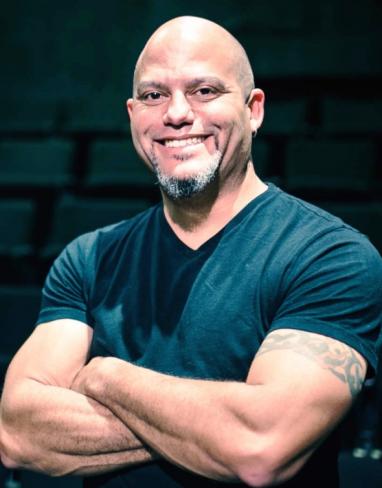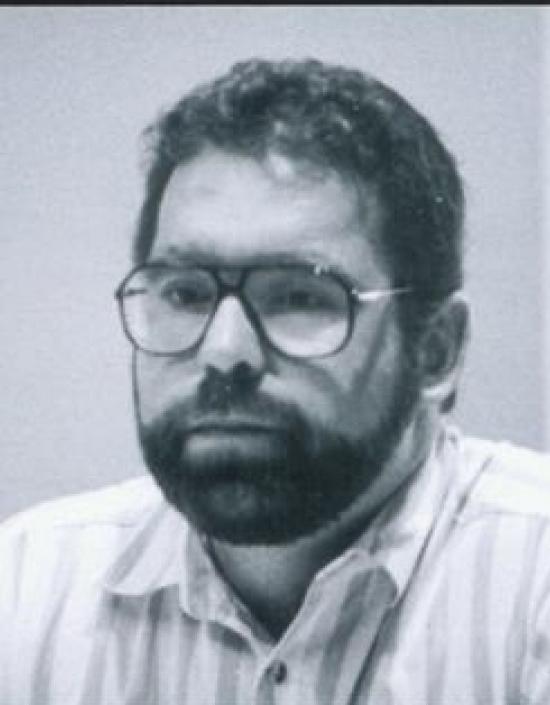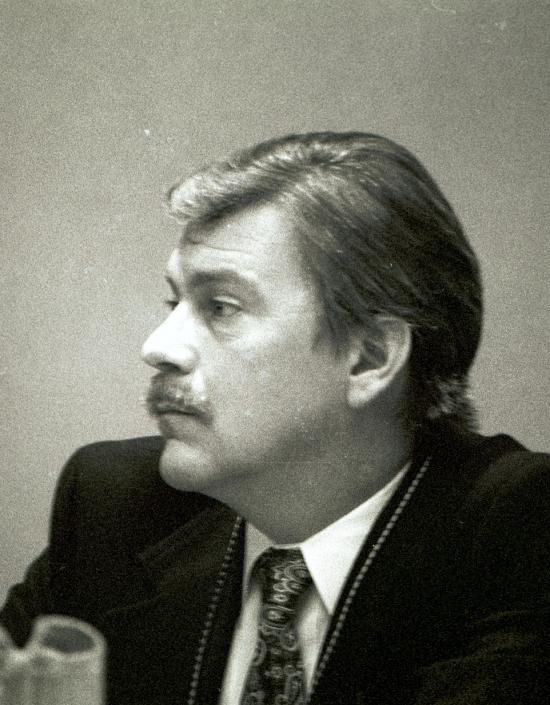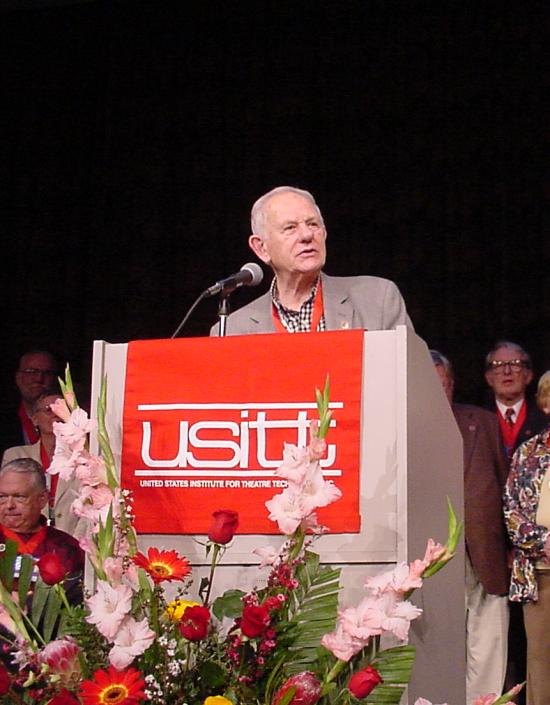Fellows of the Institute
Fellow is an honorary designation awarded for life upon those who have made a truly outstanding contribution to the performing arts community and to the work of USITT.
.png)


Joe Aldridge
First active in USITT?
I first became involved in USITT in 1985 and attended my first conference in Oakland in 1986. The Calgary conference is the only one that I have missed since then. I became an active participant in 1993 at the Wichita conference where I sat on my first panel.
Does anything stand out as your favorite USITT memory?
My favorite memory occurred at the Thursday evening Fellows Address where Rick Stephens introduced me as one of the newly inducted “Fellows” of the Institute. It was a total shock and one of the most humbling experiences of my life. I was fortunate that my daughter was there with me to share in the experience.
Some career highlights:
- The majority of my career has been spent in Las Vegas where I have taught at UNLV and often worked as a union stagehand in various showrooms on the Strip.
- I have had the good fortune to be able to go on tour with Siegfried and Roy to Japan.
- I have taken a production, at the invitation of the Greek government, to Delphi, Greece.
- I have also been able to take numerous productions to the Edinburgh Fringe Festival.
- Most important to me is the fact that I have been able to write and implement a new undergraduate degree in Entertainment Engineering and Design which has been very successful.
USITT involvement/positions held:
- 1995 – Las Vegas Conference Chair
- 1996-2002 – Conference AV Coordinator/Media Resources Coordinator
- 2002-2003 – VP for Special Operations
- 2003-2009 – VP for Conferences
- 2009-2010 – President Elect
- 2010-2012 – President
- 2012-2014 – Immediate Past President
Are there memorable USITT characters who have made a difference to you?
There are a number of memorable characters who have made a difference to me. Folks who made me feel welcome into the Institute. The list is exhaustive, so, here are a few: Dick Durst, Leon Brauner, Christine Kaiser, John Uthoff, Rick Stephens, Travis de Castro, Sarah Nash Gates, and many, many more!
About being a Fellow?
When it was announced that I had been selected to join the Institute’s elite as a member, I recall it being something akin to an out-of-body experience! I was numb at the thought that I had been singled out to receive such an honor. The group of individuals that I had been chosen to join reads as a “Who’s Who” of the entertainment world. I soon realized that with such an honor came great responsibility and I strive to maintain my “worthiness” of such an honor!
USITT and your career?
USITT has had a profound effect on my career. At a university where I was the 6th Technical Director to have applied for and received tenure, to date the only person to do so, it wouldn’t have been possible without my association with USITT. I was given opportunities to serve in leadership roles that influenced the granting of tenure. To my Dean, my involvement in USITT was the pinnacle of a career for a technical director. He felt that by rising in the ranks with USITT leadership roles, I was bringing great honor to the department, the college and the university. He held my achievements as benchmarks for those who would follow.
Your publications:
Does Graffiti on the Men’s Room walls count?
Mentoring?
I would be happy to mentor aspiring young technical directors and technicians.
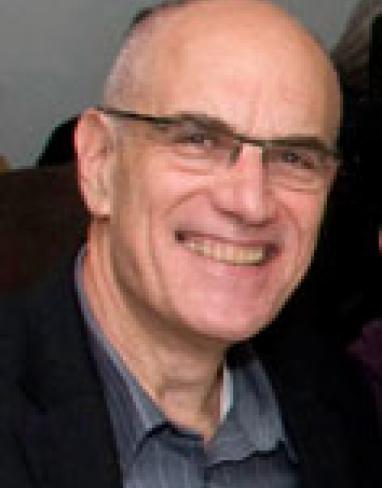

Arnold Aronson
Your earliest memories of the Institute:
I became involved in USITT in 1977 when I was appointed co-editor of TD&T (with Kate Davy). My first conference was in 1978 in Phoenix. I believe it was at that conference that Randy Earle and I began our "tradition" of having a dinner together at the conferences. I seem to remember that at the 1980 conference in Overland Park he invited Sarah Nash Gates to join us which is when I first remember meeting her.
Your favorite USITT memories?
At some point in those early years Eric Fielding and I became friends and both our universities where we taught (Utah and UVA) were often in the NCAA tournament. So we would duck out of conference sessions to go up to one of our hotel rooms to watch.
Career highlights:
- Chaired theatre departments at U of Michigan; Hunter College; Columbia University (also served 2 year as Assoc. Dean in the School of the Arts).
- Chair of the History and Theory Commission of OISTAT
- 2 stints as President of the Jury at the PQ (1991 & 1999), and General Commissioner of PQ in 2007 (first non-Czech commissioner).
- Joel E. Rubin Founder's Award (2009)
- Co-founder and co-editor (with Jane Collins) in 2015 of Theatre and Performance Design, a journal of scenography published by Routledge.
Your involvement in the Institute?
In addition to 10 years editing TD&T and serving as a Contributing Editor ever since, I represented the Institute at several OISTAT meetings around the world.
USITT characters who have made a difference to you?
The main one has to be Eddie Kook. He was the most memorable person on the committee that interviewed us for the TD&T position. At some point after we had been appointed he took me aside at a party (at the apartment of Ron Olson and Herb Greggs, if I remember correctly) and told me that I should write about American designers for the journal. It was essentially the catalyst for my career. I also remember a conference (though I don't remember which one) where Kookie escorted me around the exhibitors' floor, pointing out the design and advertising flaws of almost all the exhibitors--and he was right!
Others from my years as editor include Ned Bowman, Gary Gaiser, Fred Wolff, Bernie Works, Dick Arnold, Dick Devin. David Weiss was first and foremost a colleague (and chair) at UVA, but when Ned Bowman offered me the chance to attend the OISTT (it wasn't yet OISTAT) Scenography Commission meeting in Moscow in 1980, it was David who found the rather substantial money for my travel. That may have been the most exciting trip of my life.
Pat MacKay was an acquaintance before my USITT years and has been a constant--and much needed--source of friendship and advice.
When Sarah Nash Gates was President she asked me to curate the US Exhibit at the 1995 PQ which was one of the memorable experiences of my life.
And finally Joel Rubin, who I also remember from the initial interview, who was a strong supporter throughout all the years, who sent me to numerous international meetings (including the one at which we voted to put the 'A' in OISTAT), who got me involved in the PQ, and is an ongoing friend with whom I have lunch every couple of months.
A further Ed Kook story that I told when I received the George Freedley Memorial Award from the Theatre Library Association for the Ming book:
When Ming was in his one, rather unhappy, year as a grad student at UCLA Kook came out to give a workshop. Ming showed him his designs and Kook told him that when he came to NYC he (Ming) should call and Kook would introduce him to Jo Mielziner. Of course Ming moved to NY right after his one year at UCLA in the fall of 1954, called Kook, who put him in touch with Mielziner and . . . the rest is history.
A little over 20 years later, Kook told me to write about designers and pointed me in the right direction and the rest . . . . So both Ming and I owe at least part of our careers to Eddie Kook, and one result is Ming Cho Lee: A Life in Design.
Anything you want to say about being a Fellow?
I'm afraid, because I have been largely inactive in recent years, I have not participated much in Fellows' activities, but I still consider it one of the great honors of my life to have been selected.
Anything you'd like to add about what the USITT means to you personally?
As I noted above in talking about Eddie Kook, USITT is largely responsible for my career. It established me as a writer about design which has led to a few books, contacts around the world, and as a result, the various academic positions I've held. It got me involved in the PQ. USITT was directly responsible for visits to 9 countries (including my first visits to the Soviet Union and China) and through the contacts made at those meetings, visits to many others. I cannot imagine what my life would have been like without USITT.
A few of my selected publications:
- The Routledge Companion to Scenography, Editor (Routledge Press, forthcoming 2016)
- Ming Cho Lee: A Life in Design (Theatre Communications Group, 2014)
- Looking into the Abyss: Essays on Scenography (U. of Michigan Press, 2005)
- The Disappearing Stage: Reflections on the 2011 Prague Quadrennial (Theater Institute Prague, 2012)
- American Avant-Garde Theatre: A History (Routledge Press, 2000).
- American Set Design (Theatre Communications Group, 1985).
- Articles in TD&T, American Theater, The Drama Review, Theatre Crafts, Theatre Quarterly, The New York Times, Performance Research, etc.
List of books that you recommend about the field:
Aside from my own, of course . . . There are many dealing with design and architectur Here are a few:
- Setting the Scene, Alistair Fair, ed.
- From the Score to the Stage by Evan Baker
- Visuality in the Theatre by Maaike Bleeker
- The First Frame by Pannill Camp
- Entangled by Chris Salter
- Performance Design, Dorita Hannah and Olav Harslof, eds.
- Light by Scott Palmer
- Theatre and Performance Design, Jane Collins and Andrew Nisbit, eds.
- Theatre Performance and Technology by Christopher Baugh
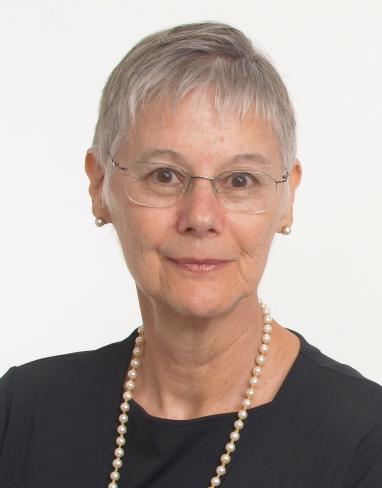

Diane Berg
Earliest Memories of Institute
- I learned about USITT from Van Phillips, Lee Watson, and Stan Abbott when I joined the faculty at Purdue University. That year (1981) the conference was in Cleveland and the entire faculty attended. Van told me I needed to get involved with the Costume Design and Technology Commission. Being a shy person, I wasn’t sure how I would accomplish such a feat, but I had yet to meet Joy Emery, Costume Design and Technology Commissioner. My first session, I discovered that if you made eye-contact with Joy Emery, you would find yourself on a committee! By the following conference I was Chair of the Costume Health and Safety Project! But my favorite memory of Joy is when she called me to say because West Lafayette, Indiana, was close to Minneapolis, Minnesota, perhaps I could organize a symposium there.
Favorite memories
- The Costume Symposium in England in 1997 was two and half years in preparation and the joint effort of the outgoing commissioner (me), the incoming commissioner Deb Krajec, former commissioner Kevin Seligman, and Graham Cottenden of England’s Bournemouth and Poole College of Art and Design. This ten-day event included lectures by Janet Arnold, Avril Hart, and Jean Hunnisett, among others, and tours of Shakespeare’s Globe Theatre, the V & A, the National Portrait Gallery, the Imperial War Museum, the Costume Museum at Bath, Montacute House, Milton Abbas, and the Brighton Museum and Royal Pavilion, as well as stage performances at the Globe, the Royal National Theatre, and the Chichester Theatre Festival. The symposium, with fifty attendees, was a glorious success and a wonderful way to complete my tenure as commissioner.
Career highlights
- Ohio Northern University, Costume Director/Draper, 1973-1977
- The Asolo State Theatre of Florida, Costume Shop Manager/Tailor, 1978 & 1979
- Purdue University, Director of Costume Technology, 1979-1986
- University of North Carolina School of the Arts, Costume Shop Director, Costume Technology faculty, 1986-2002
Involvement in USITT
- Chair, Costume Health and Safety Project, 1982-1988
- Vice-Commissioner, Costume Symposium, Minneapolis, Minnesota, 1984
- Vice-Commissioner, Costume Symposium, Winston-Salem, NC, 1989
- Commissioner, Costume Design and Technology Commission, 1991-1997
- USITT Nominating Committee, 1993-1995
- Represented USITT at the National Black Theatre Festival, Winston-Salem, NC, 1994
- U.S. delegate to the OISTAT First World Costume Congress, Las Angeles, CA, 1995
- USITT Awards Committee, 1996-1998
- Fellow, 1996
Memorable Characters
- Joy Emery, Christine Kaiser, Van Phillips, Joel Rubin, Don Stowell, Paul Rinehart, Jean Montgomery, Larry Hill, Bruce Brockman, Leon Brauner, Sarah Nash Gates, Randy Earl, and numerous members of the Costume and Technology Commission, notably Betty Blyholder, Rebecca Cunningham, LaLonnie Lehman, Gwen Nagle, Deb Krajec, Kathleen Gossman, Irene Corey, Kevin Seligman and so many more.
About being a Fellow
It was a total surprise and an extreme honor to be inducted as a Fellow and to join this remarkable group of theatre artists.
What USITT means to me personally
- Despite my being inactive in recent years, USITT has been an important part of my life. Attending national conferences and costume symposia provided me the opportunity to meet colleagues from all over the U.S. and indeed, the world. The networking and lifelong friendships have offered me support, encouragement, and validation, both professionally and personally. I established an endowment at the University of North Carolina School of the Arts for the Design and Production students to attend the annual conference so that they, too, can have the amazing, life changing experiences USITT has to offer.


Alexandra Bonds
Your earliest memories of the Institute...as in how far back do you go?
My first conference was in New York in 1985. I had submitted work for the Design Expo, and when it was accepted, I decided to find out what USITT was all about. I arrived without a room reservation and was kindly received in a shared room with (could this memory be true?) Sylvia Hilyard (now Pannell), Deb Bell, and someone else. What a fortuitous beginning. I remember an early session, perhaps at that same conference, with Douglas Russell, Paul Rinehart, and Don Stowell. The image in my mind is that I was sitting on the floor, feeling as though I were at the feet of the gods.
Does anything stand out as your favorite USITT memory?
The composite and most profound memories center on the enduring friendships, and numerous professional development opportunities. Working on the USITT exhibits for the PQ in 2003, 2007, and 2011 enabled me to work with Bob Scales, Laura Crow, Susan Tsu, Bob Schmidt, Rick Thomas, Madeleine Sobota, Nic Ularu, Tom Korder, Eric Stone, Mike Monsons, Alessia Carpocha, Bill Bloodgood, and Ursula Belden, and many others. Through the Costume Commission, I have connected with Sylvia Pannell, Joy Emery, Whitney Blausen, and the indomitable Zee Weisfeld. The Institute has recognized my research with two Herb Greggs Awards and an Edward Kook Grant, enabling me to write a book on Beijing opera costumes, for which I will always be grateful. I joined the USITT tours to the PQ in 1987, (traveling with Oscar Brockett and Paul Rinehart), 1995, and 1999 (traveling with Rosemary Ingham), with Eric Fielding, and Leon Brauner as group leaders. I also toured Egypt and Jordan with Dick and Karen Durst in 2009.
Short list of your career highlights
1979-present Professor of Costume Design at University of Oregon
1987 and 2012 Taught in London through AHA International
1990-1 Fulbright appointment to teach in Taipei, Taiwan at the then called National Institute for the Arts.
1987, 1999, 2007, 2015 costumes designs selected for USITT-USA exhibit to PQ
2009, 2013 costume designs selected for World Stage Design in Seoul and Cardiff
2015 costume designs selected for Costume Design at the Turn of the Century in Moscow, Russia
Costume Designs selected for Design Expo eight times
Short list of your various involvements in the institute
Board Member 2003
Vice President for International Activities 2004-2011
Conference Programming, Sightlines Articles, International Tours Coordinator
Commissioner for USITT-USA Exhibits to PQ 2003, 2007
International Liaison for USITT-USA Exhibits to PQ 2011
Fellow since 2007
If you were to make a short list of the memorable USITT characters that have made a difference to you, who would they be?
My one-time colleague at the University of Minnesota-Duluth, Dick Durst, tapped me to succeed him in preparing the USITT exhibits for the Prague Quadrennial, which led to my becoming the Chair of the International Committee. Shortly after that, then USITT President, Bruce Brockman initiated the position of Vice President for International Activities. I went from being a member to an officer in a very short period of time. Dick was my ever-generous guide through the first PQ exhibit. Leon Brauner has been my gracious advisor for international decorum, and Joel Rubin has quietly coached me via emails. (Plus all those mentioned above.)
Anything you want to say about being a Fellow?
I never expected to be called upon to become a Fellow of the Institute. I thought one needed to work much longer and harder than I had to achieve this recognition. I am honored by being inducted into this part of the organization, and have eagerly welcomed others with whom I have worked closely into this group. Now I am a member of the Make It So Taskforce within the Fellows and am delighted to team with this collective to generate new initiatives to enhance the already strong networking component of USITT.
Anything you'd like to add about what the USITT means to you personally?
USITT has clearly been a major force in shaping my career and the choices I have made within the profession. I have received grant support and awards for the research I conducted on Beijing opera costumes. My costume designs have been recognized in many forums, from the Design Expo to the USITT-USA exhibit to the PQ. Recognition in both of these areas contributed to my aim of becoming an artist-scholar. The opportunity to be engaged in the organization of the USITT exhibit for the PQ not only enabled me to work with outstanding colleagues in the organization, it also connected me with colleagues from around the world and introduced me to global perspectives on design. That influence has spread to every aspect of my career, from teaching to designing, to planning the next international journey to witness theatre productions around the world.
List of your publications (if any)
Entry in Routledge Handbook of Asian Theatre on Beijing Opera Costumes, Forthcoming.
Jingju. Il teatro cinese nella Collezione Pilone, Museo delle Culture, Lugano- Castagnola, Switzerland, 2014. 20 photographs reprinted from Beijing Opera Costumes: The Visual Communication of Character and Culture.
“The Visual Language of Dress,” in On Stage: The Art of Beijing Opera. Basel: Museum der Kulturen. Summer 2011.
“Performance Dress in China and Taiwan,” Berg Encyclopedia of World Dress and Fashion: East Asia, with Dongshin Chang and Elizabeth Johnson, 2010.
Beijing Opera Costumes: The Visual Communication of Character and Culture, University of Hawaii Press, April 2008.
“Surface Design in Jingju Costumes: The Aesthetics and Meanings of Embroidered Imagery in the Beijing Opera,” Theatre Design and Technology, Spring, 2001.
“Beijing Opera Costumes, discovering the meaning in costumes of traditional Jingju,” Theatre Design and Technology. Fall, 1997.


Leon Brauner
I believe I attended my first USITT conference in 1969 or 1970. It was shortly after I took a job at Indiana University and I met one of USITT’s best advocates – Gary Gaiser. As I think about it, Gary was more than an advocate, he was a “cheerleader.” He cared about “the institute,” education, his colleagues, Hazel, and what he cared about he was also passionate about. I had already been working in stage costuming at Utah State University and the University of California (Santa Barbara campus), and was aware of USITT, if fact I may have been a member receiving TD&T, but not really a participating member. Gary had a way of engaging you in those things he cared about and then, before you knew it, delegating or putting you “in charge” of something or other. But, Gary had another quality – one that he shared with others in the “old guard.” He was good at introductions. He was good at entwining your interests with those of other like-minded institute souls.
As I think about those meetings, I am also reminded of the gracious and giving nature of many of those guys and gals. Gary’s specialty was stage lighting and so most of his USITT colleagues were into stage lighting or the business of lighting. But you know what? All of these people wanted to be as helpful as they could be to this young (yikes, I WAS young then) costume guy. Early on, I met and was initiated into the workings of the Institute by many of our honored Fellows. I began to list the names I could remember and it became too long and surely too incomplete.
I was able to take a sabbatical in 1970-71. Both Joel Rubin and Ned Bowman were gracious and giving of their time and contacts. Joel wrote many letters of introduction and spent time giving me “the lowdown” on specific colleagues and institutions I was going to encounter. My year was spent mainly in old Eastern Europe, with travels to all of the national theatres and a large handful of smaller city theatres. I was also loaned some USITT/ USA OISTAT Centre stationary so that I could type (yes it was that long ago) letters of thanks, and also craft my own letters to OISTAT Centres that “I was coming, and would be at their door at such and such a date and time.” We were six, Roberta and our four young kids and our yellow VW bus – the Yellow Submarine, tootling across slow, sometimes frightening border crossings. This was considered the cold war period and there were many new (to this young family) and disturbing elements to traveling in these well-guarded, sad, dark places. Many of my university colleagues had asked why in the world would I consider taking my family into Eastern/ Communist Europe. On the other hand, Gary, Ned, and Joel helped me understand that we were going to visit people, theatres, culture, and lots of wonderful new experiences. If it had not been for my USITT colleagues I may not have made this wild, wonderful leap into an unknown world – a world that was described by its politics, or in broad, often ignorant strokes.
This Brauner family OISTAT/USITT adventure lay the groundwork for a life of travels, as well as a life of helping others have life changing experiences. Many of the people we met on that first adventure have remained good friends and colleagues. Some have given program sessions at conferences, or given workshops in universities. The doorway was opened (or opened further) to find places for our designers and technicians to participate in workshops in other countries.
When one traveled in “the old Eastern Europe” days, one was encouraged to check into the consulate or embassy of each new country or city one was visiting. We became friends with a number of cultural attaches during this travel. I was asked to give talks on theatre and culture in the USA to small groups of theatre people and often people from the newspapers (nothing too anti-regime about culture – so they thought). We almost always stayed in private accommodations that we found for ourselves. We rarely presented our consular colleagues with problems to help us with. About five or six years later I was contacted by USIA to see if I would like to give a series of lectures on American theatre and culture at theatres in the Balkans. Why me? Certainly not because I was the best lecturer on those subjects, but I was nimble and seemed to always land on my feet when in a new situation in a new place. About a decade later I was once again asked to take on the Associate Directorship of the American Studies Centre at Warsaw University. Being on the faculty of Indiana University and having previous experience traveling, lecturing, and landing on my feet made it possible for me to live and work in one of my favorite countries. It sounds as though I may be giving too much credit to my colleagues in USITT – but, I say no. I would not have made that leap if my Institute mentors had not helped focus me on the value and pleasure that comes from meeting new people in new places and then sharing what you are both passionate about.
I was also fortunate to be able to plan and lead two PQ summer tours. I think they turned out okay. The tours were a wonderful opportunity to share travel experiences, and European theatre colleagues with their USITT counterparts.
I ended my USITT service career as head of the USA OISTAT Centre and served on the OISTAT Executive Committee for several years as it secretary.
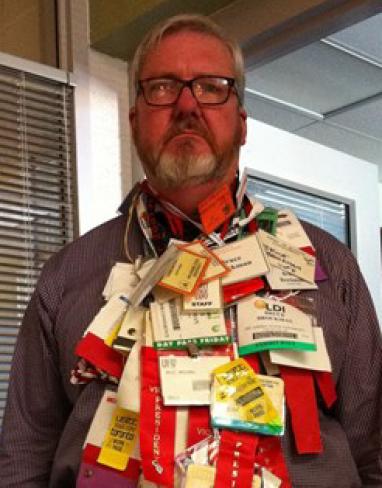

Bruce Brockman
Your earliest memories of the Institute?
My very first conference was in 1980 in Overland Park Kansas. The hotel was about 3 minutes from where I grew up. It was very memorable for a variety of reasons, but mostly because I got hired to teach at the University of Idaho at that conference. I stayed at the U of I for 17 years.
Favorite USITT memory?
I have some really wonderful memories and experiences at USITT conferences, but one that sticks out in particular was the Pittsburg Conference. USITT hosted the OISTAT World Congress and may of us had the opportunity to attend a dinner and subsequent party that we threw for them featuring Squonk Opera. I remember standing in the ballroom of the William Penn Hotel -- filled with murals by Joseph Urban-- enjoying a reception that included Josef Svoboda an a large number of other folks and thinking of all of the amazing places and people USITT had given me the opportunity to experience.
Career highlights:
I have served as Department chair of Theatre at University of Idaho, Oklahoma State University, University of Wisconsin-Milwaukee, and Director of the School of Theatre, Film & Television at the University of Arizona.
I have freelanced as a set designer and scenic artist and have produced work for Music Theatre of Wichita, Milwaukee Ballet, Milwaukee Chamber Theatre, University of Michigan's Music Theatre Program, First Stage Children's Theatre, Montana Repertory Theatre, and Idaho Theatre for Youth.
Short list of your involvement in the Institute:
- Chair of Design Expo Committee
- Vice President for Commissions
- President of the Institute
- Immediate Past President
- Member of two PQ committees
- Fellow of the Institute
Memorable USITT characters who have made a difference to you?
I have gotten to associate with many wonderful people in USITT including Sarah Nash Gates, Norm Bouchard, Dick Durst, Larry Hill, Chris Kaiser, Richard Pilbrow, Bobbi Owen and many, many other folks who have made significant contributions to the success of USITT.
What are your thoughts about being made a Fellow?
Aside from having my older brother Lance (Mom always liked him best!) share every unfortunate photo of my youth with all of my colleagues when I was inducted as a Fellow, I was immensely proud to be included in this group of folks who have given so much of their time, expertise, and treasure in order to make the Institute the success it is today.
What does the USITT mean to you?
USITT has been extremely important to my career because it kept the world a larger place and gave me a way to connect with colleagues from around the country.


Lance Brockman
Does anything stand out as your favorite USITT memory?
Memories of the Institute revolve around renewal of friendships and for that matter, the developing of a national network of colleagues that still serve me today. Perhaps Wichita is the most memorable or forgettable experience as there was originally a real effort to bypass Wichita for somewhere with more amenities (ERA issue still was a concern). I was on the Board that decided to take the risk and go with a much promised "Improved Wichita." That was far from the case and for a state known for beef, the dinner "steaks" served at the banquet must have been imported--from New Jersey!! However, seeing Sarah Nash Gates come into the banquet on horseback did a lot to lift everyone's spirits and Wichita will always be remembered.
Short list of your career highlights:
Taught at Morehead State University in Kentucky and came to the University of Minnesota (1973) where I am currently a 38-year professor. Based on my interest, developed while painting for two summers at Starlight in Kansas City, I located three collections of sketches used by scenic studios to create illusionary backgrounds for vaudeville, circus, and the fraternal stage. Two NEH funded interpretative exhibits evolved from these collections. Obviously, my induction into the prestigious Fraternal Order of the French Mineral Orange has sustained me with great friendships and more than my share of laughs.
Short list of your various involvement in the institute:
I have served on the Board three times. For several years, I handled the juried section of Design Expo and also chaired the Golden Pen committee for a couple of years. Of my efforts, my contribution to the Endowment Committee has been the most rewarding--giving back to what nurtured my early research efforts.
If you were to make a short list of the memorable USITT characters that have made a difference to you, who would they be?
I would be remiss to not mention Forrest Newlin my teacher and mentor. He gave me a passion for design and education that still sustains me today. I also miss John Rothgeb from U.T.--Austin, as he helped launch me on my research journey. Dick Durst and Larry Hill made up the two parts of the triumvirate that organized and lead the USITT Conference in Minneapolis/St. Paul in 1987. We are still great buds based on that event and the fact that we live in the frozen North for several years. Having my brother, Bruce as a colleague and Fellow has been a great source of entertainment for us and for others in the Institute.
Anything you want to say about being a fellow?
If I can be candid, I use to refer to the Fellows with their ribboned medallions, as what appeared to me as a bunch of wine stewards looking for a snotty Merlot. That changed when I was selected and it was made more poignant but a nomination speech but close colleague and friend, Jean Montgomery. That was coupled with a ceremonial kiss by Dick Durst and Larry Hill--that picture is still on my door. The following year, it was my privilege to give the induction speech for Bruce which allowed me to fill a screen with embarrassing images of us growing up.
Anything you'd like to add about what the USITT means to you personally?
USITT bring to many of us verification that what we do as artists and technicians has both important cachet and a nexus of sharing new ideas. I am always impressed with the amount of volunteerism that makes this group hum. We could have gone the way of other professional organizations and relied on professionals to chart our course but then we would risk going the way of many of these organizations to extinction. Balancing between what we must do and have to do is an imperative that drives me in USITT.
List of your publications:
- The Twin City Scenic Collection: Popular Entertainment 1895-1929. Contributing essays by C. Lance Brockman, George Lipsitz, John R. Rothgeb, Forrest A. Newlin, and Lawrence Hill. University of Minnesota Press, 1987.
- Theatre of the Fraternity: Staging the Ritual Space of the Scottish Rite of Freemasonry, 1896-1929. Contributing essays by C. Lance Brockman, Kenneth L. Ames, William D. Moore, Mary Ann Clawson, Mark C. Carnes, and Lawrence J. Hill. University of Mississippi Press. 1996.
Mentoring?
Always students. I would also suggest that I could do something on research development for probationary faculty.
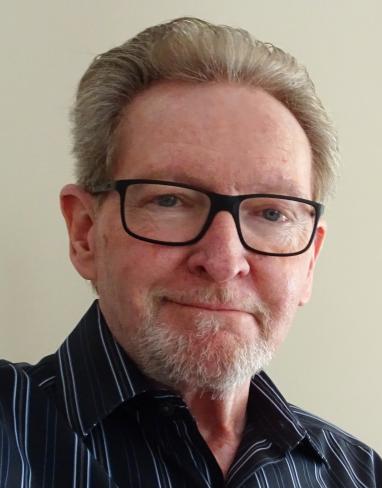

Bill Byrnes
Inducted as a Fellow: 1993
Your earliest memories of the Institute?
My first encounter with USITT was at the Anaheim Conference in 1975. I went to the conference to interview possible hires for an Assistant TD position I was trying to fill. Before that conference, I did not know there was an organization made up of people who spoke the same language I did, and I found a network of colleagues and friends and have been a member ever since.
Favorite USITT memory?
One of my favorite memories, among many, was driving Eddie Kook and his wife from the hotel to the airport when I was chairing the Cleveland Conference in 1981. He and his wife were in competition with each other to see who could back-seat drive the best. It was like something out of a Seinfeld episode.
Short list of career highlights:
I was fortunate to find an early career as a TD and lighting designer that had its roots in my undergraduate employment as a stagehand in a campus performing arts center. That work-study job allowed me to meet and work with hundreds of professionals in every aspect of the performing and visual arts over four years. Three summers working at Santa Fe Opera and graduate school at UCLA led to a career that included working on over 150 productions in higher ed and freelancing as a lighting designer and consultant. As I grew to understand more about how the whole production process and entertainment industry worked, my career opportunities expanded to production management and producing. Those opportunities, coupled with my teaching, later morphed into a career track in theatre and arts management. The arts management part of my career has enabled me to lecture and present in Japan, China, Singapore, and several countries in Europe.
Short list of your involvement in the Institute:
- USITT Board of Directors 1980-83
- Chair 1981 Cleveland Conference
- Member, officer, and newsletter editor for the Ohio Section of USITT from 1978 to 1994 (now the Ohio Valley Section)
- USITT Board member and Officer VP for Marketing and Membership 1985-2000
- USITT President-elect, President, and then Past-President 2000-2004
- Member of USITT Finance Committee 2005-2009 and member of the Management Commission for many years
- Chair of USITT 21st Century Task Force 2007-2009
- Member of USITT Executive Director Search Committee 2009-10
- Member of the Fellows Fundraising Working Group and the USITT Development Committee since 2018
If you were to make a short list of the memorable USITT characters that have made a difference to you, who would they be?
Steven Hild was one of the determined volunteers behind getting design exhibits started at the USITT Conferences more than four decades ago. He was passionate about this project and showed me how one member could make a difference. While there were many barriers to overcome, he found a way to make these exhibits happen and get them published and cataloged. Steve’s dedication to this project in the late 70s and early 80s paved the way for the numerous design and technology exhibits we have on the Stage Expo floor today.
Henry Tharpe was also an inspiration for his unflappable get-it-done drive at the March 1980 Conference in Overland Park Kansas. A snowstorm, scheduling snafus, and more people showing up for the conference than anyone imagined didn’t slow Henry down. It was a conference that was a USITT “tipping point,” and it set the stage for ever larger and more complex conferences in the years after.
Sarah Nash Gates, Chris Kaiser, and “Gino” Montgomery were inspiring women leaders in USITT. They impressed the hell out of me with their endless energy and devotion to USITT, and especially their commitment to its financial solvency. Being on the Finance Committee with them helped me understand how important it was to connect the mission and planning to the budget. We have them to thank for the fiscal health USITT enjoys today.
Dr. Joel Rubin and Leon Brauner opened my eyes to the fantastic possibilities of being part of the International Activities of USITT. Thank you.
There are many more memorable “characters,” but that’s a good start.
Anything you want to say about being a Fellow?
You could have knocked me over with a feather when I was inducted into the Fellows. It was an honor to be among a group of people who helped shape (and continue to shape) the entertainment industry and deeply embedded theatre and theatre design and technology into American universities and colleges after WWII. I am especially proud of the Fellows for ramping up their current engagement with a wide range of activities in USITT and re-affirming their commitment to mentoring future leaders in our profession.
Anything you’d like to add about what the USITT means to you personally?
I can safely say USITT has been integral to my professional development as a theatre practitioner, educator, designer, manager, and leader. USITT has been my “learning laboratory,” so to speak. There was so much to still learn after graduate school. I don’t know what I would have done if it weren’t for USITT. As I look back on it, USITT was my continuing education program. My transformation from being a “techie” working on load-ins and in the scene shop to being a TD, Stage Manager, Production Manager, Department Chair, Program Director, Associate Dean, a Fine Arts Dean, and an Associate Provost was made possible by my work with USITT. I was also humbled and honored to be among those singled out for the Joel E. Rubin Founders Award in 1996, and by the Management Commission with their Distinguished Achievement Award in Management in 2011, and being made an Honorary Lifetime Member in 2020.
Publications:
Management and the Arts, 6th edition and the book’s companion website
The Routledge Companion to Arts Management, edited by me and my London colleague Aleksandar Brkić. I also contributed a chapter entitled, “Getting on the Balcony: Deploying adaptive leadership in the arts”
Arts Leadership: International Case Studies, I contributed a chapter entitled, “The Utah Shakespeare Festival: An evolving arts leadership partnership.”
I also served as editor of the “Inside USITT” section of TD&T from 1996 to 2012
Must have books in the management field (besides my own, of course):
- Managing by Henry Mintzberg
- The Time Paradox by Philip Zimbardo and John Boyd
- The Essential Drucker by Peter F. Drucker
- Good to Great by Jim Collins
- A Whole New Mind by Daniel Pink
- The 80/20 Principle by Richard Koch
- The Practice of Adaptive Leadership by Ronald Heifetz, Alexander Grashow, and Marty Linsky
Mentoring?
I am more than happy to help students and colleagues in any way I can be of service.
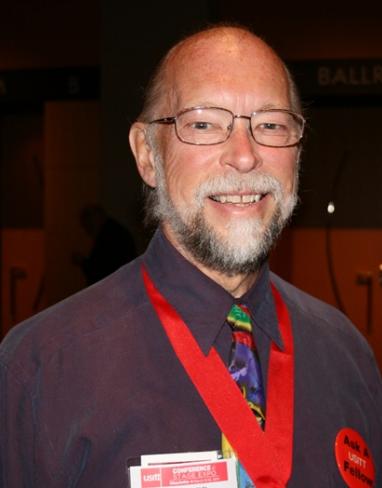

Dick Devin
Does anything stand out as your favorite USITT memory?
The most powerful memories of USITT to me are those of getting to know the great people of our industry, such as Eddie Kook, Jo Mielziner, Harold Burris-Meyer, Joel Rubin, Peggy Clark, Don Stowell, Lee Watson, Oren Parker, Richard Pilbrow – to run into them at a conference and discover what approachable, lovely people we have an opportunity to work with in USITT and in our profession.
Short list of your career highlights
BA in Drama, University of Northern Iowa
MFA in Theatre Engineering, Yale School of Drama
Lighting Designer with over 40 regional theatre companies, Off-Broadway, and theatres in Tokyo, Cairo, and Hong Kong. Theatre Consultant for numerous projects. Managing Director, Williamstown Theatre Festival and Theatre Three in Philadelphia; Producing Artistic Director, Colorado Shakespeare Festival. Professor of Theatre Design, Temple University, University of Washington School of Drama, University of Colorado.
Short list of your various involvement in the institute
Founding Chair of Pacific NW Section; Chair of 1979 Annual Conference in Seattle; First Co-Commissioner of Lighting and Sound Commission; V.P. for Commissions and Projects: President, 1988-1990; Chair of Nominations Committee; Chair of Awards Committee; Grants and Fellowships Committee; Fellow of the Institute; Joel E. Rubin Founder’s Award; Lifetime Membership Award.
If you were to make a short list of the memorable USITT characters that have made a difference to you, who would they be?
Far too many to do them all justice: Will Bellman, Joel Rubin, Pat Mackay, Chris Kaiser, Randy Earle, Chuck Williams, Sarah Nash Gates, Jim Moody, George Izenour, Lee Watson, Harvey Sweet, Tim Kelly, Ed Kook, Joy Emery, Bob Scales, Kim Williamson, Charles Elson, and many more!
Anything you want to say about being a fellow?
It’s a great honor to be included with the impressive list of Fellows of the Institute and to have the opportunity to continue working with so many of them.
Anything you'd like to add about what the USITT means to you personally?
Volunteer work with USITT has, for many of us, allowed for professional growth in leadership and organizational skills, as well has providing opportunities to make industry contacts and friendships that have been life-long important relationships. If we examine the careers of many who have become university department chairs, deans and even presidents; managing directors and artistic directors of theatres; and top level managers of related corporations, it is clear that leadership opportunities in USITT have helped us to develop as professionals in other important parts of our lives.
List of books that you recommend about the field:
Theatre Management, Producing and Managing the Performing Arts, Stephen Langley and David Conte.
Management and the Arts, William J. Byrnes
The Business of Theatrical Design, James Moody
Lighting the Stage, Art and Practice, Willard Bellman
Stage Lighting Design, The Art, The Craft, The Life, Richard Pilbrow
Concert Lighting, James Moody
Mentoring:
Always pleased to have colleagues contact me for help on any subject: teaching, design, management, career development – anything!
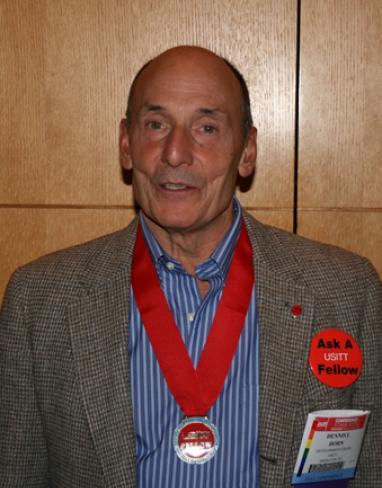

Dennis Dorn
Your earliest memories of the institute…as in how far back do you go?
I first discovered the USITT Midwest Section in 1977 and almost immediately became an active member. It was a great group and we had sessions that featured legendary folks such as Eddie Kook, James Hull Miller, Bob Moody as well as a host of local Chicago-based celebrities. I attended my first national conference in 1980 at a hotel conference site in Kansas City, at the invitation of Jay Glerum who recruited me to join him. This particular conference marked a genuine turning point for USITT and was filled with lots of highlights – perhaps most notably the beginning of discussions about rigging safety and industry-member code involvement. The conference was attended by a number of members who I knew by reputation—industry giants—but whom I had never met before.
Does anything stand out as your favorite USITT memory?
Three things: One, I was awarded the first Kook Research Grant which was used to pursue a project that measured the actual properties of common theater-style platform staging and which resulted in two articles published in TD&T.
Two, I was given another award through the Technical Production Commission that allowed one of my graduate students, Lisa Schlenker, the opportunity to survey “Job Satisfaction Among Technical Directors,” which resulted in articles, speeches and numerous conference panels as well as two follow-up surveys.
Three, the night I was inducted as a Fellow (2000) was the first time I had missed a Fellows Address in over a decade and I missed the opportunity to hear the sterling introduction given by Ben Sammler. I was in the conference computer room finishing up a report for another session. Thanks to an out-of-breath Mark Shanda I made it to the Fellows session in time for pictures.
Short list of your career highlights
Never having even walked on a stage until I switched schools my sophomore year of college, it was my good fortunate to wander backstage at the Memorial Union Theater on the University of Wisconsin campus. There I met a small group of graduate students who welcomed me and involved me in their world, even though I didn’t have any idea of what I was doing. Most of these people went on to have great careers of their own; I was simply in the right place at the right time. John Ezell encouraged me to apply to the Yale School of Drama and following short employment stints at the Guthrie and Yale Rep, I joined the faculties of Amherst College, SUNY-Brockport and then spent 33 years at UW-Madison. The years went fast but I was able to participate in lots of work-related decision-making, serve as technical director and/or set designer for nearly 200 shows, become active in professional organizations and enjoy the experiences of meeting and working alongside many other successful colleagues in my department and across campus. I engaged in some theater consulting, served as University Theatre’s director of theatre for ten years, attended way too many meetings and basked in the careers of my very successful nationally-recognized students and colleagues. Even more importantly I found time to participate in family life (balance is so important), play a role in numerous civic government and service organizations, co-author two books and numerous articles, and create personal as well as professional relationships with future theater artists.
Short list of your various involvement in the institute
Having started at the regional level in 1977, at first I attended the various gatherings and workshops we held; within a few years, I became involved in programming as well. In time I became a board member, office holder (did them all) and maintained that involvement as I started becoming more active in the national. Bob Scales (my boss at the Guthrie) and Rick Stephens who were co-commissioners for Technical Production schemed to create a rolling leadership pattern and approached Ben Sammler and myself to continue the model in the future. This became the pattern most commissions now follow so that we each have continuity and the opportunity to provide opportunity for other members to step into leadership roles. This decision opened other doors and in time I became actively involved in national programming and both Ben and I took on the role of guiding the creation and execution of Tech Expo. We shared duties with the editing of the catalog and collection and assembly of the exhibit for several years before turning it over to the next “generation” of leaders. Shortly after that I was elected VP-Commissions and served two terms, and have over the years been a member of various committees including Awards, Finance, Graphic Standards to name a few. Since 2003 I have served as one of USITT’s representatives on the Entertainment Technician Certification Program (ETCP) Council.
If you were to make a short list of the memorable USITT characters who have made a difference to you, who would they be?
Here’s a tough question, since I have gotten to know so very many people for whom I have such great respect both as professionals and as people. I’ll mention only a few: George Petterson and Glenn Naselius who made me so welcome in the Midwest Section; Jay O. Glerum who got me to my first annual conference; Robert Scales, Rick Stephens and Ben Sammler who played such important roles in my roles with the Technical Production Commission; Bernie Works and Richard Arnold who spanned both my regional and national activities as mentors and friends; Leon Brauner and Mitch Hefter, who are so very kind and supportive; Sarah Nash Gates one of the most generous people I know; Bruce Brockman and Henry Tharp because they always make me laugh; and Mark Shanda and Laura Crow, both of whom mean the world to me.
Anything you want to say about being a fellow?
It is a great honor to be counted among those who have made significant contributions to the entertainment industry and to USITT.
Anything you'd like to add about what the USITT means to you personally?
USITT offered opportunities and opened doors to me that expanded my world vision far beyond mere employment. It allowed my vocation to be, and remain, my avocation throughout my entire career. Furthermore, it made it possible, especially through grants and activities, to develop friendships, initiate careers, and follow the many successes of my students, friends and colleagues.
List of your publications
Drafting for the Theatre, editions 1 & 2 (co-authored with Mark Shanda). Southern Illinois University Press. 2012.
Technical Management for the Performing Arts: Utilizing Time, Talent, and Money. (co-authored with Mark Shanda). Focal Press. 2015.
Mentoring—is there an area that you’d be happy to mentor students, officers, commissions about?
Most of us, always assuming there are a few exceptions to everything, delight in the opportunity to speak with young and older students who are entering our profession. Regardless of who we are, we have wide ranging experiences that should be of some help, contacts that can definitely be of help, and the desire to engage with people who share our passion for what must be one of the most influential fields of employment available. I would certainly welcome such opportunities and would feel most comfortable in the areas of technical production, facilities, personnel, organization, and breweries.


Rich Dunham
Your earliest memories of the institute…as in how far back do you go?
I first learned about USITT in the fall of 1983 as a graduate student at Ohio State University (OSU). We enrolled in both the section and national organizations and started going to Ohio Section master classes/workshops my first year at OSU. Tom Skeleton did a practical series of exercises training us to feel/sense the light at one of those …which I found very memorable and enlightening. My first national conference was 1987 in Twin Cities …..two of us went together ….flew into the city and then picked up a rent-wreck for the week from a shady place in the wrong part of town. I was overwhelmed by the sheer scale of the expo floor and number of sessions that I could participate in. I was hooked and don’t believe that I’ve missed a conference since!
Does anything stand out as your favorite USITT memory?
It’s hard to pick a single memory …..a couple that do stand out include: Sarah Nash Gates making her grand entrance on horseback as our new president one year, back in the days of banquets the wonderful one that we had up in Calgary, but mostly the people and colleagues with whom I have developed so many relationships over the years …many through my work in the Lighting Commission but many others beyond the world of lighting and through my work with the Publications and Grants/Fellowships committees …after all, our business is a people business as much as anything else.
Short list of your career highlights:
- MFA (dual emphasis in Lighting and Scenic Design), The Ohio State University, 1987.
- Lighting and Scenic Designs (400 + Credits) in opera, dance, musical theatre and drama in regional, academic, stock and other productions from community to Off and Off-Off Broadway designs. Notable design credits include: Brunswick Music Theatre (Maine State Music Theatre), The Disney Institute, Music Theatre North, Jean Cocteau Rep, Circle Repertory Lab Company, Broadhollow Productions, The Springer Opera House and The Atlanta Lyric Theatre. NCQLP Certified Lighting Designer in Architectural Lighting and hold member status in IESNA and IALD.
- Author of Stage Lighting: Fundamentals and Applications.
- Two Herbert Greggs Honor Awards
- Professor of Scene and Lighting Design/Head of Design at the University of Georgia (since 2000) with other academic appointments at University of Central Florida, Vanderbilt University, SUNY Stony Brook and Stephens College.
- Becoming a USITT Fellow
Short list of your involvement in the institute
Chair. Grants and Fellowships, Director, Publications Committee, Lighting Commissioner 1998-2006 and a host of VC appointments through the years that led up to that. Several notable highlights include: Chair. of RP-2 Lighting Graphics Standards Committee (2006 revision), editorial roles in the Practical Projects for Teaching Lighting and Scenic Design Compendiums, and judicator for several USITT student awards (Rising Star, Barbizon and Stage Technology Lighting Awards) plus lots of panel sessions.
If you were to make a short list of the memorable USITT characters that have made a difference to you, who would they be?
The list seems endless. When working on securing Distinguished Lighting Designers I got to know many of this country’s top lighting designers ...several of the more notable include: Ken Billington, Richard Pilbrow, Jim Moody, Jennifer Tipton, Beverly Emmons, and Bill Klages. Great institute members that I have had the privilege to work with include: Cindy Limauro and Craig Wolf (they got me involved initially), then many many others …just a few include Randy Earle, Joel Rubin, Tim Kelley, Bobbie Owen, Sylvia Pannell, David and Debra Rodger, Carl Lefko, and Larry Hill. The manufacturers and distributors have also been terrific …Stan Miller and Schwartz, Paul Vincent, Joe Tawil, Jack Schmidt, Mike Wood and Steve Shelley to name just a few. I’ve been lucky in developing an incredible network of friends and colleagues through USITT over the years!
Anything you want to say about being a fellow?
What an honor to be brought into this wonderful group of esteemed colleagues!! So many are people that I have looked up to and admired over the years.
Anything you'd like to add about what the USITT means to you personally?
I’ve been very active through all of the volunteering and positons that I’ve held over the years, yet still feel that I have received more than I have given. A number of my career accomplishments can in some way be attributed to some form of USITT connection. I have met so so many people from all walks of the industry through USITT that are willing to discuss and share their personal knowledge and experience with me. Many of these experiences have developed into strong professional relationships and friendships over the years.
List of your publications (if any)
Stage Lighting: Fundamentals and Applications; (Boston: Allyn and Bacon/Pearson Education, Inc.,2010). 2nd Edition in Progress with Focal Press/Taylor and Francis.
Late and Great American Designers 1960-2010: Bobbi Owens, editor: Chapter Essay on Thomas Skelton; (New York: USITT Publications, 2010).
Approximately a dozen articles in TD&T over the years. Two won Herbert Craigs Honor Awards.
“Performance Design Traditions in India: Where Past and Present Meet,” co-authored with Farley Richmond; Spring 2003.
“Cirque du Soleil Comes to Orlando to Party,” Spring 2000.
USITT RP-2 Recommended Practice for Theatrical Lighting Design Graphics (2006).
USITT Editorial Credits:
- Practical Projects for Teaching Lighting Design, A Compendium (Volume 2). Editorial Team Member and Contributing Author, USITT Publications, March 2016
- Practical Projects for Teaching Scenic Design, A Compendium. Advising Editor, USITT Publications, March 2006
- Practical Projects for Teaching Lighting Design, A Compendium (Second Edition), Editor, USITT Publications, July, 1992, Reprint March, 1996
- Practical Projects for Teaching Lighting Design, A Compendium, Editorial Committee, USITT Publications, August, 1990
List of books that you recommend about the field
Almost any book on lighting that you can get your hands on …..but some standouts without tooting my own horn……
The Magic of Light, Jean Rosenthal
Stage Lighting Design, The Art, The Craft, The Life, Richard Pilbrow
Concert Lighting, James Moody
A Practical Guide to Stage Lighting, Steven Shelley
Photometrics Handbook, Robert Mumm
Syllabus of Stage Lighting, Stanley McCandless
Light Fantastic, Max Keller
The IES Lighting Handbook 10th edition, Editors David DiLaura, Kevin Houser, Richard Mistrick, Gary Steffy
Mentoring—is there an area that you’d be happy to mentor students, officers, commissions about?
Sure anything on lighting (both in the traditional or non-traditional sense), academic theatre, or publishing
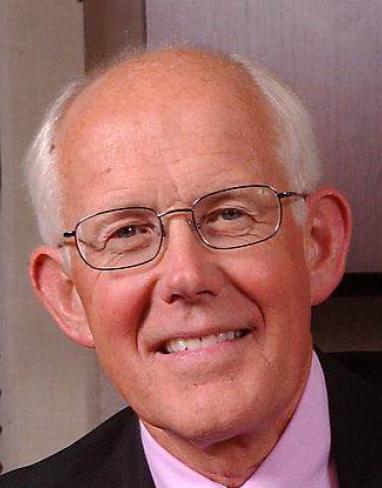

Dick Durst
Your favorite USITT memory?
Sharing a programming session with Will Bellman, when I was three years into teaching. He was so gracious and generous with his time, as we both were doing steel fabrication of scenery – a new initiative at the time.
Short list of your career highlights:
- President of OISTAT;
- scenery design for around 150 productions for regional/academic theatres;
- co-designer of US Prague Quadrennial entry in 1999;
- current College president of Baldwin-Wallace College in Ohio.
Short list of your involvement in the institute:
Several offices in USITT, including VP for Conferences and President; Chair of Northern Boundary section, USITT Fellow.
Short list of the memorable USITT characters that have made a difference to you:
Larry Hill, Lance Brockman, Jean Montgomery, Christine Kaiser, Leon Brauner, Dick Devin.
Anything you want to say about being a Fellow?
Highest recognition I’ve achieved from USITT. I am humbled to be in the company of these folks.
Anything you'd like to add about what the USITT means to you personally?
Not enough space to do this justice. Most of my best friends in life have come through USITT.
List of your publications (if any):
Too many and too many that I’ve forgotten.
Is there an area that you'd be happy to mentor students, officers, commissions about?
Always. President, VP conferences, regional sections, and careers OUTSIDE of live theatre.
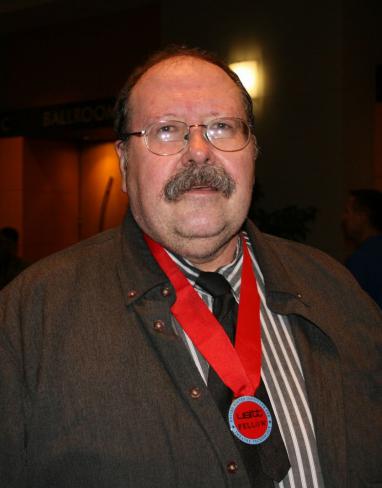

Eric Fielding
Favorite USITT memory?
It would have to be attending the 1978 OISTAT Congress in Hamburg, West Germany. My wife and I had only been married for a few weeks when we traveled to Europe. It was my first trip there. While we visited much of Western Europe during our five-week Eurail-Europe-on-$5-a-Day trip, there were three main things I wanted to do: see theatre in London, visit Prague (and hopefully meet my hero Josef Svoboda!), and attend the OISTAT World Congress (which I had learned about through TD&T). London theatre was even better than I had imagined; Prague was wonderful (although I didn’t get to meet Svoboda, I did start a life-long friendship with Jarmila Gabrielova at the Theatre Institute, home of OISTAT and the PQ); and attending the OISTAT Congress changed my life (and I finally got to meet Svoboda!).
It turned out that there were only a handful of USITT members in Hamburg. In fact, when I attended the Scenography Commission meeting, I was the only American there. While I was fresh out of grad school, I was embraced by the commission members that included such international design luminaries as John Bury, Ladislav Vychodil, Adam Killian, Otto Kahler, and Ichiro Takada. Largely by default, I was elected vice-commissioner for North America. This experience was perhaps the most influential of my professional career.
While I have been involved in a variety of roles and activities in USITT over the past three-plus decades, my main focus has been in activities related to the International Activities Committee and the Institute’s role as the US OISTAT Centre.
Career highlights?
- Design Faculty/Resident Set Designer, Department of Theatre, Brigham Young University [1976-83, 1992-present]
- Design Faculty, Goodman School of Drama, DePaul University [1983-86]
- Editor/Art Director for USITT Periodicals: TD&T, Sightlines, Directory [1988-95]
- Freelance Designer [1971-present]
- 250+ plays, musicals, operas, concerts, pageants, events, films, and television productions for such companies as the Utah Opera, Tuacahn, Utah Shakespeare Festival, Pioneer Theatre Company, Colorado Shakespeare Festival, Denver Center Theatre Company, Sundance Theatre, Ririe-Woodbury Dance Company, Osmond Studio, and the LDS Church.
Short list of your involvement in the institute?
- Vice President for Communications (1999-2002)
- Scenic Design Commissioner (1986-88)
- Board of Directors (1983-87)
- Associate Chair of International Liaison Committee/US OISTAT Centre (1985-97)
- OISTAT Publications & Communication Commission Chair (1991-1999)
- OISTAT Scenography Commission Vice-Chair—North America (1978-1987)
- World Stage Design 2005 Producer/Director (2001-2005)
- Delegate, delegate tour director, exhibitor, exhibit designer, catalog editor/designer, and/or documentarian for every Prague Quadrennial since 1979.
Short list of the memorable USITT characters that have made a difference to you:
- Joel Rubin
- Ned Bowman
- Pat MacKay
- Randy Earle
- Dick Devin
- Chris Kaiser
- Helmut Grosser
- Don Stowell
- Stephen Hild
- Richard Hay
- Leon Brauner
- And….etc., etc.
What does the USITT means to you personally?
For more than three decades, USITT and OISTAT have provided me with a wealth of opportunities for education, service, personal growth, and interaction with some wonderful friends and colleagues. At the same time there have been challenges and painful experiences and relationships. But I am humbled and honored to have been recognized multiple times by the Institute including the USITT Founders’ Award [1992], election to the Fellows [1992], and the USITT Lifetime Member Award [2008].
Your publications:
- Editor/Art Director for USITT Periodicals: TD&T, Sightlines, Directory [1988-95]
- Editor/Art Director for USA/PQ Catalogs [1991, 1995, 1999, 2003]
- Editor/Art Director for World Stage Design 2005 [print & digital catalogs]
- Editorial Coordinator & English (US) Language Editor for New Theatre Words [1995]
- Various articles for Theatre Crafts, TD&T, Sightlines, and Live Design.
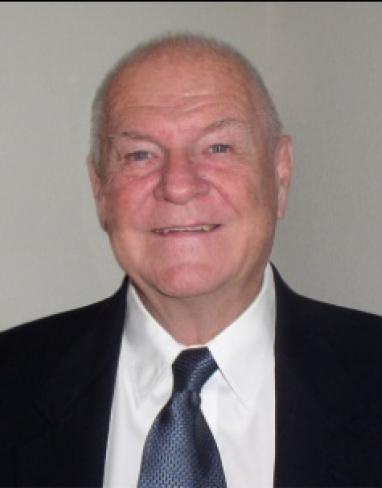

David Hale Hand
Favorite USITT memory?
The Conferences and the many friends I made were my second family. Wonderful times.
Short list of career highlights:
- Degree in Theatre and Communications from the University of California at Santa Barbara
- Worked in New York in theatre, film and television for five years
- Taught technical theatre at Colorado College (13 years)
- President and CEO of Stage Engineering International, Ltd. (26 yrs.), providing services domestically and internationally
- President and Principal Consultant for Theatre Development Associates
- Principal designer and a department supervisor for Walt Disney Imagineering working on Disney’s Parks in California, Florida and Paris.
- Active in development of several major international destination resort projects through my companies David Hand Productions & Gateway Central.
Short list of your involvement in the Institute:
- Co-organizer of the Rocky Mountain Section (1973) and was its Chair until elected to the USITT BOD shortly thereafter.
- Co-Chaired the first National Conference in Denver.
- Board of Directors member for a number of years
- VP for Conferences for, I believe, 6 years.
- USITT President, 1986 - 1988
- Fellow, 1988
Memorable USITT characters who have made a difference to you?
There are too many to count. Certainly Joel Rubin, Sarah Nash Gates, Randy Earl, Will Bellman, Lee Watson, Pete Happe, Tim Kelly, Randy (Dr. Doom) Davidson and so many, many more.
Anything you want to say about being a Fellow?
Though I have been inactive for a number of years now, I value the prestige of being a Fellow and keep my membership so I can be a part of that group.
Anything you'd like to add about what the USITT means to you personally?
Being a member has been one of the most important and valuable experiences of my life.


Mitch Hefter
A favorite USITT memory?
Certainly being inducted as a Fellow and receiving an Honorary Lifetime Membership are at the top of the list of USITT memories. Another memory - somewhat ironic - is when I received the Founders Award with Fellows Ken Vannice and Steve Terry: None of us was able to attend the 1993 conference. This was the days before e-mail and award recipients were still kept a secret until the event, so we had no idea. Fellow Rick Stephens called me a few weeks after the conference and said we should get together for lunch. When we did, he presented me with the award.
Short list of your career highlights:
- I have worked in Entertainment and Architectural Lighting Controls my entire career - at Strand Lighting, EDI, Entertainment Technology, Genlyte (Lightolier Controls), and Philips Lighting.
- As part of the work of the USITT NEC Committees, we have proposed a number of changes to make the NEC current with the advancing technology in the entertainment industry. This also included dealing with an issue at the 1984 Olympics and single-conductor feeder cables and working to allow variations in requirements so broadcasting in some venues could happen.
- Became a member of NEC Panel 15 in 1997.
- One of the founding members of ESTA's Technical Standard Program.
Short list of your various involvement in the institute:
- Several terms as Engineering Commissioner
- Board of Directors
- Bylaws Committee in 2010.
A short list of the memorable USITT characters?
A short list of favorite USITT characters (emphasis on 'characters') is not possible.
Anything you want to say about being a Fellow?
Being inducted as a Fellow was one of the highest honors of my careers. Being part of a group of industry leaders who are great mentors and readily share the experience and knowledge is a wonderful experience.
Anything you'd like to add about what the USITT means to you personally?
USITT is a second family to me. I look forward to attending the Annual conference every year to reconnect with friends I may not have seen for a year. But sometimes it feels like we saw each other just a few weeks earlier.


Ken Hewitt
Joined USITT in 1974, and attended his first USITT Conference at the Waldorf Astoria Hotel in New York.
1980 - was a co-founder of “CallBoard”– a computer based communications network for theatre technicians in Canada that pre-dated the Internet and eventually came to serve USITT members across North America.
1984-1988 – member of USITT Board of Directors.
1989 – Chaired the USITT Annual Conference in Calgary, Alberta.
1993 – left theatre world to pursue career in advanced internet development based at University of Calgary.
2008 – retired from UCalgary and moved to Canmore, Alberta where he currently resides with his wife of 32 years, Raylene.


Christine Kaiser
Your earliest memories of the institute…as in how far back do you go?
First conference - 1977 Washington DC; First year as conference exhibitor 1981; First office - Director at Large +/-1986. I don't remember much except for the building and Stage Expo, such as it was, from the 1977 conference. My first memory of anything substantial was the Fellows Address at the 1979 conference in Seattle. I wondered how USITT Fellows came about and was curious about the Fellows that were at that event.
Does anything stand out as your favorite USITT memory?
I can clearly remember my extra ordinary personal challenges in attempting to connect my first modem to my home computer and connect to the USITT electronic discussion board- something I had to do quickly so that I could I participate in then USITT President Dick Devins's new communication method for the USITT Executive Committee. I wasn't alone in being pressed to improve my computer capabilities and it served many of us well in our futures, even though getting there was truly tough going.
I also remember a very, very cold snowy Syracuse day. The USITT Finance Committee was meeting in Syracuse at the Kaiser house. Our golden retriever visited the guest room and retrieved a jewelry bag belonging to then Finance Committee chair Sarah Nash Gates. The dog transported the bag through her dog door to the fenced side yard. Fence gates don't work with lots of snow. Somewhat dressed for the occasion and "supervised" by the USITT National Office bookkeeper, over the fence I went - snagging my trousers on the fence top. The bookkeeper went for help and after I picked up the well-eaten cloth bag, I had assistance to climb back over the fence. It was a sight to behold, and a string of pearls and some other contents of the bag were found occasionally in the yard in the ensuing years.
Short list of your career highlights
Syracuse Scenery & Stage Lighting Co., Inc. first employed 1971, Vice President 1978, President and CEO 1984 - current.
Short list of your various involvement in the institute
Director at Large +/-1986
Treasurer 1988 - 1996, 1998-2001
President 1996-1998
Anything you want to say about being a fellow?
I was and am totally honored to be among a group of folk who have supported the technical performing arts community and the Institute with such talent and dedication.
Mentoring—is there an area that you’d be happy to mentor students, officers, commissions about?
Anywhere that I could be helpful.
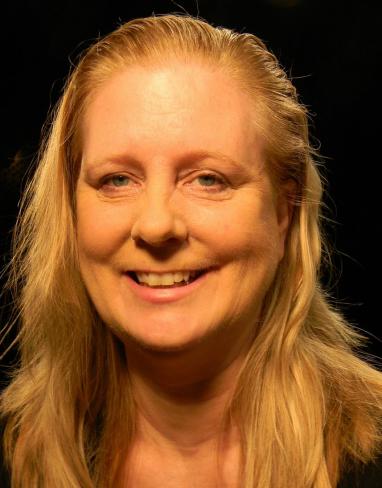

Elynmarie Kazle
Does anything stand out as your favorite USITT memory?
My favorite actual memory is the first time I walked out on stage for the Seattle New Products Showcase, it rather fulfilled my fantasy of being famous – my 15 minutes as it were. My favorite memory ( as I imagine it in my mind) because I was not present, was when I was named a fellow .
Short list of your career highlights?
- Stage Manager for 30 plus years dance, theatre and opera including Brooklyn Academy of Music;
- 10 yrs touring internationally with Paul Linke and Time Flies…, Ohio Ballet, San Diego Opera and Great Lakes Shakespeare to name a few;
- Established and ran the West Coast Office of the stage directors and choreographers union;
- Working on Bent with Martin Sherman at the Coast Playhouse;
- Working with Derek Walcott and Galt MacDermot on Joker of Seville in Graduate School;
- Founding committees of both the Arts Alive Awards (Akron) and the Ovation Awards (Los Angeles);
- Founder of the USITT Stage Management Mentoring Project;
- Mentored students in the Firestone Visual and Performing Arts Program for the past ten years;
- Produced theatre in Los Angeles for over 10 yrs.
- Other career highlights: working with director Geoff Bullen; meeting Richard Pilbrow, Jennifer Tipton and Ming Cho Lee; working and being friends with Tom Skelton; working with Robert Wilson, Andrew Feigin and Beverly Emmons; being a member of the Stage Managers Association; and, getting to know Cindy Poulson.
Short list of your involvement in the institute?
- Served on the Board almost four full terms—two terms wo as a director at large and almost two as VP Membership and Development;
- Served on 7 conference committees
- In Boston, started Stage Management Mentoring Project);
- For the Seattle conference --revived New Products Showcase;
- Expanded the Young Designers and Technicians scholarship program as VP Membership and Development;
- Served on Finance, Publications, Membership, Grants and Fellowship, and Management Commission.
Short list of the memorable USITT characters that have made a difference to you?
Leland Watson, David Fleming, Ron Olson, Pat MacKay, Bill Byrnes, Geno Montgomery, Dick Durst, Larry Hill, and Christine Kaiser.
Anything you want to say about being a fellow?
It rocks. Like having your kids young (which I did not) because I AM the youngest Fellow.
Anything you'd like to add about what the USITT means to you personally?
Best leadership training in the world. Best friends on the planet.
List of your publications (if any)
Ohio Network newsletter (five years) and articles in Sightlines.
Mentoring?
Of course!
Elynmarie Kazle is a multidisciplinary artist, director, stage manager, and management consultant based in Akron, Ohio. She serves as the Production Manager for the Akron School for the Arts, bringing her extensive experience to the next generation of artists.
Kazle’s professional theatre career began in Ohio, where she stage managed for notable companies including Great Lakes Theater in Cleveland and Opera Columbus. Her journey led her to Southern and Central California, where she worked with prominent organizations such as the Old Globe Theatre in San Diego, LA Classical Ballet, and Santa Monica Playhouse. Her New York City experiences include collaborations with Brooklyn Academy of Music (BAM), Playwrights Horizons, and several solo international tours.
Having transitioned into directing and production management, Kazle now regularly consults for nonprofits across the country, specializing in organizational management and fundraising.
She has directed 15 plays, including The Revolutionists, On the Verge, Four Women Talking About the Man Under the Sheet, and the premiere of Trial by Fire by Eric Mansfield, a play on book banning. This past fall, she also directed Harry Potter and the Cursed Child.
Kazle has contributed to the theatre community as a chair for symposia and conferences, and designed stage management programs for institutions like USITT, LDI, the Southeastern Summer Theatre Institute, and Scouting America. As chair of the Stage Managers’ Association (SMA) for 8 years, she played a key role in creating the National Collaborators Conference, the first arts conference to go virtual during the pandemic. She currently serves as the President of the Foundation for Stage Managers, a role she has held since 2022.
An advocate for better working conditions in the arts, Kazle was a founding member of NoMore10outof12s.com, a national initiative focused on improving labor conditions for nonprofit theatres. She has also served as a Scout leader for over 20 years, supporting Troop One BSA, Girls 7001, and Crew 3001, as well as the Great Trail Council.
A Member of USITT for over 40 years, Kazle has received numerous honors, including being named a Fellow of USITT in 2007 and inducted into the National Theatre Conference in 2017. She was also recognized as an honorary Thespian by Firestone's Troop 5570. In 2023, Kazle received the Joel E. Rubin Founders Award and the SMA Founders Award in fall 2022. She was also honored with a citation for special service to the Weathervane Women’s Board in 2007. In May 2024, she received the Arts Alive Award and a certificate of special congressional action from Congresswoman Emilia Sykes for her contributions to theatre in Northeast Ohio and nationally.
Three things you might not know about Elynmarie: She’s flown a plane, served as a cultural ambassador to Sweden, and had an unexpected backstage encounter with playwright Arthur Miller at the National Theatre in London.


Rachel Keebler
Your earliest memories of the institute?
Have been a Member since 1989, but I believe I went to a convention in Boston before that.
Going to Long Beach and wondering if there were any other Scenic Artists there!! It did not seem that there were very many.
Your favorite USITT memories?
Having Lance Brockman “drag” (invite?) me onto a stage at a Masonic temple before I knew anything about them!! (Did he really think I would say something intelligent?)
Seeing our backdrops all hung up the year Cobalt got the Education Award.
Career highlights:
- Charge painter/scenic artist at numerous regional reps and professional scenic studios. Lots of summer theatre!
- Co-Founder, Director and Sole Owner of Cobalt Studios, Inc. Founded in 1988 where I continue to run the Summer Scene Painting Studio.
- Guest Teacher/Master Class Instructor at North Carolina School for the Arts,Temple University, University of Michigan/Kalamazoo, Rutgers University, Hong Kong Academy of Performing Arts, SUNY Fredonia, University of Michigan/Kalamazoo, University of Tennessee/Knoxville, Denver Theatre Center,University of Illinois/Urbana-Champaign, and at numerous USITT Seminars .
- 2013 Boston University Award of Excellence
- 2013, USITT Education Commission Special Citation to Cobalt Studios
Your involvement in the institute?
- Member, USITT/ since 1989
- Director-at-Large/2001- 2004
- Membership Committee/2004-2006
- Adjudicator, USITT National Young Designers Forum/1998
A short list of USITT members that have made a difference to you?
Sorry, not short, and getting longer each year and not necessarily in order of significance: Howard Jones, Lance Brockman, Kimb Williamson, Bob Scales, Larry Hill, Elynmarie Kazle, Barbara Lucas, Mary Heilman, Pat MacKay, and Richard Pilbrow
Anything you want to say about being a fellow?
Please stand by….
Anything you'd like to add about what the USITT means to you?
The support it gives both me and Cobalt continues to expand! The folks I have met through the Institute are as tenacious as the ones I worked with in Summer Stock - wonderful and treasures in my life.
Your publications:
Articles in The Painters Journal, interviews in Stage Directions and Scenic Art for the Theatre’ and I wrote the forward for Sherwin’s Scene Painting Projects for Theatre.
Books that you recommend about your field:
Designing and Painting for the Theatre by Lynn Pecktal
Scenic Art for the Theatre by Susan Crabtree and Peter Beudert
Notes on Scenic Painting by Bradford Ashworth
And for teachers of beginners: Scene Painting Projects for Theatre by Stephen Sherwin
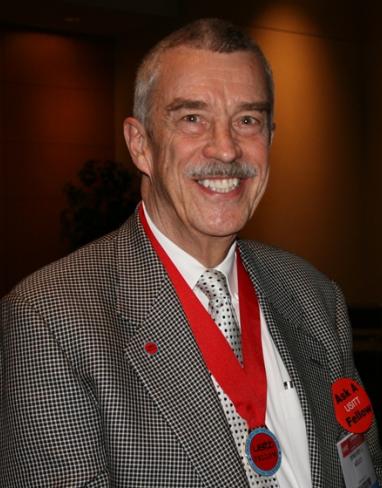

Tim Kelly
Your earliest memories of the institute…as in how far back do you go?
- I was introduced to USITT by Dave Hand when we started the Rocky Mountain section in about 1979? My first conference was in Seattle in 1979.
Does anything stand out as your favorite USITT memory?
- I was pretty fond of the houseboat in Corpus Christy in 1983
- I was not very fond of the meal in Kansas City in 1980
- Our dinner group “Panache” was always festive and the meals toothsome and enjoyed by: Pat MacKay, Ralph Pine, Debora Dixon, Sarah Nash Gates, Peter Sargent, Lewis Crickard, Tim Kelly
Short list of your career highlights
- 2 1/2 years as Technical Director US Army theatre Vicenza Italy
- 10 years as Technical Director Bonfils Theatre
- 30 years as Director of Facilities Management Denver Center for the Performing Arts
- Owners Representative Bonfils Foundation Denver supervising over $35,000,000 in construction projects
Short list of your various involvements in the institute
- Founding member of the Rocky Mountain Section
- RMUSITT Section Officer
- Conference Co-chair Denver 1982
- USITT Board of Directors mid-eighties
- VP for Relations late eighties
- Chair Grants & Fellowships a very long time
- Fellow 1995
- Founder’s Award 1999
If you were to make a short list of the memorable USITT characters that have made a difference to you, who would they be?
- The list would not be short but it would include: Eddie Kook, Don Shulman Sam Scripps, Dave Hand, Randy Davidson, Leon Bruner, Dick Arnold, Dick Durst, Dick Devin,………and more
Anything you want to say about being a fellow?
- To me it is living in rarified air! I am greatly humbled by being a Fellow alongside many people who have defined theatre in America.
Anything you'd like to add about what the USITT means to you personally?
- As a member of USITT I have been encouraged to want a leadership role not only in my profession but in many aspects of my life. Through Board and Committee service I have learned business management, and patience, that I would not have learned anywhere else.
Mentoring—is there an area that you’d be happy to mentor students, officers, commissions about?
- I would be pleased to mentor in the area of Board Service, career advancement and personnel management skills.
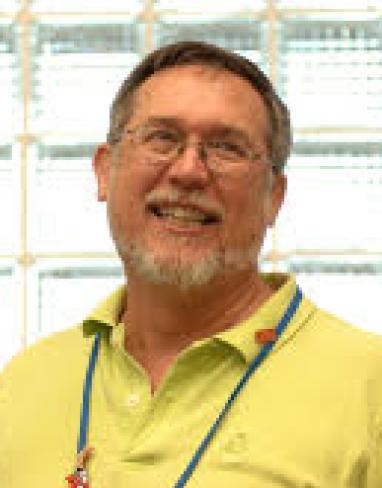

Carl Lefko
Professionally, Carl has designed a national tour of Eugene O’Neill’s The Emperor Jones and several shows for Mill Mountain Theatre. Throughout his years at Radford University he has served the department, college and university in various capacities. Carl led the University Planning and Budget Committee for two terms and has served on the Executive Council of the University Council of Chairs since its inception. He was named chair of the Department of Theatre and Cinema in 2004. Upon the creation of the School of Dance and Theatre in 2008, he was tapped to lead it as its director.
In addition to being a valued member of the RU community Carl has been very involved in the United States Institute for Theatre Technology (USITT) since 1985. For USITT he has held the offices of Treasurer, Vice-Chair and Chair for the Southeast Section. He has worked extensively with the USITT Conference Committee culminating in three two-year terms as Vice-President for Programming ultimately serving as the Institute’s President from 2008-2010. Carl was named a Fellow of the Institute in 2009 in recognition of his outstanding contributions to the theatre and his service to the Institute. He is also an active member of Southeastern Theatre Conference (SETC). During his stint on SETC’s Editorial Board he created the “Outside the Box” column for Southern Theatre magazine. This serial feature is a forum for discussion of innovations in Theatre design and technology. Carl is a longtime supporter of The Virginia Theatre Association. Community service includes his membership on the Radford Tourism Board where he now serves as their Chair. He holds a MFA in Design and Technical Direction from UNC-Greensboro.
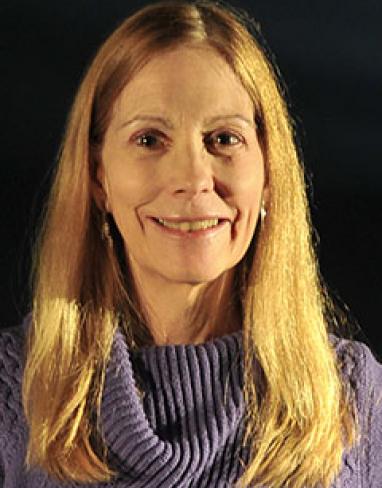

Cindy Limauro
Your earliest memories of the Institute?
I joined USITT in 1983 as a young assistant professor. People like Leon Brauner and Jim Moody were there to mentor me. Leon was especially responsible for my active involvement in the commissions.
I can’t begin to name all of the wonderful people I have met over the years who have enriched my life both personally and professionally.
I’ll never forget the first time I met Richard Pilbrow. His book, Stage Lighting Design, was my first introduction to the art of lighting.
Favorite USITT memories?
As Head of the Lighting Design Commission, I am most proud of introducing hands-on lighting sessions to USITT. I started the first “Light Lab” back in 1989 at the Calgary conference with 4 booms and some Lekos. It is great to see how it has grown over the years!
I also established the “Distinguished Designer Series” in 1997 as a way of providing an in-depth look into the lifetime careers of distinguished lighting designers. Early recipients included Tom Skelton, Imero Fiorentino, Jennifer Tipton, Abe Feder, Ken Billington, and Jules Fisher.
Some of my favorite panels include: the amazing Dance Lighting session with Jennifer Tipton in Boston, where we watched her light a new dance piece performed by a professional company; Video Lighting with Jim Moody; Opera Design with Gil Wechsler, Neil Peter Jampolis and Dawn Chiang; and the special Finnish Lighting Installation: Shadow Takes a Walk.
Career highlights:
- Professor of Lighting Design at Carnegie Mellon University
- Design Partner in C & C Lighting, designing for theatre, opera, dance and architecture Member of United Scenic Artists
- Member of International Association of Lighting Designers
- Fellow of USITT
- Major architectural lighting design projects include the Gulf Tower, Fifth Avenue Place, the Hunt Library and the Randy Pausch Memorial Bridge in Pittsburgh.
- Theatrical designs include productions with the Pittsburgh Opera, Baltimore Opera, Opera Columbus, Pittsburgh Ballet, Cincinnati Ballet, Maryland Ballet, Burt Reynolds Jupiter Theatre, Barter Theatre, Pittsburgh Public Theatre, Quantum Theatre, City Theatre, August Wilson Center, Pittsburgh Symphony and Teatro Dell’Orologio and Teatro Vascello in Rome.
- Recipient of three Nuckolls Education grants to teach architectural lighting at US universities.
- Recipient of Henry van de Velde Award for Architectural Education in Antwerp for interdisciplinary design education .
- Featured speaker at a Design Symposium in China, Lightfair International, LDI, Prague Quadrennial.
- Design work displayed at PQ 2007 and World Stage Design in Toronto in 2005.
Short list of your various involvement in the institute:
- OISTAT Education Commission – USITT Representative 2005-2010
- USITT Board of Directors, 1996-2002
- Lighting Design Commission Liaison to the International Committee, 1994-1996
- Head of the Lighting Design Commission, 1989-1994
- Lighting Design Vice Commissioner, 1987-1989
- Lighting Commissioner Ohio Section, 1985-1987
Short list of USITT characters who have made a difference to you:
At the top of the list would have to be Sonny Sonnenfeld followed by Richard Pilbrow, Joe Tawil, Jim Moody, Leon Brauner, Pat MacKay, Bill Warfel, Craig Wolf, and Michael Ramsaur.
About being a fellow?
It is such a great honor to be named a fellow in recognition of my accomplishments and to be in the company of so many other talented people.
What the USITT means to you personally?
Being a part of USITT has enabled me to be connected to the educational theatre community and to meet people I never would have met otherwise.
My lighting designs have been published in:
- Scene Design and Stage Lighting by W. Oren Parker and R. Craig Wolf, editions 1990-2002;
- Scene Design and Stage Lighting by R. Craig Wolf and Dick Block, editions 2002-2014;
- Stage Lighting Fundamentals and Applications by Richard Dunham 2011;
- Lighting the Stage, Art and Practice by Williard F. Bellman, 3rd edition 2000
I have been featured in these publications:
- “Born to Do This,” feature article in Mondo Arc Magazine, April 2015;
- “Architecture Students See the Light” SSL Architecture Magazine, October 2014;
- “Bridge of Shows,” Lighting and Sound America, May 2012;
- “Randy Pausch Memorial Bridge Lighting,” Lighting and Sound America, June 2012;
- “Partners in Light,” Lighting and Sound America, October 2008;
- “5 Remarkable Women in Theatre,” Stage Directions Magazine, March 2006;
- Profile of professional and academic lighting career, Lighting Dimensions Magazine, January 2001
Books that you would recommend:
- Stage Lighting Design by Richard Pilbrow
- Magic of Light by Jean Rosenthal
- The Art of Light and Architecture by Mark Major, Jonathan Speirs, Anthony Tischhauser
- Light Fantastic by Max Keller
- Scene Design and Stage Lighting by R. Craig Wolf and Dick Block
- A Practical Guide to Stage Lighting by Steven Shelley
Mentoring?
I am happy to mentor in the area of lighting design or general career advice.


Pat MacKay
Your earliest memories of the institute…as in how far back do you go?
- Barbizon Plaza Hotel -- 1970 Conference when then USITT president C. Ray Smith brought me along to meet the assembled luminaries. At the time I was editing Jo Mielziner’s The Shapes of our Theatres for C. Ray and writing for Theatre Crafts—time to meet the makers and shakers!
Does anything stand out as your favorite USITT memory?
- PQ 83 was the most fabulous experience ever…A great gang of people –our fearless leader was Eric Fielding. First stop was London where we laughed ourselves silly at the premiere production of “Noises Off”. Then off to Prague (where menu darts was invented) followed by Bratislava for the Opening Night of “L’Elisir d’Amore” where eau d’moth balls emanating from fur wraps just taken out of storage was the overwhelming fragrance. And then…well..Vychodil’s homemade wine (or was it something stronger?) capped the whole evening.
Short list of your career highlights
- Editor and Publisher of Theatre Crafts magazine which became TCI
- Editor and Publisher of Lighting Dimensions magazine
- Founder LDI, the Lighting Dimensions International conference and trade show
- Combined all into Entertainment Communications Group which also published newsletters, ran seminars, acquired Cue magazine, contracted to the USITT to manage the trade show portion of the conference for several years.
- Created ETECH the industry’s first digital information portal (before the Mozilla browser had even been invented)—oh, the arrows in my back.
- Author of numerous articles and books
- Producer of location-based and themed entertainment projects globally.
Short list of your various involvement in the institute
- Theatre Architecture Slide File co-edited with Leslie Armstrong (she got the Founder’s award for the project in 1976)
- Board of Directors multiple terms in the 1970s and part of the 1980s
- Co-chair of the 1974 New York conference with Bob Benson, committee work for the 1985 New York conference, and assorted New York Section positions.
- Publications committee-- various stints
- Stage Expo management of the 1990 Milwaukee, 1991 Boston under a two year contract.
- USITT Health and Safety Award
- International Committee and OISTAT work including
- Co-chair with Joel Rubin of the 1987 Golden Triga winning PQ exhibit and catalogue preparation and publication
- Delegate to Warsaw OISTAT Congress
- Delegate to OISTAT publications commission in Budapest
- USITT Fellows Make It So Committee with Chris Kaiser, Tim Kelly, Dick Devin, and Bob Scales
If you were to make a short list of the memorable USITT characters that have made a difference to you, who would they be?
- For personal impact: Joel Rubin, Ned Bowman, C. Ray Smith, and Bob Scales
- For always-a-great-costume: Dr. Doom, Lee Watson, and Peter Sargent.
- For general hilarity: Eddie Kook, Sarah Nash Gates, Sylvia Hillyard Pannell, Eric Fielding, Pete Happe, and Tim Kelly
Anything you want to say about being a fellow?
- Never so surprised in my life when at a party at a Disco during the 1985 conference my name was called out. I really thought that they only let boys be Fellows. Turns out I was actually the second female fellow, Peggy Clark Kelly being the first. It was, and continues, to be an amazing honor. Thanks to all.
Anything you'd like to add about what the USITT means to you personally?
- My greatest friends and best memories are deeply woven into the fabric of all my USITT activities. Ultimately everything that I accomplished in my professional life grew out of my early work with the Institute on behalf of Theatre Crafts magazine.
List of your publications (if any)
- Many over the years in various magazines and reprinted in anthologies.
- To Boldly Go (Behind the Scenes at Star Trek: The Experience),
- The Art of the Abraham Lincoln Presidential Library
- The Shakespeare Complex co-authored with Glenn Loney
- Most recent project in this field is Walt Disney Concert Hall/The Backstage Story with Richard Pilbrow
Mentoring—is there an area that you’d be happy to mentor students, officers, commissions about?
- Figuring out what to write, how to organize it, and getting published. Of course I can also run a trade show and organize seminars and workshops. Anything International or OISTAT related.
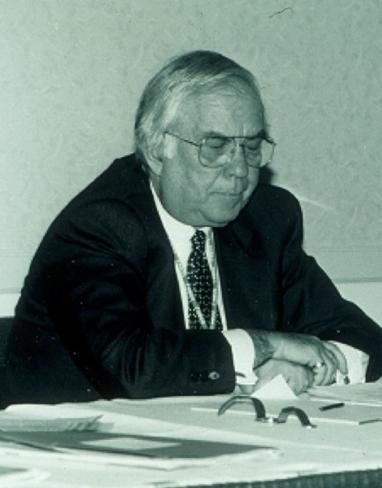

Stan Miller
Your earliest memories of the Institute?
My earliest memories are of interminable New York City USITT Board meetings. I was not on the Board, but participated in some of those earliest meetings, worrying about whether USITT could raise enough money to go forward and what was the money to be used for. There were many, many Board meetings, including participants Tom DeGaetani, Kliegl and Strand personnel. I was very impressed that these people were so committed to USITT, especially Joel Rubin.
Favorite USITT memory?
In 1985 I was honored to receive the USITT Award. This is the highest honor given by USITT and recognizes a lifetime of distinguished contribution to the performing arts or entertainment communities in any capacity. Ned Bowman, a past USITT President, was a Rosco employee at that time and introduced me with his droll wit. Ned wrote a proclamation that accompanied this award that hangs on my office wall today. This presentation was especially memorable to me as it took place at the 1985 USITT Conference in New York. Here was a kid who had been selling dyes in Brooklyn, who bought a company at the age of 26 - not a theatre person, being honored with the United States Institute of Theatre Technology Award.
The citation reads:
Whereas he has skillfully headed a firm which, for over 25 years, has purveyed always useful and frequently innovative products for theatre, television and film; freeing American theatre during that period from the tyrannical yoke of British color filter imperialism; and whereas his wisdom and sage advice are regularly sought by theatre persons playing roles great and small; and whereas he has quietly and thoughtfully helped many young theatre practitioners (and not a few older ones) through introduction, through informal counsel and in other matters of career development; and whereas his efforts the make the theatre environment less unhelpful deserve recognition by their beneficiaries and whereas he has been a quiet friend to the Institute for over two decades, ever ready to pay his sustaining membership in advance during USITT's darkest fiscal years; and whereas he has consistently furthered the development of theatre production through the unparraled marketing skills imaginatively employed in many countries throughout the world,
Now therefore, we the Board of Directors do award
STANFORD MILLER
its USITT award for outstanding service to the American Theatre.
New York City, March, 1985
Randy Earle, Jr., pres
Career highlights:
Just one well-worn business card...
Rosco Laboratories, Inc. 1958 to present. Current position - Chairman.
USITT characters who have made a difference to you?
Joel Rubin, Tom Lemons (still a very good friend today), Peter Sargent, John McGraw, Ned Bowman (Rosco was his part-time job) and Jenny Kenyon - now a USITT Director and who is very involved with her scene painting constituents.
About being a fellow?
Being a USITT Fellow is an honor, and also a responsibility. Today there is less concern about the continued stability of the organization. Fellows need to continue to participate in the activities of the Institute and continue to find the best ways to continue the programs and work of the Institute.
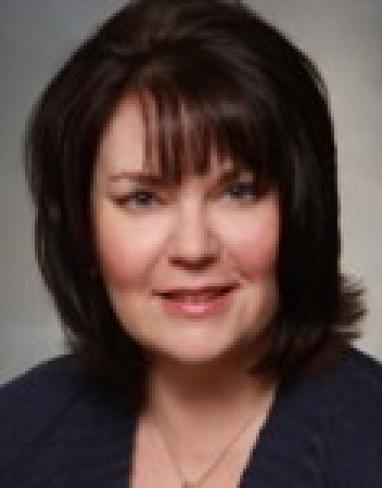

Margaret Mitchell
Margaret Mitchell has been an active member of USITT since 1988 when she joined the institute as a graduate student. In 1991 she was part of the student team who built the USA National Exhibition for the PQ. She has also served on the PQ organizational team twice, and she has given many conference presentations related to international initiatives and the history of stage design. Ms. Mitchell has designed costumes and scenery professionally for over 30 years, and she is a Professor Emerita of Theatre Arts at the University of the Incarnate Word in San Antonio, TX. She holds a B.A. in Theatre Arts from Texas Wesleyan University and an M.F.A. in Costume Design and Technology from the University of Texas at Austin. Ms. Mitchell's design work has represented the United States at the Prague Quadrennial three times and has been exhibited at World Stage Design. Recently her costume designs have been included in exhibitions at El Centro Nacional a Bellas Artes in Mexico City and at the Bucharest World Costume in Action Exhibition in Romania. Her costume designs are included in the permanent collection of the Robert L. B. Tobin Theatre Arts Collection at the McNay Art Museum. Ms. Mitchell serves on the Board of Directors of USITT (United States Institute for Theatre Technology) and has served for many years on the International Committee and on the Publications Committee. She is a General Editor (and has served as a guest editor) for TD&T. She is the Vice Chair for Research for the Costume Designers of OISTAT. With Oscar Brockett and Linda Hardberger, she is a co-author of Making the Scene: A History of Stage Design and Technology in Europe and the United States. She was one of the keynote speakers for USITT’s 50th anniversary conference. In 2022 Ms. Mitchell became a USITT Fellow.
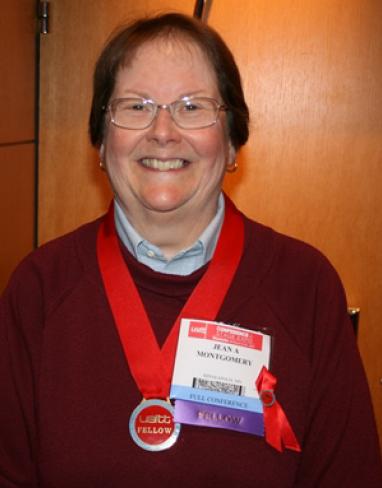

Jean Montgomery
Your favorite USITT memories?
I was sitting in an empty room post meeting in Calgary working on something and gradually folks dropped by – we all started chatting and ended up re-inventing the Institute’s corporate structure. And we did it all again in 2008.
I like that we don’t stand still and are willing to change and grow.
I like that I can look at the election ballot and not know anyone on it – I see that as progress and hope for the future – people willing to pick up the Institute banner and carry it forward.
Some career highlights:
- Forty years teaching, working, and designing with colleagues at the University of Minnesota should about cover highlights--although escapes to Meadow Brook Theatre in MI and various theatres in MN were great.
- One glorious summer spent in Fredericksburg VA in my alternate career as PSM was eye-opening and gave me some real insights into what I was teaching.
- Above all, the friends made through various locations and all facets of the theatre – backstage, onstage, control booths, shops, and front offices – priceless!
- And I got to build two theatre buildings and a boat!
Short list of your involvement in the USITT:
- Member of the Finance Committee 1987-2009
- Conference Policy Committee from 1992 until it was dissolved in 1995
- Secretary of USITT from 1989 to 1997 which made me chair of By-Laws and Nominations Committees
- Served on the Board of Directors from 2001—2006
- Inducted as Fellow 1995
- Received the USITT Founders’ Award 1997
- Continue to serve on the Archives and Bylaws Committees
- Keeper pro tem of the Policies and Procedures Committee
- Honorary Lifetime Membership 2012
- Active in Northern Boundary Regional Section as Secretary (1982-92), Treasurer, (1988 -- ) and Pro tem (2001--2004, 2005-2006).
Memorable USITT characters who have made a difference to you:
- Sarah Nash Gates for her willingness to stand as the first woman president of USITT (and with the chutzpah to ride a horse into the opening ceremonies at the conference).
- Richard Durst (for many reasons, not the least of which was making me run for another term as Secretary to cover his presidency).
- Chris Kaiser, Lee Watson, Van Phillips, Henry Tharpe, Joe Aldridge, and Lea Asbell-Swanger.
- National Office staff
- And etc. etc.
What does USITT mean to you?
Aside from the vast stores of knowledge across the realm of theatre that can be tapped at these annual get-togethers, for me it’s the friendships formed through participation in various aspects of the Institute, the questions discussed/debated/answered, the eyes opened to new possibilities, and the wonderful variety of places visited across the country as the conference shifts from site to site (and even around the world as USITT travels).


Reid Neslage
Your earliest memories of the institute…as in how far back do you go?
I first heard of USITT when applying for a drafting position with a Theatre Consultant, George A. Thomas in Phoenix , Arizona, in the spring of 1972. He hired me during the interview and said that I would start work after he came back from the USiTT Conference. Each year, George would come back from the conferences and regale us with stories of the various events. USITT sounded like a very magical place to be. I was able to attend my first conference in Phoenix in 1978 and have only missed one since.
Does anything stand out as your favorite USITT memory?
The sheer awe of attending my first Conference and Stage Expo in 1978.
Glad that I did not accept Dave Hand’s invitation to stay on the houseboat in Corpus Christi in 1983 after hearing the stories. Also, a bit sorry that I did not accept Dave Hand’s invitation to stay on the houseboat in Corpus Christi after hearing the stories.
Standing on top of the south tower of the Roebling Bridge at sunset during the Cincinnati Conference. Thanks Richard Nix.
Short list of your career highlights
- Bachelor of Architecture, 1976, Arizona State University
- George Thomas Associates, Phoenix, AZ, 1972-1977. Working for a Theatre Consultant in the design and specification of theatrical equipment systems.
- H & H Specialties Inc., South El Monte, CA , 1977-present. Vice President 1977-2008. President 2008-present.
- Involvement in various rigging related conferences, panels, and standards through USITT since 1980.
Short list of your various involvement in the institute
Vice Commissioner of Health & Safety, mid 1980’s.
Development with Randy Davidson of various Rigging Inspection Workshops and Rigging Conferences.
Helped organize and participated in many rigging related panels during the conferences since 1980.
Participated in 33 Stage Expo’s
If you were to make a short list of the memorable USITT characters that have made a difference to you, who would they be?
George A. Thomas for developing in me the love of theatre that I didn’t know existed. For that I will forever grateful.
Randall Davidson for his mentoring in theatre safety and giving me the opportunity of working closely with him on various projects throughout the years.
George T. Howard for the sheer knowledge of his craft.
Anything you want to say about being a fellow?
It is a privilege to be associated with so many individuals that have made such a profound difference in the performing arts worldwide.
Anything you'd like to add about what the USITT means to you personally?
USITT has allowed me to work and become friends with so many individuals that are truly passionate about their craft.
List of books that you recommend about the field
Stage Rigging Handbook
Mentoring—is there an area that you’d be happy to mentor students, officers, commissions about?
In any aspect that might be useful.


Bobbi Owen
Your earliest memories of the institute…as in how far back do you go?
I wrote some of the citations for the Purple Hearts that were awarded at the (last) conference held in New York City in 1985. I had been aware prior to that but this was my first involvement. My first participation participating in a panel of talks (thanks to Sylvia Hillyard Pannell) was in Long Beach in 1998.
Does anything stand out as your favorite USITT memory?
Too many. I loved hearing Tony Walton say (in Long Beach) as keynote that he sailed to the US his first time on the Queen Mary - and was staying on it that week! I am a big fan of David Rodger and Deborah Hazlett and have been blessed to work closely with them on lots of projects including 24 issues of TD&T!
Short list of your career highlights
Seven books and hundreds of articles about theatrical designers; hundreds of costume designer credits; thousands of students - the reason for it all.
Short list of your various involvement in the institute
Vice-president for Communication 2002-2010, Fellow of the Institute 2008, active with the publications committee Golden Pen book award selection process, Herb Greggs Award, and helped coordinate the 50th celebration in Kansas City.
Anything you want to say about being a fellow?
Big thrill and still a surprise. Are you sure it wasn't a mistake???
List of your publications (if any)
Editor, Late & Great: American Designers 1960-2010. New York: USITT in cooperation with Broadway Press, March 2010. P. 1-300.
Co-author, Design USA (Prague Quadrennial exhibition catalog). New York: USITT in cooperation with Broadway Press, 2007. P. 1-120. With Jody Blake, P. 6-23.
Author, The Designs of Willa Kim. New York: USITT in cooperation with Broadway Press,2005. P. 1-112.
Author, Broadway Design Roster, Designers and Their Credits. Westport, CT: Greenwood Press, Inc., 2003. P. 1-712.
Author, Scenic Design on Broadway, Designers and Their Credits: 1915-1990. Westport, CT: Greenwood Press, 1991. P. 1-286.
Author, Lighting Design on Broadway, Designers and Their Credits: 1915-1990. Westport, CT: Greenwood Press, 1991. P. 1-159.
Author, Costume Design on Broadway: Designers and Their Credits, 1915-1985. Westport,CT: Greenwood Press, 1987. P. 1-254.


Sylvia Hillyard Pannell
Currently: professor emerita, Department of Theatre and Film Studies University of Georgia.
Sylvia holds the B.S. degree in Clothing and Textiles and the Master of Fine Arts in Theatrical Design from Florida State University. A theatrical designer and educator for over three decades, her experiences include designing for both film and stage. Previous teaching appointments include Southwest Missouri State University, the University of New Orleans and Tulane University. She has designed costumes for hundreds of productions for, among others, the Asolo State Theater, Sarasota, FL, the College Light Opera Company at Highfield in Falmouth, MA, the Highlands Playhouse, and for the Jekyll Island Musical Comedy Festival. She served as general manager of the Festival from 1983-88.
Her research includes the life and work of the late Broadway costume designer Freddy Wittop: Tony award winner for “Hello, Dolly!” She also conducts research on the designers who provided the sets and costumes for the Music Halls of Paris between WWI and WWII. Her essay on Freddy Wittop was recently published in Late & Great: American Designer 1960-2010. Further, she is co-author of Varieties of Theatrical Art, an Introduction to Theater textbook and has authored articles for the professional journal Theater Design and Technology and served as its book review editor.
She joined USITT in 1976 and served on the local arrangements committee for the conference held that year in New Orleans. Past President and Fellow of the Institute, Sylvia has served on all USITT committees including but not limited to Finance, and Grants & Fellowships, Awards, and Publications Committees. She has worked with the Costume Commission since its inception and is active with USITT’s international initiatives.
Sylvia is grateful to the United States Institute for Theater Technology for providing the professional bedrock and network upon which she has relied as a theatrical designer and educator.
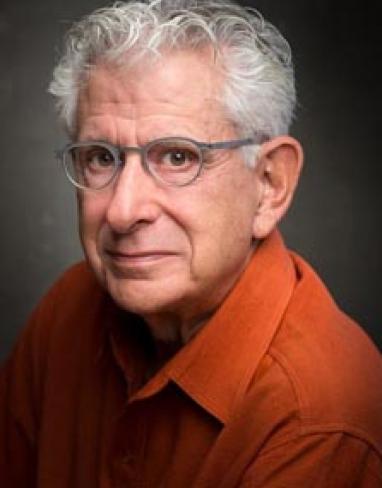

Gordon Pearlman
Favorite Memories:
- Launching Kliegl Performance at L’Enfant Plaza in DC located on the top floors of a tall office building and then the fire alarm going off.
- Many too many Kliegl Suites
- Launching Kliegl Performer in Seattle and as many of you remember intentionally tripping and throwing the Performer across the stage
- Steve Terry's ad hoc meeting where Steve Carlson's and my mash-up of everybody's spec became DMX-512
What the USITT means to me?
The many great friends I have made over all these years.
Career highlights:
- MFA Tulane University
- Lighting Designer and TD, Univ. of North Carolina
- Vice President, Electronics Diversified
The LS/8 and "A Chorus Line"
- Director of R & D, Kliegl Brothers
Performance
Performer I, II, III
Command Performance
- President / Co-owner, Entertainment Technology
Performer IV, V
Morpheus Commander
Strand Impact
GAM Access
Lightolier Lytemode, Scenist, EasySet
IPS Dimming System
Horizon PC Console
- Genlyte/Philips/Vari*lite/Strand
Vision Net
Memorable USITT Characters:
I think the key word here is "characters". The following list is in no particular order and I apologize to those I can no longer remember: Joel Rubin, Ned Bowman, Will Bellman, Ed Petersen, Pat MacKay, Steve Terry, Richard Pilbrow, Stan Miller, Peter Rogers, Joe Tawil, Larry Kellerman, and (especially) Michael Connell.
Awards and Recognitions:
- LS/8 from "A Chorus Line" exhibit at the Computer Museum 1991 – 2000
- Fellow of the Illuminating Engineers Society 1991
- Fellow of USITT 2010
- The Wally Russell Foundation 2016 Lifetime Achievement Award
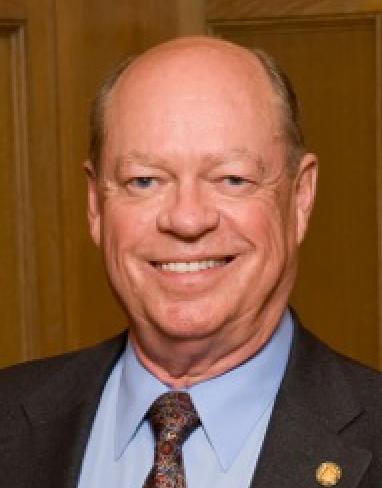

Van Phillips
Your earliest memories of the institute?
My first knowledge of and about USITT was being told by Gene Diskey, the TD at the Dallas Theatre Center (I was his Assistant), that a new organization had just been formed and I should join it. So, I joined! Gene was a Yale Graduate and had connections on the East Coast and got the word about USITT shortly after it was formed. No, I didn't walk up hill both ways in the "neck deep" snow to the meeting when USITT was formed, but joined soon afterward.
Does anything stand out as your favorite USITT memory?
Having used my experience at the DTC to figure out what I wanted from a college degree I left The Dallas Theatre Center to return to school at Southwestern University. When USITT decided to have its annual conference in Dallas, Gene Diskey became part of the Local Conference Committee. He in turn asked me to come to Dallas and work the conference as a support staffer. So, I was in the room helping out when the USITT Board had the now famous - "We are broke, and need to file for bankruptcy!" meeting. I remember the tension in the room and the silence that followed being charged. I had just put a fresh container of ice water down between Edward F. Kook, Head of Century Lighting, and Joel E. Rubin, Vice President of Kliegl Lighting - when Kook stood (all 5'-3" of him,) pulled out his wallet and started slapping 100 dollar bills on the table. He turned to Joel and, pointing at the stack of bills, said, "Match it!" It wasn't a request so much as a demand.
I've heard many people describe that as the "pass the hat meeting". But, in truth it was more of Ed Kook going "we are not going bankrupt on my watch" and challenging the other Board Members to join him in getting things fixed. In that era there were few academics on the Board and none of the corporate types were going to challenge "Don" Kook! I remember thinking," Welcome to 'active' membership in the USITT!"
Career highlights:
Theatre Planning:
- Principal of Jones & Phillips Associates, Inc., Theatre Planners and Architectural Consultants
- American Society of Theatre Consultants (ASTC),1975 – present
- Listed in Who's Who in Theatre Consulting, Theatre Crafts, 1983
- National Award - Masters of Innovation II, Zenith Data Systems, 1990 Innovative solution to exploring performance architecture
- Freelance Theatre Architectural Consultant, 1969 – 1975
Professional Design:
- Freelance Designer and Technical Director for Theatre, Opera, Ballet, and Television. United Scenic Artist – (USAA) LU - #829. 1965 to present
- Assistant Art Director (Hawaii) for the films: Blue Hawaii, Hawaii, and In Harms Way
- United Scenic Artists (USAA), Examination Committee, 1980 -1990
- United Scenic Artist Review Team for the proposed merger of Locals 350 and 829
- Listed in Who's Who in Opera, 1976
Educator:
- Purdue University: Professor Emeritus 2001, Director of Design and Technical Theatre - 1974-1990, Acting Director of Theatre 1975- 1976 and 1982-83, Full Professor of Theatre Design in 1978
- University of South Florida: Director of Design and Technical Theatre, Associate Chairman,1972‑74, Assistant Professor, 1969 – 1974
Technical Theatre:
- Technical Director, Honolulu International Theatre Center, 1965 – 1967 (Summers);
- Assistant Technical Director, Dallas Theatre Center, 1962 – 1963
- Technical Director, Lutheran Actors Company,.1962 (Summer)
- Designer/Technical Director, Foothills Playhouse,1958 – 1961 (Summers)
Your various involvement in the Institute:
- United Scenic Artists Representative to the Third Congress of OISTT International Congress on Scenography in Avignon, France, 1974
- Chairman of U.S.I.T.T.'s National Liaison. 1974 to 1978
- Board of Directors,1974 to 1984
- Selected to be Co-Leader (with Donald Stowell Jr.) of the US Scenography Delegation to OISTAT, International Congress on Scenography, Prague, January, 1976
- Finance Committee, 1979 to 1993.
- Chairman of the Committee on Liability, 1985 to 1988
- Chairman, Corporate Projects Committee, 1986 to 1996
- Fellows Nominating Committee, Chair, 1986 to Present
- Founders Award, 2000
A short list of the memorable USITT characters that have made a difference to you?
There have been and are so many memorable "characters" in USITT that a short list is impossible, so I will list a few of our departed "characters"!
Edward F. Kook - if USITT had a Napoleon - it was Eddie Kook. He may have been only 5'-3" bit he was a force that got things done. It took great courage to call him Eddie, and I was only willing to call him Kookie when his wife Hilda took me aside and told me, He would really like you to call him Kookie!" This man was Century Lighting and the power/money behind many of the most famous Broadway productions from the 1930s to the 1960s such as Death of a Salesman, Picnic, Oklahoma, The Diary of Anne Frank and on and on.
During the January, 1976 OISTT, International Congress on Scenography in Prague, I remember standing in the 1365 Church of Our Lady before Tyn with Jo Mielziner, Millia Davenport, Eddie and Hilda Kook, and Don and Bonnie Stowell looking at the beautiful Gothic interior. Eddie said, "Give you one little Jewish boy and look what you do!"
Leland "Lee" H. Watson - My first memory of Lee was of him sitting on top of a pile of stacked hotel tables in the hallway of the Waldorf Astoria in New York for a USITT Conference. He looked for all the world like a Leprechaun in his lime green suit and brown feather bow tie. Lee designed lighting for several Broadway shows including The Diary Of Anne Frank, was President of USITT and was author of many articles and several books on stage and television lighting. But, if USITT had one person who truly deserved the title "character", it would have to be Lee, although Randy Davidson has done a fine job of carrying on the role.
Harold "Snodgrass" Burris-Meyer - at 6'-6" and all loose joints like Disneys' Ichabod Crane, he was hard to miss. Always ready with a limerick and called upon to close every meeting from the USITT Board to the National Conference, Harold was and remains a huge presence in the Institutes history. His books remain well known, but his pioneering role in the early development of theatre audio, subliminal audience control and theatre architecture seems lost to younger members.
Alvin Cohen - Owner of Paramount Theatrical Supply and was Eddie Kook's money manager. Al served as the USITT Treasurer from just after the near bankruptcy and on for two decades or better. Al was one of the first real benefactors of the USITT. Although vilified by some for his unwillingness to relinquish the duties of Treasurer, he was determined that the USITT would always be financially sound. If he was guilty of anything it was that he "cared too much"!
Samuel H. Scripps - USITT's second great benefactor. Huge of both girth and love of the people who made theatre, the soft spoken and unassuming Sam Scripps never failed to find ways to financially assist the USITT. If USITT wanted to sell design renderings to raise money Sam together with Stan Miller, would always make sure the price was "sufficient". If USITT needed money for a project, Sam was there. It will be a long time before USITT finds another of his equal.
Anything you want to say about being a Fellow?
Being named a Fellow is the highest honor a person can receive within USITT. All the other honors and awards USITT gives are for achievement in one portion of an individual's career. To become a Fellow an individual must be recognized for achievement professionally and for their role within the USITT. Many achieve recognition in one aspect, but those that can prevail in both become Fellows. It is an honor that should not be taken lightly. I am proud to have been included as a member of that distinguished group of men and women.
Anything you'd like to add about the USITT?
USITT has been, and remains, the organizational home of some of my closest friends in the performing arts world. Their dedication and willingness to mentor a strong future for those who work within the performing arts speaks volumes about the importance of USITT as a national presence in the arts. Like those that work on professional productions, it ultimately isn't about individual names or past success. Over time the USITT will be judged on its next success and I feel confident that it is built on a solid foundation.
Your publications:
I have never written a book, but have provided numerous articles related to the performing arts and performing arts facilities for Auditoria, Stage Directions, etc.
Mentoring—is there an area that you’d be happy to mentor students, officers, commissions about?
I would be most useful to those interested in Theatre Consulting and the industry that supports performance architecture and the equipment needed for its construction.
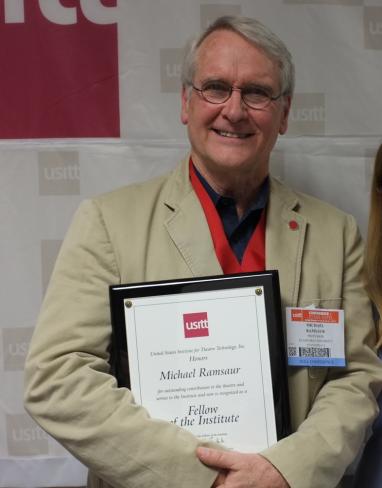

Michael Ramsaur
Your earliest memories of the Institute…?
I think I first joined USITT in about 1969 when I was a student at Carnegie Mellon University at the urging of Robert Wolf who was teaching there at that time. Shortly after I moved to California to teach at Stanford and became a founding member of the Nor-Cal USITT. We hosted the Conference in 1972. At the conference we had an opening reception that included an “open bar” at the Top of the Mark. The reception was supposed to be a “no host bar”, but by mistake it was offered “open”. The result was a very expensive bar tab for Nor-Cal. We passed the hat at the sessions of that conference to try to get money to cover the tab, I’m not sure we ever recovered enough money.
Your favorite USITT memory?
My deep involvement came when Joel Rubin asked if I wanted to attend an International Organization of Scenographers, Theatre Architects and Technicians, OISTAT meeting in Riga Latvia in January of 1986 (I don’t think he could find anyone else who wanted to go to Latvia in January). I became hooked on internationalism and have been active with OISTAT ever since.
Short list of the memorable USITT characters that have made a difference to you?
Robert Wolf, Ned Bowman, Joel Rubin, Richard Hay, Arnold Aronson, Helmut Grosser, Leon Brauner, Dick Devin, Randy Earle, Eric Fielding.
Anything you want to say about being a fellow?
Being a new Fellow, I can only say that I feel honored to be among this group.
Short list of your career highlights
- Teacher at Stanford University for over 40 years
- Owner, operator San Francisco Theatrical Supply [1976-1982]
- Member IATSE Local 16 Stagehands, and IATSE Local 829 Scenic Artists
- Many years working rock concerts at the Cow Palace in San Francisco
- Honorary Professor Central Academy of Drama, Beijing
- Previous teaching at University of the Arts Belgrade, Bavarian Theater Academy Munich, Trinity College Dublin, Taiwan National University of the Arts Taipei.
- Creator, with Pamela Howard and Chris van Gothem, of Scenofest at the PQ – Now Scenofest at World Stage Design WSD
- OISTAT – Chairman of the Education Commission and President of the OISTAT.
Books that you recommend?
My list of recommended on lighting include:
- Light Fantastic by Max Keller;
- Stage Lighting Design by Richard Pilbrow;
- The Magic Of Light by Jean Rosenthal.
For those interested in theatre technology and history:
- Bühnen Technik der Gegenwart by Friedrich Kranach. In two volumes published in 1929, in German.
- Theatre Lighting; by Louis Hartmann 193 but reprinted in 1970.
Anything you'd like to add about what the USITT means to you personally?
USITT has opened a world of doors to me internationally. Colleagues have become friends.
Mentoring:
I would be glad to give advice or mentor USITT folks about anything international, I have been to over 40 countries and have contacts with most of those countries.


Ben Sammler
Your earliest memory of the Institute?
I joined USITT in 1983 and attended the 1984 Conference in Orlando. The HOT topics at that conference were: Computers and how they could be used in theatre and that technicians did not document their “inventions”. We’ve come a long way in the past thirty-four years.
Short list of Career Highlights:
- BS 1967, State University of New York at Brockport
- Technical Director/Lighting Designer, SUNY Brockport 1967-1971
- MFA 1974, Yale School of Drama, Department of Technical Design and Production
- Yale School of Drama/Yale Repertory Theatre:
- Technical Director 1974-1980 (over 50 productions)
- Chair, TD&P Department/Production Manager 1980-2013
- Chair, TD&P Department/Head of Production 2013 to present (over 300 productions)
Short List of your involvement in the Institute:
- Vice Commissioner, Technical Production Commission, 1987-1988
- Co-Commissioner, Technical Production Commission, 1989-1991
- Co-Chair of the biennial National Theatre Technology Exhibit for its first five years, 1987-1995
- Director-at-Large, United States Institute of Theatre Technology, 1993-1995
- USITT Panels:
- United States Institute for Theatre Technology Time Estimating, 1984
- Production Management; Estimating Time and Money, 1985
- International Training of Theatre Technicians: Requirements and Competencies, 1985
- Technical Directors and Technical Directing, 1985
- Problem Solving: A Round Table Approach, 1986
- Bringing Order to the Chaos, 2009
- Structural Design for the Stage; A Discussion, 2015
- Professional Development 3 Day Workshops: Structural Design for the Stage at USITT National Conferences, 2001, 2002, 2003, 2005, 2007
A Short List of Memorable USITT Characters who have made a difference:
Every member that authored a book that has contributed to the advancement of the industry. Every member that has participated in writing the standards that have contributed to the advancement of safety in the industry. Every individual and/or company that sponsors a Young Designers and Technicians Award; in particular—Richard K. Heasel, founder of KM Fabrics Inc., Zelma H. Weisfeld, costume designer/historian, and Bernhard R. Works, Professor Emeritus of Design and Production at the University of Illinois – for sponsoring an award and encouraging others to do the same.
List of Publications:
Books:
- Theatre Technology Exhibit Catalogue, USITT, 1987, 1989, 1991, 1993, 1995
- Structural Design for the Stage, Focal Press, 1999, Co-authored with Alys Holden
- Structural Design for the Stage: Second Edition, Focal Press, 2015, Co-authored with Alys Holden, Steven Schmidt, and Bradley Powers
- Technical Design Solutions for Theatre, Vols: 1 & 2, Focal Press, 2002, Co-editor with Donald Harvey
- Technical Design Solutions for Theatre, Vol 3, Focal Press, 2013, Co-editor with Donald Harvey
Articles:
- Stressed Skin Platform Units, Technical Briefs 1981
- A Platform System, Technical Briefs 1984
- Bringing Order to the Chaos—How Can We Encourage More Students to Pursue a Career in Technical Theatre? NETC NEWS, 2006
- Upside Down in the Underworld—Simple Stage Effects Disorient the Audience in Eurydice, Lighting and Sound America 2007
Anything you would like to add about what the USITT means to you personally?
Attending the annual conference is a great opportunity to meet new colleagues and to stay in touch with colleagues that you would otherwise not see every year.
Mentoring:
I welcome students and colleagues to contact me to discuss Career Development, Technical Direction, Production Management, or Teaching.
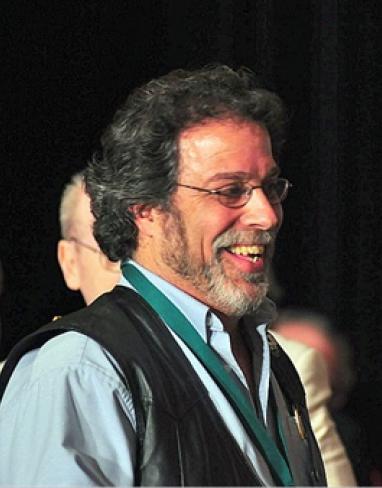

Bill Sapsis
Your earliest memories of the institute?
Attending my first USITT conference. 1983 in Corpus Christi, Texas. It was an auspicious beginning.
Your favorite USITT memory?
Stump the Rigger sessions with Jack Suesse at the Conferences.
Career Highlights:
- Head rigger at the Marriott Marquis Theatre, Times Square and the Palladium Nightclub
- Rigging for White House events during the 1990’s
- A neighborhood production of Peter Pan for 8 year old kids in Philadelphia.
- Training classes for Cirque du Soleil
Short list of USITT involvement:
- Two Term Board of Director
- Finance Committee Member
- Fellow
- Exhibitors Committee
USITT members who have made a difference to you:
- Jack Suesse
- New Bowman
About being a Fellow?
Awe inspiring to be able to share experiences with people like Richard Pilbrow, Joe Aldridge, Jack Suesse and Jay Glerum
What does USITT means to you personally?
The Institute has given me the opportunity to work not only with the leading industry professionals of today, but also with the students who will be the leading industry professionals of tomorrow
Your publications:
- Heads! And Tales, Uncle Bill’s Musings on the Theatrical Experience
- Entertainment Rigging for the 21st Century
Mentoring?
You betcha. As often as I can. Both as a mentor and a mentee.


Mark Shanda
Does anything stand out as your favorite USITT memory?
Many of my memories revolve around the meals that I have shared with colleagues and friends at various conferences. One of the most memorable was one organized by my good friend Barry Cleveland when we were in Fort Worth in 1996. About twenty of us, including Louis Bradfield were taken to a favorite barbeque place of Barry’s. Two-thirds of the way through the meal, with delicious food being served family style, someone asked what kind of meet we were eating. The answer was Cabrillo (goat). When translated, the look on Louis’ face was priceless and I have never laughed so hard in all of my life.
Short list of your career highlights
I came to Ohio State in July of 1986 with a plan to stay two or three years and I am still there. Highlights include: technical direction of over 250 productions, co-authoring Drafting for the Theatre with fellow Fellow and mentor Dennis Dorn, conducting program reviews at several colleges and university throughout the country as well as the Hong Kong Academy of Performing Arts twice, being awarded the Kennedy Center/American College Theatre Festival Medallion, Chairing the Department of Theatre for five years, and being named Dean of Arts and Humanities in the College of Arts and Sciences in 2010.
List of your involvement in the institute
Ohio Valley Section Vice-chair for Programming
Chairing Tech Expo committee
At-large member of the Board of Directors
Technical Production co-commissioner
Serving as Technical Director for the 1999 PQ entry
Serving as Vice-President for Communications
Being named a Fellow in the class of 2012
Short list of memorable USITT characters that have made a difference in you...
Dennis Dorn, my major professor, writing partner and friend
Stan Abbott for his many Stress and Wellness seminars
Dr. Doom (Randall Davidson) for raising awareness about Safety
Jay Glerum for his outstanding work in educating so many about overhead rigging
Henry Tharp for proving that one can grow older gracefully
Zelma Weisfeld for speaking her mind and asking others to “Speak Up!”
Leon Brauner for setting an example about working with Commissions
Chris Kaiser for providing me a whole new respect for fiscal responsibility
Joe Aldridge for placing the membership first in his presidency
Rick Stephens for cherishing our history and speaking his mind as well
Anything you want to say about being a fellow?
I was both surprised and honored when I was named a Fellow last spring in Long Beach. I highly value my USITT involvement and advocate for any and all theatre designers and technicians to join this great organization.
Anything I would like to add about what USITT means to you personally?
This organization has enabled me to stay connect to a field that I love and to people who I care about who share a common bond in their love for the process of creation of live production.
List of publications
Books
Drafting for the Theatre (2nd Edition), Southern Illinois University Press, 2012, Co-authored with Dennis Dorn of The University of Wisconsin-Madison
Drafting for the Theatre, Southern Illinois University Press, 1992, Co-authored with Dennis Dorn of The University of Wisconsin-Madison
Technical Design Solutions for Theatre Vol. 2, Focal Press, 2002 Bronislaw J. Sammler, Don Harvey - Foreword
Articles
“Stock Stage Lift Components”, Theatre Design and Technology, Co-authored with Chad Mahan Fall 2011
“Jaroslav Malina Paintings and Design – Exhibiting a Master”, Theatre Design and Technology, Fall 2009
“Tracking Down Tenure” Stage Directions, November 2009
“Cross Continental Collaboration” Theatre Design and Technology, Fall 2007
"Stage Rigging Handbook, 3rd Edition - Book Review," Theatre Design and Technology, Fall 2007
"The Health and Safety Guide for Film, TV & Theatre, Book Review," Theatre Design and Technology, Summer 2002
"The Essential Technical Direction Library" Sightlines. August 2001
"The Staging Handbook - Book Review," Theatre Design and Technology, Fall 1998
"Stage Rigging Handbook - Book Review," Theatre Design and Technology, Fall 1997
"A Turntable Drive Mechanism," Theatre Design and Technology, Fall 1997, with Jim Knapp
"USITT Guideline for a Standard Technical Information Package," Theatre Design and Technology, Spring 1996, with Dennis Dorn and Happy Robey
"Parenting and the Theatre" Sightlines, July/August 1993
"Elektromagnetisch decorkoppelingen" Zichtlijnen (Dutch Theatre Journal), December 1991, Co-authored with M. Barrett Cleveland of Colorado State University
"Electromagnet Scenery Locks," Theatre Design and Technology, Summer 1991, Co-authored with M. Barrett Cleveland of Colorado State University
"Improving Graduate Education: Changing Our Priorities," Design for Arts in Education, March/April 1991
"An Ethafoam Rod Splitter," Yale School of Drama Technical Brief, January 1991
"Low-Cost Large Format Slides" Theatre Crafts, December 1990, Co-authored with M. Barrett Cleveland of Colorado State University, in association with Media-Com Inc.
"Retrofitting Projectors to Interface with a Microcomputer Lighting Controller" Theatre Design and Technology, Fall 1989, Co-authored with M. Barrett Cleveland of The Ohio State University
"Low Cost Transparencies for Large Format Projectors Using the Polaroid Instant Slide System"' Theatre Design and Technology, Winter 1988, Co-authored with M. Barrett Cleveland of The Ohio State University
"Gelatin Molds, a Low Cost, Flexible Negative Mold Material," Yale School of Drama Tech Briefs. October 1987
List of Books that I recommend
See "The Essential Technical Direction Library" Sightlines. August 2001
Mentoring
In any respect that might be useful


LeRoy Stoner
First active in USITT?
My first activity with USITT was by way of the Midwest Section under the mentorship of Gary Gaiser. Dr. Gaiser was the consultant on a new theatre built at Wabash College and opened in 1968. A recent alum I was hired to be the first technical director. Working on contractor punch lists with him he quickly realized I could use mentoring and encouraged me to participate in Midwest Section activities; sometimes at Bloomington, IN sometimes Lafayette IN, sometimes Chicago, and sometimes at Urbana IL where I met the core leadership of the Section and, as I later learned, core members of USITT as well. I later attended Indiana University to study lighting design and arts management and Dr. Gaiser was my advisor.
Does anything stand out as your favorite USITT memory?
1968-2021 fifty-three years, so MANY memories it is very difficult to identify a favorite. However, Saturday of the 1989 Calgary Conference when we boarded busses for a day trip to Lake Louise and dinner at the Banff Canadian Pacific Hotel - absolutely gorgeous! (We paid the next day though as we tried to fly out of Calgary and return to our midwestern homes – snowstorms and airports closed.) I recall other times at end of conference trying to return home from western conferences through Denver!
Some career highlights:
- Serving as Conference Chair of 1990 USITT Annual Conference and Stage Expo in Milwaukee,
- Hosting five KCACTF festivals in Milwaukee, awarded KCACTF Gold Medallion January 2019
- River tour traveling from Moscow to St. Petersburg, to Stockholm. Saw performances of The Snow Maiden at the Bolshoi and The Sicilian Vespers at the Marinski Theatre. We had a personal tour of the Drottningholm Court Theatre outside of Stockholm in June of 2017
- Eastern Mediterranean cruise visiting Athens, Delos, Amalfi Coast and Istanbul in October 2019
USITT involvement/positions held:
- Chair, Midwest Section United States Institute for Theatre Technology, May 1988 - July 1994
- Chair, USITT National Conference and Stage Expo. Responsible for annual conference that brought national and international professionals in the area of production design and technology to Milwaukee for five days of workshops and seminars, April 1990.
- Member of the Finance Committee for the United States Institute for Theatre Technology, December 1994 - August 1996.
- Program Chair, Midwest Section United States Institute for Theatre Technology, August 1994 - July 1995
- Chair of the Conference Policy Committee for the United States Institute for Theatre Technology, August 1993 - August 1995.
- Chair of the Membership Committee for the United States Institute for Theatre Technology, August 1990 - July 1993
- Vice President for Sections and Chapters and Member of Executive Board of United States Institute for Theatre Technology, August 1996 - June 2005
- Local Programming Chair for the Annual Conference and Stage Expo of the United States Institute for Theatre Technology, March 2013
Are there memorable USITT characters who have made a difference to you?
Gary Gaiser, Bernhard Works, Richard Arnold, Christine Kaiser, Patricia Mackay
About being a Fellow?
I was elected back in the day when new Fellows were surprised at the awards ceremony and had no clue that I had been selected. It was a total surprise, one to call home about. It made that Denver Conference, March of 2000, particularly memorable.
USITT and your career?
Your publications:
TLP article TD&T, Use of Steel Building to House Rebuilt Timber Lake Playhouse , contributor to first USITT Tenure and Promotion Guidelines
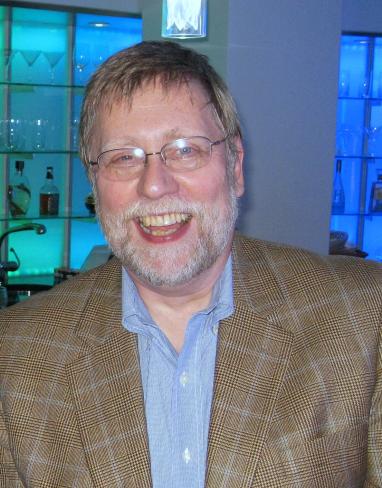

Steve Terry
Steve Terry is the Vice President of Research & Development at Electronic Theatre Controls, the Madison Wisconsin-based lighting manufacturer. In that capacity, he leads the team that is responsible for global development of new products.
Steve Terry began his professional career as the Production Electrician for the Dance Theatre of Harlem in 1971. He toured the world in that capacity for over five years, and the experience gained in that position served as the basis for many of Mr. Terry’s designs of touring equipment for the lighting rental market.
In 1976, he was responsible for the care and feeding of the first computerized lighting control system on Broadway at “A Chorus Line”. From 1977-1981, he was the Production Sound Engineer for that production.
Mr. Terry joined Production Arts Lighting in 1976, and was Executive Vice President and Chief Engineer until 1998. In that capacity, he led the Systems Integration and Consulting Group of Production Arts. This group specialized in the design, engineering, furnishing, integration, and installation of permanent entertainment technology systems in a wide variety of markets. These included theatres, opera houses, theme parks, cruise ships, and television studios. Production Arts was acquired by PRG in 1998.
Over the last 30 years, Mr. Terry has consulted with a number of manufacturers in developing advanced products for the lighting industry. The first fully digital high density dimmer for touring was produced to a design specification authored by Mr. Terry, and many of the communication network products used in today's digital lighting systems had their genesis at Production Arts.
He has been instrumental in moving the lighting industry towards the concept of systems integration rather than purchase from a single manufacturer. Systems integration is now standard practice in the lighting industry, and his work on the DMX512 standard was a key element in making this possible.
He has been involved in the engineering and management of many prestigious installation projects over the last 20 years including, to name a few, the lighting renovation of the Metropolitan Opera House, the Lyric Opera of Chicago, the Mirage, Treasure Island, Bellagio, and Wynn hotels and the Fremont Street Experience in Las Vegas, the Lido de Paris nightclub in France, “Fantasmic” at Disneyland, six NBC network television studios, seven cruise ship showrooms for Holland America Line, and the Disney/ABC “Good Morning America” studios in Times Square.
Mr. Terry also maintains an active involvement in the international lighting industry. He founded the USITT National Electrical Code Committee in 1980 and was its original chair. He was appointed a member of NFPA National Electrical Code Panel 15 in 1994.
He chaired the USITT Committee that wrote the internationally-accepted DMX512 standard for digital communications in lighting systems. He was inducted as a Fellow of the USITT in 2005.
He has been a frequent contributor to Lighting Dimensions (now Live Design) , and Protocol magazines, and has authored many articles on control systems, codes, and standards. He is a frequent panelist at technical sessions throughout the lighting industry.
Mr. Terry co-chaired the Entertainment Services and Technology Association's Control Protocols Working Group from its inception in 1994, to 2007. This working group produced the next important control standards for the lighting industry, ANSI Standard E1.17, Architecture for Control Networks (ACN) and ANSI Standard E1.20, Remote Device Management (RDM). Mr. Terry is currently a member of the ESTA Board of Directors, the ESTA Technical Standards Committee, and the ESTA Electrical Power Working Group.
Professional Affiliations:
US Institute for Theatre Technology
- Fellow of the Institute
- Vice Commissioner for Engineering
National Fire Protection Association Member National Electrical Code Panel 15 (USITT Alternate)
Entertainment Services and Technology Association (ESTA)
- Founding Co-Chair -- Control Protocols Working Group
- Member, Electrical Power Working Group
- Member, Board of Directors
- Member, Technical Standards Committee
Underwriters Laboratories Member--
UL498 (Attachment Plugs and Receptacles), UL924 (Emergency Lighting and Power Equipment), UL1008 (Transfer Switches) and UL1340 (Hoists) Standard
Technical Panels, Industry advisory Groups for UL1691A Single-pole connectors and UL1640 Portable Power Distribution
Institute of Electrical and Electronics Engineers (IEEE) Full Member
International Association of Electrical Inspectors (IAEI) Associate Member
Certifications
ETCP Certified Entertainment Electrician
ETCP Recognized Trainer—Electrical
Awards
1993 USITT Founders Award for work on Codes and Standards
Articles Published
“USITT Dimmer Transmission Standards—Dimmer Communications Protocols May End the Black Box Jungle” Lighting Dimensions March/April 1987
“Entertainment Industry Standards—USITT Committee Considers Control Communications” Lighting Dimensions September/October 1987
“Glimpsing the Future—Symposium Discusses Prospects for Automated Lighting On The Legitimate Stage—A Technical Commentary” Lighting Dimensions March 1988
“Type W—National Electrical Code Recognizes Single-Conductor Feeder Cables For Portable Dimmer Boards” Lighting Dimensions January/February 1989
“Multipurpose Peripherals—L86/IR and L86/I5M Provide Advance In Flexibility and Power of Systems Using DMX512” Lighting Dimensions April 1989
“Access—An Affordable Professional Console” Lighting Dimensions September 1989
“An Industry Milestone—Lee Colortran’s ENR Dimmers Squeeze a New Level of Features Out of Existing Technology” Lighting Dimensions October 1989
"Does the Shoe Really Fit?—The Pressing Need For Advanced Standards After DMX512” Lighting Dimensions March 1990
“Cable Selector Guide—A User’s Guide to Portable Cable Selection for the Entertainment Industry” with Ken Vannice, Lighting Dimensions April 1990
“Dimming System Destruction—Isolation Failures Creep Up On the Lighting Industry” with Karl Ruling Lighting Dimensions October 1990
“Colorful Personalities—Automated Design Tools—An Evaluation of Six Rolling Color Changers” Lighting Dimensions November 1990
“The Business of Standards” Lighting & Sound International April 1991
“Dimming Doom—Understanding Emergency Transfer in Dimming Systems” Lighting Dimensions November 1992
“Emergency Transfer Revisited—The Further Intricacies of the UL1008 Standard” Lighting Dimensions January 1993
“Upscale Ethernet—Picking the Best Network Configurations for Reliable Performance Lighting Systems” Lighting Dimensions November 1994
“Common Ethernet—The Urgent Need for an Advanced Common-Protocol, High Speed Network for the Lighting Industry” Lighting Dimensions March 1997
“Power Play—Considerations for Feeding Dimmer-Per-Circuit Systems In Theatres and Similar Locations” Lighting Dimensions September 1997
“Back to The Future—Checking Up On 20 Years of Lighting Dimensions Predictions” Lighting Dimensions October 1997
“Report From The Standards Front—UL Considers Single-Pole Connectors” Entertainment Services & Technology Association Newsletter
“Report From The Standards Front—UL Agrees With Industry Input On Single-Pole Connector Standard” Entertainment Services & Technology Association Newsletter
“Whose Network Is It Anyway?—Why the End User is the Loser in the DMX512 Connector Controversy” Lighting Dimensions May 1998
“Understanding Control of Emergency Lighting Circuits” ESTA Protocol Summer 2004
“What’s Connected?—Unique Global Dimmer Load Survey Delivers Surprising Results” LiveDesign March 2006
“New Power Tools Provide Quality and Efficiency” ESTA Protocol Fall 2007
“The Case of the Hidden Harmonic Filter” ESTA Protocol Summer 2008
“Understanding Control of Emergency Lighting Circuits—2010 Update” with Ken Vannice and Mitch Hefter, ESTA Protocol Spring 2010
“Understanding Hidden Electrical Diversity in Entertainment Lighting Systems”, ESTA Protocol Fall 2010
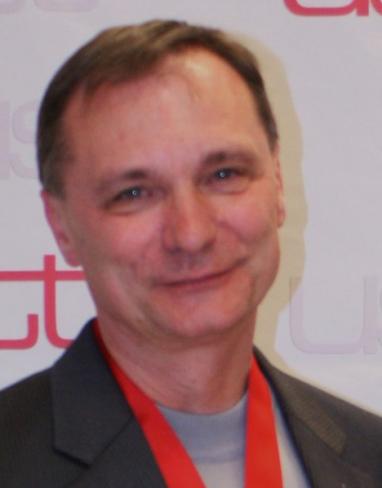

Rick Thomas
Your earliest memories of the Institute...as in how far back do you go?
1979. I'm guessing it was either Van Phillips or Lee Watson that arranged for me to be on a panel with Harold Burris-Meyer. I was very young (in graduate school), and, at the time there were only two books out (at least that I knew of). One was David Collison's, the other was Harold Burris-Meyer's. Harold Burris-Meyer was just at the end of his career, and it's one of my fondest memories that I was able to meet him and get to know him a little bit before he passed. Such a major contributor to our field. I didn't meet David Collison, another incredibly influential person in our field, until decades later.
Does anything stand out as your favorite USITT memory?
Bloodbath of the LIving Dead in 3D at the Milwaukee conference in MIlwaukee Rep's Stiemke Theatre. Back in those days we were blazing trails, introducing new things about theatre sound to the world, and USITT was the place to do it--AES didn't really understand theatre, and most of the other organizations really didn't exist or weren't really players. We made USITT our playground, and BB of the LD in 3D, as we affectionately called it was perhaps the best example. We did--to the best of my knowledge, the first demo of digital audio us in theatre--Sound Tools (that would be the forerunner to Pro Tools), Performer (the forerunner to Digital Performer), the legendary EIII (Emu's Digital Sampler), Command Cue (Charlie Richmond's visionary theatre sound control software, decades before SFX and QLab) all in one giant "sound console" spread across the stage. But the show itself was what I loved. Based on John Pielmeyer's short play, Splatterflick, the play shows us an audience watching a 3D slasher/horror movie.
Short list of your career highlights
- 2009 Elected to the National Theatre
- 2008 Inducted into the “Book of Great
- 2008 Inducted as a Fellow into the
- 2008 Received the Joel E. Rubin
- Founder’s Award from the United States Institute of Theatre Technology
- 2007 Awarded the George P. Murphy
- 2007 Awarded the College of Liberal Arts
- Award for Outstanding Teacher at Purdue University
- 2006 Second Appointment to the Purdue
- 2006 Awarded the Purue University
- Department of Visual and Performing Arts Award for Outstanding Teacher
- 2002 Winner, Herbert D. Greggs Award
- 2000 First Appointment to the Purdue Center for Artistic Endeavors
- 1992 Indiana Master Artist Fellowship
- 1990 Indiana Master Artist Fellowship
- 1988 Presented the first public lecture on sounds systems for educational theatres for the Audio Engineering Society in Nashville TN
- 1987 Worked with the Jeff Awards Committee to institute theatre awards for sound design in Chicago Theatre
- 1985 Presented the first lecture to the Acoustical Society of America on the emerging field of theatre sound design
- 1981 Early article for Theatre Crafts on approaching sound design for period plays
Short list of your various involvement in the institute
- 2008 Authored first monograph in USITT’s biography series on sound designer, The Designs of Abe Jacob
- 2005 Curated first exhibition of theatre sound design at World Stage Design in Toronto Canada
- 2003 Co-created the first Scenofest at the Prague Quadrennial including ten international artists lecturing on theatre sound design and the first international exhibition of theatre sound design at the Prague Quadrennial, Czech Republic
- 2003 Curated first exhibition of theatre sound design in the USITT National Exhibit at the Prague Quadrennial, Czech Republic
- 2003 Published article in Theatre Design and Technology Journal with Rob Milburn on Sound Programs in Higher Education
- 2000 Presented first international lecture on theatre sound design for OISTAT at the Bregenz Festspiele and Kongresshause, Austria
- 2000 Initiated the OISTAT Sound Working Group and became its first Head
- 1999 First international exhibition of a theatre composer/sound designer’s work for OISTAT at the Zoa House in Tel Aviv, Israel
- 1997 Authored a two part article on the current state of theatre sound technology for TD&T
- 1997 Inaugurated International Sound Artist series of guest lectures for USITT in Pittsburgh PA
- 1996 Published article describing Tom Mardike’s innovative loudspeaker playback system using MS microphone techniques
- 1995 Co-Authored with Ken Bell a journal article regarding the aesthetics of auditory space
- 1993 Organized and hosted the first Syn Aud Con Workshop in Theatre Sound at Purdue University. Presented four lectures:
- Theatre Sound Cue Sheets
- Using Computers to Create Sound
- Multi Channel Sound in Theatres
- The Rehearsal Process (w/Abe Jacob) USITT subsequently devoted a whole issue of TD&J to publishing the papers I presented at this workshop
- 1990 First public demonstration of the use of digital audio in theatre sound score design, including live sequencing (MOTU Performer), sampling (EMU EIII), hard disk recording (Digidesign Sound Tools) and Control (Richmond Sound Designs Command Cue) at the USITT National Conference in Minneapolis MN
- 1988 Published first journal article detailing the problems associated with using copyrighted audio in theatre sound scores in TD&T
- 1987 Published first journal article detailing the need for union representation for theatre sound designers in TD&T Journal, 23.3, p. 58-65.
- 1987 Presented first public lecture on the use of digital samplers in live theatre at the USITT National Conference in Minneapolis MN
- 1985 Presented the first lecture to the Acoustical Society of America on the emerging field of theatre sound design
- 1985 Co-produced and engineered the first compact disc recorded in the state of Indiana
- 1984 Presented the first public exhibition of a theatre sound score at the USITT National Conference in Orlando FL
- 1981 Presented the first public lecture and demonstration of the use of synthesizers in theatre at the 1981 USITT National Conference
- 1980 Conducted the first public workshop on using sound effects in theatre at the 1980 USITT National Conference
- 1979 Panel member on first public discussion of the emerging field of theatre sound design at the USITT National Conference in Seattle WA
If you were to make a short list of the memorable USITT characters that have made a difference to you, who would they be?
Van Phillips and Lee Watson, who introduced me to USITT, and mentored me through it, Harold Burris-Meyer, who started it, and I was just lucky to get to know, Dick Devin who made the sound and lighting commissions a reality, Charlie Richmond, who did so much for the sound commission, and then empowered me to do more, Dick Durst, who empowered the introduction of sound into OISTAT--oh, dear, I better stop there, otherwise I'm going to upset a whole bunch of really important friends and colleagues that I left out.
Anything you want to say about being a Fellow?
It's pretty humbling considering the company we keep.
Anything you'd like to add about what the USITT means to you personally?
Everything. It made my career.
List of your publications
See above.
List of books that you recommend about the field
Modern Recording Techniques, David Miles Huber and Robert Runstein
Musical Experience of Composer, Performer, Listener , Roger Sessions
Music, Sound, and Sensation, Fritz Winckel
Psychology of Music, Carl E. Seashore
Sound and Music for the Theatre, Kaye, Deena & LeBrecht, James
Sound and Symbol, Victor Zuckerkandl
Tune, Holst, Imogen
JBL Audio Engineering for Sound Reinforcement, John Eargle and Chris Foreman
The Soundscape, R Murray Schafer
This Is Your Brain on Music, Daniel Levitin
Musicophilia, Oliver Sacks
Sound: A Reader, Ross Brown
Composing Music for Film , Jack Smalley
Audio System Design and Installation, Phillip Giddings
Microphone Handbook, John Eargle
Sound System Engineering, Don Davis and Eugene Patronis Jr.
Sound Systems: Design and Optimization (2nd Edition), Bob McCarthy


John S. Uthoff
USITT involvement:
John has served as Vice President for Conferences, President and Immediate Past President of USITT. He has also received the Joel E. Rubin Founders' Award. For many years he also served as the USITT's Liaison to KCACTF and has been awarded the KCACTF Golden Medallion. He currently serves on the Finance Committee.
Career highlights:
John has served as lighting designer, scenic designer, sound designer, or technical director of more than 200 productions. These include musicals, dance concerts, operas, original scripts and many plays. His interest in International Design, included involvement in World Stage Design in Toronto, and studying productions in Russia, Estonia, Finland, the Czech Republic and Canada. In addition to attending the Prague Quadrennial, John has also arranged for visiting designers from the Czech Republic, Bulgaria and Canada.
Education:
M.F.A.,University of Iowa, Theatrical Design; B.A., University of Iowa, Speech and Dramatic Art
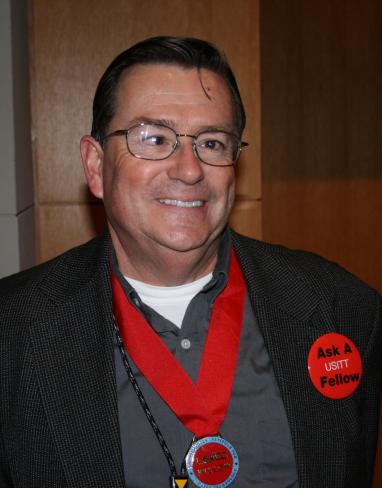

Paul Vincent
Paul Vincent is the owner and President of Vincent Lighting Systems Company, which sells and services theatre, television and architectural lighting control systems and equipment. Vincent Lighting Systems also provides an extensive rental inventory, production services and theatrical supplies. Offices are located in Cleveland, Cincinnati, Pittsburgh and Detroit. Mr. Vincent founded the business in 1978.
He is a graduate of the University of Cincinnati with a B.A. in Communication and an M.A. in Theatre. Mr. Vincent worked for Kliegl Bros. in New York as a project salesperson and tradeshow manager; he also was mid-west regional sales manager for Colortran and eastern operations manager for Strand Lighting before starting his own business.
Mr. Vincent served for five years as President of the Entertainment Services and Technology Association (ESTA), a professional industry trade association. He also served as Vice-President the previous three years. He most recently served as Chair of the Technical Standards Committee. Vincent Lighting Systems is one of the founding members of ESTA. ESTA merged with the Professional Lighting and Sound Association (PLASA) effective January, 2011 which now serves more than 1200 members.
Mr. Vincent has been a member of the United States Institute for Theatre Technology (USITT) since 1974 and became a member of the Ohio Valley Section in 1978. He served as Section Chair from 1980 to 1982 and currently serves as chair of the membership committee. Vincent Lighting Systems is a contributing member of USITT National and a sustaining member of the USITT Ohio Valley Section. Mr. Vincent was recognized as a Fellow of the Institute in 2004 for his contributions to theatre and service to USITT. In 2009 he received USITT’s Thomas DeGaetani Award for his leadership in the entertainment industry. He currently serves on the board of USITT.
Mr. Vincent is an advisory board member for the Theatre and Dance Department of Kent State University, Kent, OH, and is also a board member of the Ohio Citizens for the Arts (OCA), Columbus, OH, The Musical Theatre Project (TMTP), Cleveland, OH and The Wally Russell Foundation. He previously served as a board member for the Pittsburgh Irish and Classical Theatre (PICT) and Cabaret Pittsburgh.
Vincent Lighting Systems is a sustaining member of the Illuminating Engineering Society of North America (IESNA), as well as a corporate member of the International Special Events Society (ISES). Mr. Vincent is a member of the Ohio Educational Theatre Association (OEdTA) Hall of Fame. He has presented numerous lighting workshops and seminars over the past thirty-seven years to students, end users, architects, electrical engineers and electrical contractors.


David Will
Your earliest memories of the institute?
I had the pleasure to be part of a team of students representing Penn State in a Master Class hosted by USITT featuring Helmut Grosser in February of 1973. It was held at Carnegie Mellon (Tech) in Pittsburgh. We spent a day in the classroom with along with teams from several other Universities. This was my first involvement with the Institute.
Your favorite USITT memory?
I can’t think of any one specific memory that outshines another great memory. I always made the most out of each Annual Conference and Stage Expo. To say one was better than the other, well, maybe, there was one conference in Wichita ….hmmmmm.
Career highlights:
- Production Manager, Operation Manager, General Manager of Penn State’s Center for the Performing Arts for 26 years. Staged over 350 performances annually.
- Served as a lighting designer for campus resident dance company and staged many large special events around the campus.
- Facility Coordinator and Safety Officer for the College of Arts and Architecture at Penn State for 24 years. The college consisted of 7 departments, performing art center and an art museum.
- While doing both jobs for 10 years, my work included serving 18 college facilities in the design, performing, and visual arts. A great amount of time was spent in the programming and planning of facility upgrades and new buildings including the first LEED Gold rated building on a college campus.
USITT involvement/positions held:
- Vice-President for Conferences (2009 – 2014)
- Board Member-at-Large (2003-2006)
- Member, Annual Conference and Stage Expo Committee (1995 – present)
- Commissioner, Management Commission (1996 - 2002)
- Vice-Commissioner for Theater and Production Management (1993- 1995)
- Conference Chair, Annual Conference - Pittsburgh (1997)
Memorable USITT characters who have made a difference to you?
Walt Walters, William H. Allison, Will Bellman, Sam Scripps, Jack Schmidt, Dick Durst, Rick Stephenson, and Frank Willard.
Being a fellow means?
It is very humbling to have been selected as a Fellow of the Institute. I am honored to be among this body of members of the Institute.
Anything you'd like to add about what the USITT means to you personally?
USITT played a very important role in my career. The networking and interaction with friends and colleagues throughout the years was invaluable to me. There was always someone to turn to ask a question, find an answer and of course, have a beer with!
Books that you recommend about the field:
As many as you can read
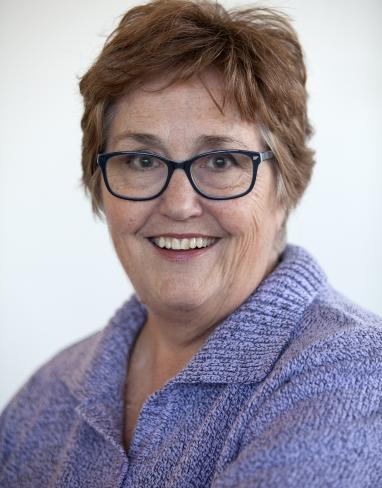

Stephanie Young
Your earliest memories of the institute?
I heard about and joined USITT in grad school (1975) but didn’t really get involved until I moved to Missouri and attended my first conference at Overland Park in 1980 and the Cleveland conference the following year. I missed the next 4 but I have been to every conference since NYC in 1985. While living in NC, I participated in the SE section master classes each fall. My first active participation in a major institute activity was as Treasurer of the 1988 Anaheim conference.
Your favorite USITT memories:
- Sarah riding the horse into the banquet in Wichita.
- The Board’s commendation when I stepped down as P&P Chair. And then they asked me to please not run for president since every time I held an office it was dissolved when I finished the job.
Short list of career highlights:
- CalArts School of Theater (30 years)—Head of Stage Management, General Manager and Assistant Dean
- Colorado Shakespeare Festival--Production Manager for 16 seasons
- Santa Rosa Summer Repertory Theater—Production Manager for 9 seasons
Short list of your work with the USITT:
- VP for Projects
- Board Member
- Chair of Planning & Priorities Committee
- SM Mentor
- Treasurer of 1988 Anaheim Conference
- Logistics Chair of 1995 Vegas Conference
- Longtime member of Finance Committee and Management Commission
- Active member of SoCal Section.
Short list of the memorable USITT members who have made a difference to you:
- Dr. Doom
- Rick Stephens
- Sarah Nash Gates
- Dick Durst
- Jean Montgomery
- Elynmarie Kazle
- Will Bellman
- Joe Tawil
About being a fellow?
I consider it a great honor and am looking forward to using that position to contribute to the goals of the Institute.
Anything you'd like to add about what the USITT means to you personally?
The camaraderie and friendships developed through commission programming, committee work and my participation on the board and the executive committee have been very important to me.
Conducting interviews for the Living History Project provided me with great joy at learning more about my colleagues’ backgrounds and goals.
Mentoring?
Production Management for students or young professionals
Principles of planning, logistics and scheduling
USITT Fellows In Memoriam


Ursula Belden
(1944-2009)
Education/Training:
- Yale School of Drama, MFA
- USA local 829, NYC
Employment History:
- Freelance designer NYC area; Broadway credits include Quilters, Waiting in the Wings and associate designer on Amadeaus
- More than two-dozen new plays and premiers Off Broadway
- Over 150 regional theatre designs for such clients as the Mark Taper Forum, Pasadena Playhouse, Kennedy Center, Cleveland Playhouse, Denver Theatre Center, Walnut Street Theatre, Cincinnati Playhouse, Pittsburgh Public Theatre, Folger Shakespeare Theatre, and Indiana Reparatory Theatre
- International credits include Volksbuehne in Berlin and the Citadel Theatre in Canada
- Head of Production Design and Technology, Ohio University (1986-2009)
- Guest Professor: London Central St. Martin’s School of Art and Design
- Taught internationally in London, Berlin, Bali, Katmandu, Prague, and Hong Kong
USITT involvement and offices held:
- Co-designed the U. S. PQ 2003 Exhibit
- Designed the structure for the World Stage Design Exhibit in Toronto (2005)
- Designed the U. S. PQ 2007 Student Exhibit
- Designs chosen for exhibition in the 1999, 2003 and 2007 U. S. PQ Exhibits
- Served as a representative to the OISTAT Scenography Commission
Awards and Honors:
- Elected USITT Fellow (posthumously 2010)
- Awarded a grant as a Fulbright Senior Specialist to teach in Hong Kong
- Recognized as a Distinguished Professor by Ohio University (2000)


Willard F. Bellman
(1920-2010)
Read a memorial of Mr. Bellman
Education/Training:
- BA University of Puget Sound (1946)
- MA Northwestern University (1947)
- PhD Northwestern University (1949)
Employment history:
- Faculty, University of Wyoming (1950)
- Faculty, Washington University
- Faculty, University of California at Los Angeles
- Faculty, San Fernando Valley State College-This school later was renamed California State University at Northridge (CSUN) (1958-1988)
Publications:
- Author: Lighting the Stage, Art and Practice
- Author: Scene Design, Stage Lighting, Sound, Costume and Makeup; A Scenographic Approach
- Author: Scenography and Stage Technology: An Introduction
- Numerous articles in Theatre Design and Technology, the most important of which were undoubtedly: “Workloads for Theatre in Higher Education” and “Guidelines for Promotion and Tenure”
- Translated the German DHIN rigging standards document. NOTE: This was a major contribution to the USITT Rigging Standards Project
USITT involvement and offices held:
- Conference Chair, Anaheim (1988)
- Vice President for Special Projects (1989-1991)
- Publications Committee (as both member and chair)
- Board of Directors
- President of the Southern California Section
- International Liaison Committee (for more than 20 years)
- USITT representative to a joint committee of ATHE, USITT and NAST To develop Promotion and Tenure Guidelines for Technical and Design faculty in the performing arts
Awards and Honors:
- Elected USITT Fellow (1985)
- Joel E. Rubin Founders Award (1990)
- Special Citation for Achievement in Lighting Design Education (1994)
- USITT Honorary Lifetime Member
- Professor Emeritus, Cal State Northridge (2000)

Arthur Benline
(1902-1995)
Education/Training:
- Architectural Engineering Certification, Graduate School in Industrial Arts, Mount Vernon, NY (1921)
- Architecture degree, University of the State of New York (1925)
- Engineering degree, New York University (1932)
Employment history:
Supervising Engineer, Loews Theatres and MGM Studios (1925–1930);
Twentieth Century Fox theatres (1930–1932) /Supervising the construction of Theatres throughout the northeast
Supervised the reconstruction of the Cosmopolitan Film Studios in New York City to accommodate the advent of sound in motion pictures (1929-1930)
Supervising Engineer, RKO Radio Theatres (1932–1934)
Executive Manager for producers Harold B. Franklin and Arch Selwin (1934–1940) including:
- Lady Jane, Plymouth Theatre, (1934)
- Continental Varieties, Little Theatre, (1934)
- Conversation Piece, 44 Street Theatre, (1934)
- L’Aiglon, Broadhurst Theatre, (1934)
- Revenge with Music, New Amsterdam Theatre, (1934)
Executive Aide, Ben F. Stein, 1935–1940, including:
- Jumbo at the New York Hippodrome, (1935)
- One Good Year, Lyceum Theatre, (1935)
- Bet Your Life, John Goodwin Theatre, (1937)
Superintendent of the Department of Housing and Building for New York City (La Guardia administration) (1940–1942)
Captain, U.S. Navy (1942–1945) commanding a special assault battalion of Seabees
Superintendent of the Department of Housing and Building for New York City (1945-1952)
Director of the New York State Building Construction Code (1952–1960)
New York City’s Commissioner of Air Pollution Control (Wagner and Lindsay administrations 1960–1966)
Architectural Engineering Consultant (1966–1977)
NOTE: Contributed to organization of Radio City Music Hall (NYC) and set up its initial budgets (1932–1934)
USITT Involvement and Offices Held:
- Founding member
- Board of Directors (1961–1966)
- First Vice President (196 –1970)
- Chair of Committee on Theatre Construction
Awards and Honors:
- War II: Purple Heart (Battle of Okinawa), Bronze Star with Combat V, Combat commendation ribbons and NY Distinguished Service Cross as Captain of Seabees special assault battalion in the Pacific Theatre of Operations
- Strauss Medal and Award of the New York Society of Architects (1957)
- Society of Construction Superintendents Distinguished Service Award (1957)
- United States Institute of Theatre Technology, Founder Award (1975)
- Elected USITT Fellow (1977)
- American Society of Civil Engineers
- American Association of Engineers
- National Society of Professional Engineers
- New York Society of Architects
- Building Officials Conference of America (president, 1955 – 1956)
- New York State Society of Professional Engineers Distinguished Engineer in Public Service Award (1966)
- Eastern States Building Officials Federation (executive vice president 1951 – 1976)
- Municipal Engineers of City of New York (president 1969)
- Underwriters Laboratories Fire Council Recognition Award for Distinguished Service in the Interest of Public Safety, 1973
- Building Officials and Code Administrators (BOCA, president, 1953 – 1955)
- BOCA International Walker S Lee Award

Robert Benson
(1928-1995)
Education/training:
- Hardin-Simmons University
- Louisiana State University
- Yale University, School of Drama (MFA)
Employment History:
Principle, Knudson-Benson Associates of Seattle, (1983 through the time of his death)
Highlights of his consulting practice included:
John Jay College Theatre, NYC
West Hollywood Civic Center, CA
Walton Arts Center, Arkansas
Snug Harbor Cultural Center, Staten Island, NY
Seattle Opera House
Renovation and expansion of the 1928 Paramount Theatre in Seattle
Taught theatrical lighting at Columbia University and New York University (1967-1976)
Served in various sales and development positions with numerous theatrical lighting manufacturers including Kliegl Bros., Berkey-Colortran, Rosco Laboratories, and Skirpan Lighting Systems (1963-1983)
Lighting Designer and Technical Director for the Santa Fe Opera (1958-1962)
Served with the U. S. Merchant Marine through the end of WWII and for several years afterward where he served as the Purser on the maiden voyages of the Independence and Constitution of the American Export Line.
Throughout his career Mr. Benson worked as freelance lighting designer with regional companies like the Dallas Opera and the Baltimore Lyric Opera as well as numerous projects off Broadway and at Lincoln Center in NYC.
Publications:
Authored numerous articles in Lighting Design + Application and Theatre Crafts magazines. Shortly before his death he contributed the article on Opera Lighting in The New Grove Dictionary of Opera.
USITT involvement and offices held:
- Founding Member of USITT (1961)
- Associate editor for Architecture for the Institute’s journal Design and Technology (1990-1995)
- Assisted with planning for the Seattle Conference (1992)
- USITT Board of Directors (several terms in the 1960s, 1980s, and 1990s)
- Pacific Northwest Section Chair (1978)
- National Conference Chair, NYC conference (1974)
- New York Section Chair -(Early 1970s)
Awards and Honors:
- Elected USITT Fellow (1990)
- President, International Association of Lighting Designers
- (Founding Member) Lighting Associates of United Scenic Artists, Local 829
- President, American Society of Theatre Consultants

Ned A. Bowman
Education/Training:
- Indiana University (1949-1952) and University of Iowa (1952-1953); BA
- MA University of Iowa (1955-1956)
- PhD Stanford University (1958-1960)
- Attended the University of Vera Cruz, Mexico (1957)
Employment History:
- Faculty, University of North Dakota (1956-57)
- Faculty, Stanford University (1959)
- Faculty, University of Pittsburg (1960-1976)
- General Manager, Rosco Laboratories (1978-1993)
- Editor’s note: It was during his tenure at Rosco that Dr. Bowman was responsible for spearheading that company’s international marketing (he was fluent in both Spanish and German). In addition, Dr. Bowman helped Rosco become a leading innovator in the development of new products. Most notable among these were the development of Rosco’s fog machines and fluids.
Publications: Dr. Bowman was a prolific author with credits too numerous to list in full. A brief representation of his more significant efforts is listed below:
- Co-author (with Maxwell Silverman) Contemporary Theatre Architecture
- Co-author (with William Coleman and Glorianne Engle) Planning the Theatre
- Author Handbook of Technical Practice for the Performing Arts
- Bibliography: “Recent Publications on Theatre Architecture” Editor’s note: This collection, gathered over a ten year period, was eventually published in installments in Theatre Design & Technology and reached more than 2500 listings.
- Dr. Bowman published more than two dozen articles for periodicals including Theatre Design & Technology, Buhnentechnische Rundschau, Interscena , Educational Theatre Journal, Theatre Survey, Journal of Communication, Players Magazine, and the Central States Speech Journal.
USITT Involvement and offices held:
- President of USITT (1972-1973)
- Founding Editor for USITT’s journal Theatre Design & Technology (1965-1970)
- Board of Directors
- Chair of the U. S. Center of OISTAT (1979-1981)
- Chair of OISTAT Publications Committee (1971-1979)
- International Liaison Committee
- Publications Committee (Chair and member)
Awards and Honors:
- Elected USITT Fellow (1977)
- Joel E. Rubin Founders Award (1970)
- Fulbright Hays Act Lecturer to Columbia and Peru
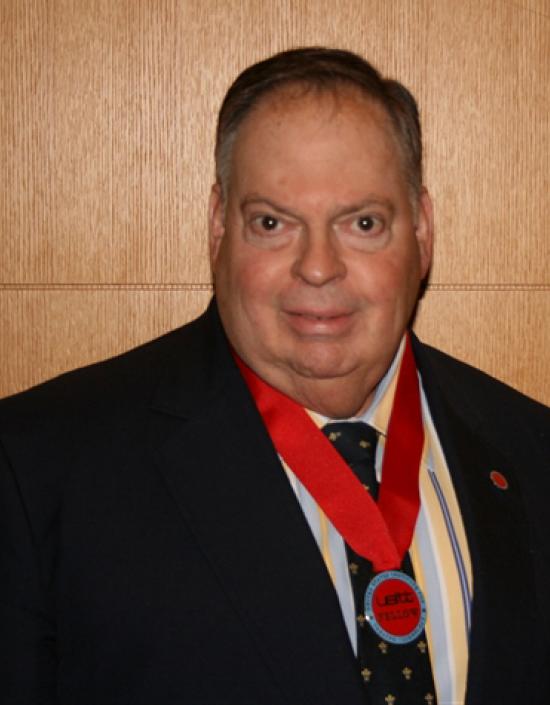

Louis Bradfield
Favorite Memories:
Becoming a Fellow, Being elected to the Board, receiving the special citation in 1991 and the 1995 conference in Las Vega when I was local programming chair and originated the Institute’s first “Super Sessions”—five in all.
Career highlights:
- Degree in theatre, University of Iowa, 1964
- Arrived in Las Vegas knowing on that “they do shows, there”, 1964
- My first stage job was the Folies Bergere (5th edition) at the Tropicana, 1965
- Becoming a member of IATSE Local 720, 1967
- Desert Inn Hotel production of Pzazz, 1968
- My last 41 years at Bally’s Hotel, originally the first MGM Grand Hotel
- Retired in 2014 after 49 years of working continuously on the Las Vegas Strip as an IATSE Local 720 theatre electrician.
Involvement in the Institute:
- Serving on the Board of Directors
- Member of the Standards Committee
- Local Program Chair for the 1995 Las Vegas conference
- Speaking at and chairing many conference sessions over the years.
Short list of memorable USITT characters:
There is no such thing as a short list! During my 48 years as a member, the friendships and connection have been rewarding and educational.
About being a Fellow:
I was very honored and surprised to have been selected by a highly respected group of my peers for inclusion in this group of the best theatre professionals. I am very proud to be a Fellow.
What the USITT means to you?
Because of USITT I have made many, life-long friends who have the same interest in and dedication to the theatre. I have learned from Theatre “Greats” and imparted my knowledge and experience to the upcoming generations of future theatre professionals. I always anticipate seeing my extended theatre family at the annual conference and other times during the year.


Harold Burris-Meyer
(1902-1984)
Education/Training:
- City College of New York, BS (1923)
- Columbia University, MA (1926)
- Florida Atlantic University, Doctorate of Humane Letters (1980)
Employment History:
- Faculty, Washington and Jefferson College (1927-1929)
- Faculty and Head of Theatre, Stevens Institute of Technology, Hoboken NJ (1929-1954)
- Sound Designer and/or Consultant on 13 Broadway productions, 7 Metropolitan Opera productions and 3 Federal Theatre Project “Living Newspaper” productions (1929-1954)
- Directed the first Stereophonic recordings for the Bell Telephone Laboratories (1941)
- Consultant and later Vice President for the Muzak Corporation (1939-1947)
- Member of the War Department Planning Board, serving in the U.S. Navy during WWII with the rank of Commander (1943-1946). He continued to serve as a reserve officer and consultant with the Defense Department through both the Korean and Viet Nam conflicts until his military retirement.
- Vice President and Director of Magnetic Programs, Inc. (1948-1957)
- Theatre Consultant on numerous building projects throughout his career, most notably the Lynchburg Fine Arts Center, the University of Connecticut, Howard University, Sweet Briar College, Temple University, the Paper Mill Playhouse, and the Atlanta Cultural Center and the theatre complex at Florida Atlantic University
- Professor and Director of Theatre, Florida Atlantic University (1965-1972)
Publications:
- Co-author (with Edward Cole), Scenery for the Theatre (1938, rev. ed. 1971)
- Co-author (with Lewis S. Goodfriend), Acoustics for the Architect (1957)
- Co-author (with Vincent Mallory), Sound for the Theater (1959)
- Author, Theatres and Auditoriums (1949, rev. ed. 1964)
- Author of numerous articles (his bibliography runs five pages) for professional journals, the most notable of which include Theatre Arts, Journal of the Society of Motion Picture Engineers, Journal of the Acoustical Society of America, Journal of Engineering Education, Architectural Record, Progressive Architecture, and The Journal of the Audio Engineering Society
USITT Involvement and offices held:
- Founding member of the Board of Directors
- Founding member of the Executive Committee
- Member of the Architectural Commission of the OISTAT
- Editor’s Note: Dr. Burris-Meyer is an Institute icon and remained closely involved with USITT from its beginnings in 1960 until the time of his death in 1984. Throughout that time he never failed to give generously his sage advice, considerable prestige and unwavering support. He was affectionately known to all USITT members as “Dr. Snodgrass,” and it was the custom for many years that Harold Burris-Meyer make the motion to adjourn all meetings in which he was in attendance.
Awards and Honors:
- Elected USITT Fellow (1977)
- Joel E. Rubin Founders Award (1973)
- Fellow, Acoustical Society of America
- Fellow, American Council for Arts in Education
- Fellow, Audio Engineering Society
- Professor Emeritus, Florida Atlantic University

Alvin Cohen
(1922-2008)
Read a remembrance of Mr. Cohen
Education/Training:
- Columbia, University, BS in Pharmacy (1939-1943)
Employment History:
- Chemist, ALCOA Corporation (1944-46)
- Worked for his father’s business, Paramount Pharmacy, until starting his own business specializing in mail-order theatrical makeup supply (1950). Mr. Cohen originally named his new business Paramount Theatrical Supply in honor of his father, but as the business grew and became a full range theatrical supply business distributing stage lighting, hardware, paint and draperies he changed the name to Alcone Theatrical Supply (1960). He sold the business and retired (1983) and it survives today under new ownership.
Publications:
- Starting in the1950s, Mr. Cohen published an original newsletter (as well as his product catalogues) under his company’s name that he produced entirely in-house for over 20 years. Using only a typewriter, a small printing press that he bought and taught himself to operate, and an old Address-o-graph machine to print the mailing addresses, this became a major communication vehicle for new product availability for the theatrical community throughout the U.S. with a mailing list of over 25,000.
- Founder and Sponsor of the SSTA Newsletter
USITT Involvement and offices held:
- USITT Treasurer (1974-1979)
- Board of Directors
- Chair, Finance Committee (1969-1973)
- Treasurer New York Conference (1974)
- Treasurer U. S. Center of OISTAT (1974-1979)
- President of the New York Section (1980-1983)
- Was instrumental in the development of the USITT Endowment
- Editor’s Note: The 1970’s were a difficult time financially in USITT history. Mr. Cohen gave generously of his time and business expertise and is, along with many others, credited with helping the Institute survive and eventually create a sound financial basis on which to move forward and grow.
Awards and Honors:
- Elected USITT Fellow (1978)
- The Children’s Theatre Foundation of America created the Alvin Cohen Memorial Fund to honor Mr. Cohen for his life-long devotion to Children’s Theatre.
- SSTA Founders Award
- Special Award from SETC (1970)

Randy Davidson
Earliest memories:
1962 attended some meetings in the East but never joined. Joined with my dear friend Will Bellman when both of us lived in California, 1964. We both were very active in regional groups affiliated with USITT.
Outstanding memory:
Receiving the USITT Health and Safety Award that I had initiated many years ago, and having Rick Stephens make the presentation.
Career highlights:
founded 7 Risk Management Companies for the Entertainment Industry.
Involved as an Expert Witness in 413 law suits: lost two. Began technical theater work in 1943 at Price College and have continued since then. Founded ISETSA: International Secondary Education Theater Safety Association, 2005.
Involvement in the Institute:
every position except that of an officer. Aided in founding and supporting many of the Regional and Student Chapters across the country, and assisting in founding the Canadian Institute of Theater Technology. Hundreds of workshops, national and regional. Liaison with all of the different Sections and Commissions for years. Three years lobbying for USITT and theater Safety in the U.S. Congress with twelve U.S. Senators and five Representatives. Active in planning national conventions.
Memorable:
Harold Burris-Meyer. Don Shulman. Randy Earle. Joel Rubin. Pat Mackay. Peter Foy. Dick Arnold. Reid Neslage. David Loftin. Ed Kook.
In my opinion: Randy Earle and Dick Arnold are the individuals who stand out as the best models for Fellows. Superb. Humble. Dedicated.
Five Publications:
Pocket Guide to Theater Safety; 3 volume set of Dr. Davidson Eye on Health and Safety in the Theater; Practical Health and Safety Guidelines for Theater Health and Safety; PLUS over five hundred monographs on Entertainment Health, Safety, Product Liability, Environmental Audits, and Security.
Always interested and continue to mentor students and others who are interested in Health
and Safety.


Thomas DeGaetani
(1929-1978)
Education/Training:
- Fordham Preparatory School (1946)
- Columbia University (1954)
- Graduate Studies, Columbia University (1954-1956)
Employment History:
- U.S. Navy medical department (1946-1949)
- Director of the Stage Department and Lecturer of Theatre Techniques at the Juilliard School of Music (1953-1963)
- Managing Director for theatres and concert halls of the Lincoln Center for the Performing Arts, NYC (1963-1965)
- Project Supervisor and Manager of facilities services for Bolt, Beranek & Newman (1965-1969).
- Editor’s note: BB&N was an acoustical consulting firm that was among the first to explore the emerging field of Theatre Consulting. Mr. DeGaetani was brought on board with BB&N to head up this effort. In the course of this work he hired many young professionals that later independently founded their own companies and became leaders in this field.
- Executive Director of USITT (1970-1972).
- Editor’s note: Mr. DeGaetani was the Institute’s first Exec. Director. Financial difficulties that resulted from the additional expenses, coupled with Mr. DeGaetani’s heath complications, forced the Board of Directors to let him go. Tom went into semi-retirement over the next few years until he succumbed to a heart attack in the spring of 1978.
Publications:
- Numerous articles for periodicals including the Juilliard Review, American Institute of Architects Journal, Progressive Architecture, and Dance Magazine.
- Board of Advisory Editors, Tulane Drama Review
USITT Involvement and offices held:
- Founding member
- President of USITT organizing committee
- First President of USITT
- Member of the Board of Directors
- Executive Director (1970-1972)
Awards and Honors:
- Elected USITT Fellow (posthumously, 2001)
- Recipient of grant from the Institute of International Education to study European theatre architecture (1959)
- Recipient of grants from UNESCO to attend the Berlin Colloquy on Theatre Architecture (1960) and the Athens Colloquy on Theatres for Mass Audiences (1962)
- Ford Foundation grant to assist the Macedonian Ministry of Culture in the development of programming for the Skopje (Yugoslavia) Cultural Center

Walter Dewey
(1915-1994)
Education/Training:
- Bachelor’s degree in Business Administration, Antioch College (1938)
- Masters of Fine Arts, University of Iowa (1947)
- PhD in Speech and Dramatic Arts, University of Iowa (1952)
Employment History:
- U. S. Army Signal Corp, PTO (WWII)
- Faculty, University of Iowa (1946-1957)
- Faculty, The Ohio State University (1957-1966)
- Faculty, University of Northern Illinois (1966-1981)
- Theatre Consultant on numerous projects including theatre buildings at Wisconsin State University, Knox College, University of Wisconsin-Lacrosse, University of Vermont, Illinois Central Community College, and Carl Sandberg Community College
Publications:
- Authored numerous articles on theatre practice and lighting while serving as a Contributing Editor of Players Magazine
- Authored additional articles for The Quarterly Journal of Speech and Educational Theatre Journal
- Professor Dewey was also responsible for supervising articles and projects for the USITT when he served as Technical Secretary for USITT (1970-1972)
USITT Involvement and offices held:
- Became a member in the early 1960s shortly after the founding of the Institute
- Served as a founding member of the Midwest Section
- Chair of the Midwest Section
- Conference Committee for 1968 Chicago Conference
- Multiple terms on the Board of Directors
- Technical Secretary (1969-1972)
- International Liaison Committee
Awards and Honors:
- Elected USITT Fellow (1989)
- NIU Excellence in Teaching Award (1980)
- Upon his retirement Professor Dewey was honored by the University of Northern Illinois with the establishment of an Endowment in his name (1981)
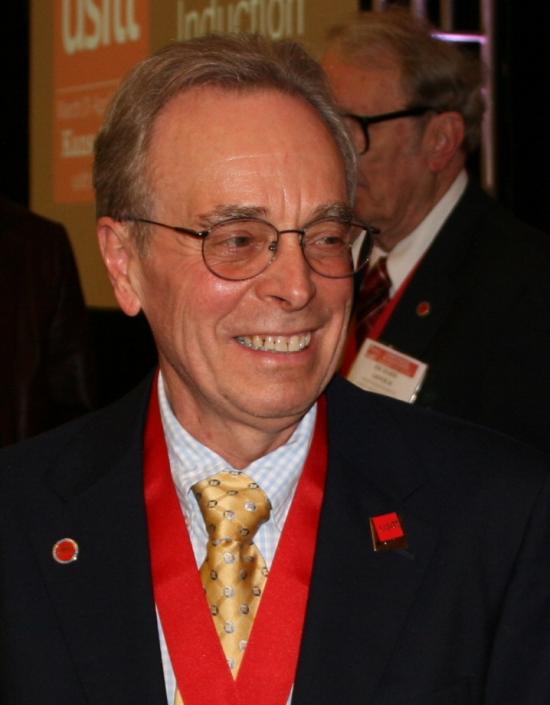

Randy Earle
Your earliest memories of the Institute?
I joined USITT in 1965 as a student member while a student at Purdue University. Can you believe the yearly dues were $5.00? My first contact was with Richard Thompson who signed me up for the Architecture, Engineering and Presentation Committees and who made certain I received the minutes of their meetings (all of which were held in NYC).
My first direct involvement was as part of the San Francisco Conference Committee which also was the first conference I attended. This event had a profound effect on me and resulted in my becoming active in the Institute. Since then, I’ve attended all conferences with the exception of 1990.
Favorite USITT memories?
- Passing the hat at the Top of the Mark Hopkins Hotel to collect funds for the “No Host” bar tab that was miscommunicated to the hotel management as “Hosted” was an early introduction to financial management.
- Winning the Scenography Exposition prize, a free one year USITT membership, in 1984 may have been my greatest embarrassment, as I was part of the team that created the raffle. With the Institute’s finances in a somewhat precarious situation, I elected not to collect the prize.
- Finally, the start of our first endowment, later named the Edward F. Kook Fund, at a board meeting where everyone present agreed to pull out their checkbooks and replace talk with action.
Short list of career highlights
My major professional work has been as professor of theatre design and technology since 1968 with two years at Purdue University and 38+ at San Jose State University. Assignments have included head of theatre program, technical director, lighting designer, sound designer and scenic designer.
In addition, since 1970, I have been a practicing theatre consultant and, since 1985, been a partner in Pantechnicon LLC
Short list of your involvement in the Institute:
I began as Commissioner for Performing Arts Training and Education, later renamed the Education Commission.
Subsequent offices held included Vice President for Commissions and Projects and Vice President for Relations prior to election as President Elect in 1984 and a two year term as President 1985 -86.
Other service has included membership on the Nominations, Endowment Management, Grants and Fellowships and Art Auction Committees.
In 1982, I was made a Fellow and since 1998 I have been the Fellows Chair.
If you were to make a short list of the memorable USITT characters that have made a difference to you, who would they be?
Eddie Kook, Dr. Snodgrass a.k.a. Harold Burris-Meyer, Dr. Doom a.k.a. Randy Davidson, and Sam Scripps.
Then again, most of us in USITT are characters in our own inimitable way, aren’t we?
Anything you want to say about being a Fellow?
When I was named a Fellow after looking at the list of Fellows, I was somewhat overwhelmed feeling as though I was standing among the giants of our industry.
I have never lost that sense of awe as I’ve seen the new Fellows join our ranks bringing additional stature to our group. I am proud of being a member of such a distinguished group of men and women.
List of books that you recommend about stage lighting:
- The Art Of Stage Lighting by Frederick Bentham;
- Light Fantastic by Max Keller;
- Stage Lighting Design by Richard Pilbrow;
- The Magic Of Light by Jean Rosenthal.
Mentoring?
I am happy to mentor students and young professionals with an interest in theatre facility planning, architecture, consulting and design. I am always available to mentor students and faculty on careers in academic theatre.

David Flemming
(1928-2003)
Education/Training:
- Adelphi College, BA in Arts and Graphics (1951)
- Cornell University, MA in Theatre Arts (1953)
Employment History:
- U. S. Navy (1944-1946)
- Faculty, Wichita State University (1953-1968)
- Southwest Texas State University (1970-1996)
Publications:
- Author and editor, USITT Internship Directory; six editions (1988-1996)
- Author, How to form a Student Chapter of USITT; Adopted as an official Institute publication (1983)
- Editor, USITT Texas Regional Section Newsletter
USITT involvement and offices held:
- Board of Directors, both National and Texas Section, multiple terms
- Vice Commissioner of Health and Safety Commission (1981-1983)
- Nominating Committee (1982-1984)
- Membership Committee ((1982-1983)
- Vice Chair of Programming for the Corpus Christi conference (1983)
- Student Chapter Liaison (1984-1996)
- Chair of the Texas Regional Section ((1983-1985)
- Secretary, Historian, and Chair of the By Laws Committee, Texas Section (1981-1996)
Awards and Honors:
- Elected USITT Fellow (1996)
- Special Citation for work as Student Liaison (1995)
- Honored as a Professor Emeritus, Southwest Texas State University (1996)
- Texas Section Distinguished Service Awards (1990 and 1995)
- Texas Section Founders Award (1992)
- Texas Section Lifetime Membership Award (1997)

Gary W. Gaiser
(1909-1994)
Education/Training:
- Bowling Green State University, BA Humanities (1933)
- Bowling Green State University, BS Education (1935)
- Ohio State University, MS in Literature, Speech and Theatre (1937)
- University of Iowa, PhD in Theatre History (1953) and Dramatic Arts (1954)
Employment History:
- High School Teacher (1935-1943)
- Instructor, State University of Iowa (1943-1944)
- Professor, Indiana University (1944-1980)
- Theatre Consultant for Indiana University system at the Gary, South Bend and Kokomo campuses
Publications:
- Newsletter Editor, Educational Theatre Association
- Editorial Board and Associate Editor, Theatre Design and Technology (1965-1972)
- Guest Editor of TD&T (1967-1968)
USITT involvement and offices held:
- Chair of USITT Publications Committee (1965-1980)
- Board of Directors
- Chair of the first USITT conference held outside New York City (Bloomington, IN 1965)
- Senior Delegate to the Fourth Congress of OISTAT in Prague (1976)
Awards and Honors:
- Elected USITT Fellow (1977)
- U. S. Representative to the First International Scenography Conference, Paris (1957)
- Chair, ATA convention, Chicago (1972)
- Joel E. Rubin Founders Award (1976)


Sarah Nash Gates
(1949-2015)
Read a Memoriam of Sarah Nash Gates
Your earliest memories of the Institute?
I attended the 1976 Conference in Anaheim at the suggestion of the TD at the college where I was teaching. I had never heard of USITT, but the college would pay for the trip, so off I went. I was thrilled to see and in some cases meet such noted authors as Harold Burris Meyer, Oren Parker, and Mordecai Gorelik! And of course Ed Kook. I attended a meeting of a “Costume Interest Group” and found 100+ people crowded into the meeting room. A lively conversation revealed a group eager to make things happen. Imagine the shock when President Richard Arnold told us we could NOT be “An Interest Group”. And then the cheer as he continued – You MUST be a Commission! Yes, it was the birth of the Costume Design & Technology Commission and I was hooked on USITT.
Favorite USITT memory?
It is not possible to have only one. Here are some serious highlights:
- Riding a horse into the Banquet as President in Wichita
- The PQ in 1983 (learning to play menu darts with Pine and MacKay) and 1987 trips, and 91, 95, 99. These included many performances including a visit to the theatre collective Gardzienice in Poland where we witnessed a performance in a small barn lit entirely by candles stuck in loaves of bread.
- Dinner at Josef Svoboda’s home where he and Helmut Grosser reminisced over their many collaborations.
- The friendships forged in lengthy Finance Committee meetings, and Board meetings.
- Getting to know so many people outside of my usual world – Consultants, Business people from across the profession, code specialists, engineers, etc.
Short list of career highlights:
- Executive Director of the University of Washington School of Drama 1994 – 2014.
- President of the University/Resident Theatre Association 2007 -2010
- President of USITT 1991 – 1994
- Freelance Costume Designs for: Oregon Shakespeare Festival, Pennsylvania Opera Theatre, Seattle Opera, 5th Avenue Theatre, ACT Seattle, Denver Center, a couple of Bus and Truck tours (Showboat twice in 12 months!), Seattle Children’s Theatre, and some memorable designs at the UW – Britten’s A Midsummer Night’s Dream, Magic Flute.
- Designs included in the 1987 and 1991 US Exhibit to the Prague Quadrennial.
- Teaching gigs at Stephens College, SUNY Fredonia and Ringling Brothers Barnum and Bailey Circus Clown College.
- Member National Theatre Conference
Short list of your involvement in the Institute:
- First woman and first costumer to serve as USITT President 1991 -1994.
- Multiple terms Board of Directors 1980 - 1990
- Chair of the Finance Committee 1984 - 1990
- Lead USITT delegation to the OISTAT World Congress in Caracas
- OISTAT Scenography Commission meetings in Seoul, Helsinki/Stockholm (included first visit to Drottningholm! Talk about a sacred space!)
- Co-Chair Costume Symposium 1987
- Member Awards Committee, Nominations Committee
- Co-Founder of Young Designer’s Forum
- Founder’s Award 1995
If you were to make a short list of the memorable USITT characters that have made a difference to you, who would they be?
Here again it is almost impossible to list everyone – I am bound to leave someone out!
My chief USITT mentors are Richard Arnold and Joel Rubin who helped me learn both USITT and OISTAT history and navigate my early years of USITT membership.
Significant colleagues/collaborators Chris Kaiser, Arnold Aronson,
Friends, Friends, Friends: Pat MacKay, Tim Kelly, Leon Brauner, Bob Benson, Rick Stephens, Joy Emery, the Brockman brothers, Eric Fielding, Randy Earle, Dick Devin, Louis Bradfield
Anything you want to say about being a Fellow?
It is a great honor to be recognized by ones colleagues/peers. I always have felt that my election in 1989 was a touch premature – but I have tried to be worthy of the honor ever since!
Anything you'd like to add about what the USITT means to you personally?
It is a unique place where you can learn a great deal, meet many interesting, helpful and fun people, have unique experiences (touring St. Paul’s in London with Oren Parker listening to him think about how to draft “the sucker” or Millia Davenport talk about visiting the pyramids and working with Robert Edmund Jones) and perhaps most importantly, help others do the same.
One of my favorite things to do is attend the sessions which highlight the careers of our Distinguished Achievement Award Winners. It doesn’t matter what their specialty is. What matters is their passion and dedication to art and industry of theatre.

Arnold Gillette
(1904-1989)
Education/Training:
- University of Montana, BA (1928)
- Yale University School of Drama, MFA (1931)
Employment History:
- Professor, University of Iowa (1931-1971)
- Instructor of Scene Design and Production Technique
- Designer and Technical Director
- Director of the University Theatre (1956-1971)
- Full Professor (1949-1971)
- Editor’s note: Mr. Gillette, through his textbooks and longevity at one of the most prestigious university programs in the country, was considered one of the most influential teachers of theatre design during the middle of the last century.
Publications:
- Author, Stage Scenery: Its Construction and Rigging (1959, rev. 1973)
- Author, An Introduction to Scene Design (1967)
USITT Involvement and offices held:
- Behind the scenes mentor, mediator and activist in the 1960s and 1970s
- Board of Directors
Awards and Honors:
- Elected USITT Fellow (1989)
- USITT Award for his Lifetime Contribution to the Profession (1973)
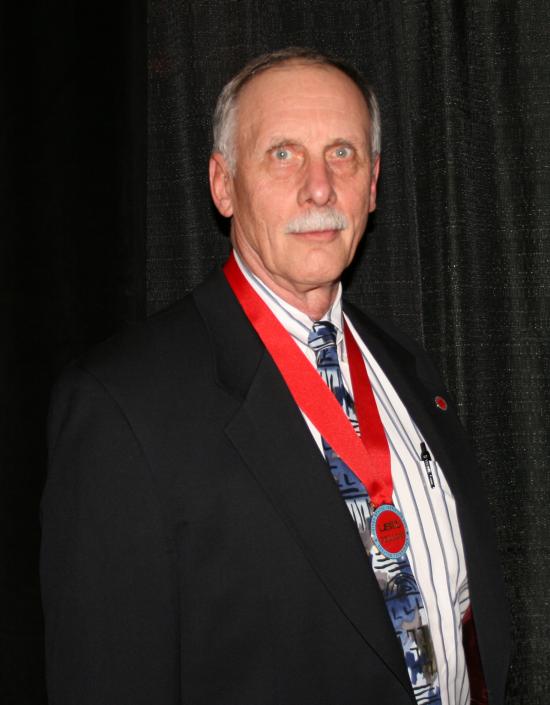

Jay O. Glerum
(1939-2014)
Read a memorial of Jay O. Glerum
Glerum was hired as an assistant professor in Seattle University's Drama Department in the School of Arts and Sciences in 1965 after serving as its part-time stage carpenter and designer for two years, during which he worked full-time at the USPS. As the sole earner for his growing family, he moonlighted during the mid-1960s and early 1970s with the International Alliance of Theatrical Stage Employees union (IATSE) Local 15 in Seattle as a part-time extra. During academic breaks, he worked for the Seattle Repertory Theatre as a stage carpenter and served as the technical director for Seattle's A Contemporary Theatre (ACT) for its 1970 summer season.
He accepted a faculty position at Marquette University in Milwaukee, Wisconsin, in 1972 where he was an assistant professor and technical director for the Drama Department of Marquette's School of Speech. In that capacity he oversaw technical requirements of the soon-to-be-built Evan P. and Marion Helfaer Theatre, consulting on both front-of-house and backstage design for the teaching and performance spaces. Determined to continue interacting and working with tech-theatre professionals in order to provide students with accurate, up-to-date curricula, he also worked as part-time extra for IATSE Local 18 in Milwaukee.
In 1980 Glerum joined Peter Albrecht Company, Inc., a Milwaukee company known for its design and manufacture of custom stage rigging systems where he was a project manager and stage system designer. In that capacity, he designed technical systems for venues in the U.S., South America, and Asia, working with architects and engineers. It was during this period that he began writing Stage Rigging Handbook, having witnessed first-hand for more than two decades what he considered a universal need for stage-rigging safety protocol.
In 1986 he joined the University of Washington faculty as a lecturer and head of its graduate Technical Theatre program, and he and his wife returned to the Seattle area. Soon after the release of Stage Rigging Handbook in April 1987, he founded his company, Jay O. Glerum, Inc. on July 15, 1987, to sort out the increasing demands for his services as a consultant. On April 4, 1990, he amended the company's name to Jay O. Glerum & Associates, Inc., to better represent collaborations done when he contracted with other specialists in the entertainment industry. He remained the company's only employee, however, for the duration of its existence.
While Glerum was at the University of Washington, campus development and strategic placement of new buildings meant the removal of its small arena theater, the Penthouse, built in 1939 by the WPA and the first theater-in-the-round in America. The idea for theatre in the round had been conceived by Glenn Hughes, head of the Drama Department at the University of Washington from 1930 to 1961. Demolition of the Penthouse was scheduled to make way for a new Physics Building in1990. Glerum recalled hearing from Hughes, then an Emeritus Professor, that the Penthouse was designed to be movable, and only when Glerum researched and located the original plans in the UW archives, did the possibility of saving the Penthouse become a reality. The University revamped its plans for the small 165-seat theatre's demolition and agreed to move it to a different location on campus. It was subsequently refurbished, renamed Glenn Hughes Penthouse Theatre, and was reopened in its new location on campus in 1991.
As Glerum's work became nationally recognized, he resigned his position at the University of Washington in 1992 to be a full-time consultant to the entertainment industry, focusing on inspecting rigging systems, consulting on new construction and renovation of theaters, teaching rigging seminars for professional stagehands, and training employees of entertainment parks and performance centers. In its early years, the company also accepted expert witness work, but by 2000 he had eliminated that side of the business. He dissolved the company, a Washington State corporation, effective Feb. 24, 2014.
When he turned sixty, Glerum determined that he wanted to spend the remainder of his working life focusing on safety inspections and master classes. To that end, he would cease consulting with architects and engineers on construction and renovations of physical theater buildings. To close out that part of his career, he accepted his last consultancy project for Main Stage Theatre in Olney, Maryland (which was completed in 2000), the venue of his first foray into professional theatre with the Catholic University Players.
Although he accepted fewer jobs after entering his seventies, Glerum remained engaged and passionate about his work and never retired. He upheld his agreement to teach a pre-conference two-day master class for United States Institute for Theatre Technology (USITT) at the March 2014 conference in Fort Worth, Texas, despite a terminal illness. He died in June of that year.


Helmut Grosser
(1927-2010)
Read a memorial of Helmut Grosser
Education/Training:
- Passed Stage Technical Master exam (1949)
- Passed Stage Lighting Master exam (1950)
- Apprenticeship, City of Dresden, GDR (1945-1949)
Employment History:
- National Opera Theatre, Saxony, German Democratic Republic (1950-1953)
- Technical Director; Hagen, Weisbaden and Cologne Operas (1953-1971)
- Technical Director and Production Director; Staatsoper, Munich (Bavarian National Opera House) (1971-1992)
Publications:
Editor, Buhnentechnische Rundshau (1977-1997?) Editor’s note: This is the oldest technical theatre periodical in the world, published continuously since 1907.
USITT and OISTAT involvement and offices held:
- OISTAT Founding Member (1968)
- Chair, OISTAT programming committee (1974-1978)
- President, OISTAT (1978-1997)
- Series of Master Classes throughout the U.S. for Universities and USITT Sections (1973)
- German Association of Theatre Technicians (DThG): Member (since 1966); Member of the Board of Directors (1968-1983); President (1976-1983)
Awards and Honors:
- Elected USITT Fellow (1997) Editor’s note: Mr. Grosser is the only non-member to ever be accorded this honor.
- USITT Special Citation (1985)
- Honorary Medal of the Federal Republic of Germany
- OISTAT Gold Pin (1997)
- Silver Honorary Medal of the DTHG
- Holder of the Linnebach Gold Ring
- Editor’s note: Within the German theatre world the most significant honor is to be the bearer of the legendary Linnebach Gold Ring. This artifact is a special tribute passed from the most outstanding Technical Director of each generation to a successor of the next generation and is passed down only in the final will of the current holder.

Bernard Grossman
(died 1990)
Employment History:
Attorney at Law in private practice, One Wall Street, New York, NY for over 50 years
Publications:
As Chair of the Federal Bar Councils’ Committee on the Theatre:
- Symposium on Copyright Problems (Two volumes)
- Symposium on Financing a Theatrical Production (500+ page volume)
- Symposium on Subsidiary Rights and Residuals (200+ page volume)
- Symposium on the Business and Law of Music (110 page volume)
- Symposium on Government Subsidies
- Symposium on Private Not-for-profit Corporation Subsidies for Theatre
Member of the Editorial Board, Performing Arts Review
Member of the Editorial Board, The Journal of Management and Law of the Arts
USITT involvement and offices held:
USITT General Council for over twenty years (1960-1980?)
Awards and Honors:
- Elected USITT Fellow (1977)
- Past President and Honorary Life Member, Federal Bar Council
- Past President and Honorary Life Member, Consular Law Society
- Past General Council, Actors Equity Association
- Past General Council, New York Academy of Sciences
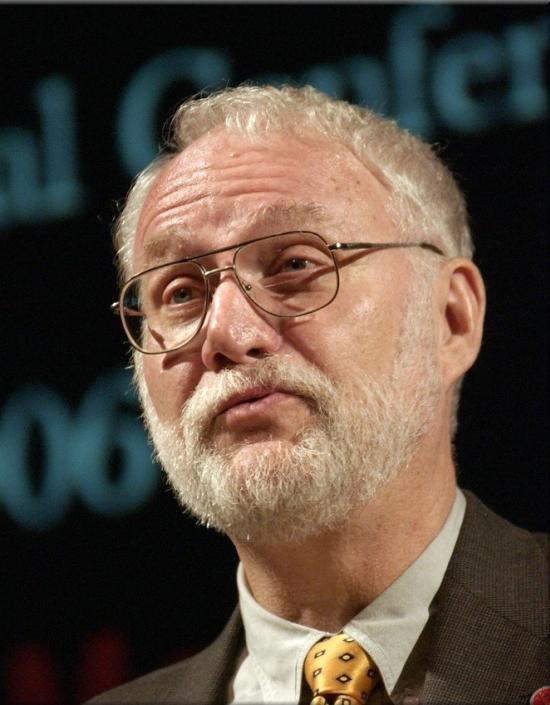

Larry Hill
(1942-2020)
Your earliest memories of the Institute?
In 1973, I gathered students from the University of North Dakota to attend the conference in St. Louis and escape the cold. This began a March tradition--getting students to a place where they could learn about their personal theatrical interests. This group began planning for 1975 in Anaheim. The impact of these treks reflects how engaged the students became by their attendance at the Conference.
Favorite USITT memory?
Traveling with USITT sponsored groups to the Prague Quadrennials, Greece, and Italy gave a wonderful opportunity to realize the breadth of specialties and responsibilities of the members in the industry.
Short list of your involvement in the Institute:
- Founding Member Board of Directors (6 yrs.), Northern Boundary Section
- Chair of Programming, 1987 National Conference and Stage Expo in Minneapolis
- Member-at-large, USITT Board of Directors & Chair of Finance Committee,1990-96
- Treasurer, USITT 1996-1999, 2002-2007
- Grants & Fellowship Awards Committee & Archives Committee 1999-2007
- Joel E Rubin Founders Award 2005
- Co-Chair ot the USITT @ 50 fund raising campaign
Short list of the memorable USITT characters that have made a difference to you?
The importance of Richard Durst, C. Lance Brockman and Jean Montgomery in creating the Northern Boundary Section has carried through decades of research, continuing service to USITT, and retirement. Sylvia Hillyard Pannell’s generosity in introducing me to the South was a blessing. I will never stop praising the women and men who served the USITT Finance Committee----they brought wisdom and patience to benefit us all. A special nod goes Christine L. Kaiser, Van Phillips, Sarah Nash Gates, Richard Arnold, and William J. Byrnes
Being a USITT fellow means:
Committing to a leadership role in USITT involves a heavy commitment of time and energy that is willingly given. For those in education, we know the benefit of membership to our students. The ongoing expansion of USITT in meeting the future of the industry was, and is, the “Pat on my back” for the involvement.
What does USITT mean to you?
The lasting memories of 50 plus years in USITT are the richness of being involved with the members. The Annual Conference and Stage Exposition always found increasing numbers of travel buddies to share their lives. The blend of former students, travel friends and the conference was a yearly adventure. This was highlighted by the five year USITT @ 50 fund raising campaign celebrating its 50th year. The student attendees to the conferences gave a huge contribution of energy to the campaign. The Fellows, and longtime sponsors of USITT, led the eorts to put a solid financial base for the various named awards that recognizes the work of our members.
Publications:
- Dives and Diversions: The variety theaters in early Minneapolis, Hennepin County History (Fall 1998): 4-10.
- Maxwell Anderson Conference, Catalog and Exhibition. Original 200+ design plates for the premiere performances of the Playwright Maxwell Anderson.” North Dakota Museum of Art. Grand Forks, ND, October 1983. Guest Speakers and panelists included: Howard Bay, Donald Stowell, John Rothgeb, Arthur Ballet, Lee Watson, Alfred Shivers.
- The Twin City Scenic Collection: Popular Entertainment 1895-1929. Ed. C. Lance Brockman. “Late Nineteeth-Century Popular and Theatrical and Events in Minneapolis-St Paul.” University Art Museum, University of Minnesota, March 1987. A catalog prepared for the museum and touring exhibit. Exhibition funded by NEH.
- Catalog essay for NEH Funded exhibition: Theatre of the Fraternity: Staging the Ritual Space of the Scottish Rite of Freemasonry, 1896-1929. Exhibit conceived and curated by C. Lance Brockman at the Weisman Museum, October 1997, University of Minnesota, for a 3-year national tour. Essay for the catalog, “The Changing Light of Dramatic Initiation
- “Prague Quadrennnial 1999 Exhibits: Russia.” Theatre Design and Technology, Fall 1999, v. 35, #5, pp. 54-55. A photo-essay of Russian exhibit at the international design exhibit. Photo credit as well as essay.
- Paper presented to the Association of Theatre in Higher Education. “Making of the Cyclorama.” Washington


George Thomas Howard
(1929-2011)
Read a memorial of George Thomas Howard
Education/Training:
- Reed College (Portland), BS in Physics (1949-1951)
- Massachusetts Institute of Technology, BS in Engineering (1952)
- MIT, MS in Electrical Engineering (1953)
Employment history:
- General Electric Corporation, Large lamp division (1953-1958)
- General Manager, Kliegl Bros. Western Corp. (1965-1970)
- Founder and Principal, George Thomas Howard and Assoc. consultants (1958-2000)
Editor’s note: Credits for his theatre and entertainment facilities projects are too numerous to list. Selected highlights include: The Las Vegas showrooms for the Hilton, Stardust, Desert Inn, Bonanza and the Ziegfeld Theatre at the MGM Grand which was designed for the production Hallelujah Hollywood (1973). The mechanical and hydraulic systems for this space included double deck bridges, wagons, turntables, a band cart, a Plexiglass water tank 30’ X 9’ X 10” for a “Dolphin Girl” water ballet, a proscenium-wide “Living Curtain” which could hold cast members, front of house descending podiums for the showgirls, a retracting cantilevered passarelle at the front of the stage and an ice wagon. The integration of all of the stage mechanics into the room set the standard for the design of the Las Vegas showrooms for decades.
- Selected theatre projects include: lighting consultant for the Elizabethan and Bowmer theatres at the Oregon Shakespeare Festival, and theatre consultant for the World Trade Center in Moscow (1980), Seattle Opera House renovation(1958-1961), and the Grand Ole Opry (1970).
- Mr. Howard was a licensed Professional Engineer in 17 States.
- Life-long Member of IATSE
USITT involvement:
- Member from 1962
- Board of Directors
- USITT Delegate to numerous OISTAT International Conferences
- USITT representative to NFPA Electrical Code Panel 15 (1962-2000)
Awards and Honors:
- Elected USITT Fellow (1982)
- Founding and Honorary Member, American Society of Theatrical Consultants
- USITT Fellows Address (1995)


Ted Jones
Ted Jones knows the theatre inside and outside, from the stress of performance and the thrill of applause to the responsibilities of lighting a professional production. His formal professional education started with a Bachelor of Music degree from Henderson College and ended with a term as a Fulbright Scholar studying Technical Facilities. This background allows him to view all aspects of a theatrical program and objectively critique the needs and opportunities for the space. Ted has supervised many projects and brought them to fruition. He understands the necessary elements of rigging, lighting and the mechanical devices that comprise proper equipment to do the job. His many years as a theatre consultant have honed his ability to direct the varied activities associated with construction documentation, review of plans, and post construction assessment and training. Ted has retired from the daily activities of the firm but remains available to Jones & Phillips as an "at counsel" member of the firm. As such, he continues to work on selected projects where his background as a musician and opera singer and his years of experience as a consultant can be of service.
Project Role
- Equipment Design and Installation Inspection
- Specification, Bid, and Construction Coordination
- Facility Operations and Existing Equipment Evaluation
Education
- Fulbright Scholar - Technical Facilities. 1961-62.
- Graduate Study: Indiana University. 1957-58.
- Texas Christian University. 1956-57.
- Bachelor of Music, Henderson College. 1953.
Memberships
- United Scenic Artists, Local Union 829.
- United States Institute for Theatre Technology.
Experience
- Co-principal of Jones & Phillips Associates, Inc. 1974-1996. Consultant "At Counsel" to Jones & Phillips Associates, Inc. 1996-present.
- Director of Technical Facilities, School of Music, Indiana University. 1978-1996.
- Chairman of Department for Technical Studies in Music, School of Music, Indiana University. Developed the A.A. degrees in Stage Technology, Costume Construction, String Instrument Building and Repair, and Audio Recording. Professor of Theatre Rigging and Lighting. 1972-1996.
- Theatre Consultant. Projects include: Musical Arts Center, Indiana University - Bloomington, Indiana; New Harmony Historic Theatre Preservation - New Harmony, Indiana; Lighting System for Seattle Opera - Seattle, Washington; Rigging System Design, Indiana University - South Bend, Indiana. 1961-1974.
- Lighting Designer, professional productions include Pacific Northwest Wagner Festival Ring Cycle. 1975-1977; Die Walkure, Philadelphia. 1976.
- Sang professionally with State Fair Musicals, Dallas, Texas. 1951, 1953, 1956. Fort Worth Civic Opera. 1957.
Professional Activities & Awards
- Life Member of United States Institute of Theatre Technology, 1999.
- Fellow of the United States Institute for Theatre Technology. 1976.
- Life member for Professional Achievement, USITT. 1988.
- USITT Board of Directors. 1966-1968, 1974-1976.
- Listed "Who's Who in Theatre Consulting," Theatre Crafts. 1983.


Rodney Kaiser
Your Earliest Memories of USITT:
My earliest memories of the Institute are of the 1967 New York Conference, as an exhibitor with Kliegl Brothers. I enjoyed the conference – seeing the other exhibitors, attending some sessions, and especially meeting many new people.
Your Favorite USITT Memory:
My favorite USITT memory is moving USITT archival materials from Kansas City to Syracuse in the late 1990’s. I drove solo to Kansas City, rented a large trailer, met up with wife Chris and a group of other USITT volunteers, and loaded up the trailer with a thousand pounds or so of materials. Chris and I vacationed while driving the trailer back to Syracuse.
Your Most Memorable USITT character:
The most memorable USITT character that made a difference to me was my boss in my first full time employment, USITT Founder and Past President Joel Rubin. Joel was instrumental in my continuing to be involved in what my parents believed was not a real vocation. Larry Kellerman, a wheeler/dealer and Century Lighting employee was also someone involved with USITT who helped me successfully continue my career in theatrical equipment. In 1978 I was hired to work at J.R. Clancy, Inc. by USITT Fellow Jack Suesse. Jack, a true expert and teacher of stage rigging, Working with Jack encouraged my work in equipment design and testing and greatly expanded the horizons of the rigging work the Clancy employees undertook.
Anything you'd like to add about what the USITT means to you personally?
USITT has provided me with the opportunity to meet and know a wide variety of people, many of whom became friends as well. The opportunities to work on the creation of standards for an industry that had none when I began working in the industry, was directly related to those of us in the rigging field being able to get together to work on this extremely important project. The impact of this work will live long beyond us and I am most proud to have been a part of this work.

Peggy Clark Kelley
(1915-1996)
Read a memorial of Peggy Clark Kelley
Education/training:
- Smith College, BA in Dramatic Arts (1935)
- Yale School of Drama, MFA (1938)
Assisted numerous designers on and off Broadway including John Koenig, Donald Oenslager, Howard Bay, and Oliver Smith among others.
Assisted Oliver Smith with the lighting for Our Town in 1944 and first received critical notice.
Employment History:
Lighting Designer on Broadway for 78 productions (1941-1988). Notables include:
- Brigadoon
- Bells Are Ringing
- Bye, Bye Birdie
- Flower Drum Song
- Auntie Mame
- The Rose Tattoo
- Three Penny Opera
- Paint Your Wagon
- Pal Joey (revival w/ George Abbott)
- The Unsinkable Molly Brown
- Medea (w/ Dame Judith Anderson)
- Peter Pan
- Kismet
- Gentlemen Prefer Blondes
- The Rape of Lucretia
- Dark of the Moon
Instructor, Smith College (1967-1969)
Instructor, Yale School of Drama (1969-1970)
Publications:
All of Ms. Kelly’s design work and other papers are in the Clark Collection in the Library of Congress. Editor’s note: Ms. Kelly is considered particularly important in the history of the Broadway theatre not only because she was among the first women to design on the “Great White Way,” she was also instrumental in the development of Lighting Design as a profession.
USITT involvement and offices held:
- Founding Member
- Board of Directors
- Chair, Membership Committee
Awards and Honors:
- Elected USITT Fellow (1978)
- President, United Scenic Artists local 829 (1968) Editor’s note: Ms. Kelly was the first woman to be elected President of the organization.
- Smith College created the Peggy Clark Kelly Design Prize. This honor is given to outstanding undergraduates that demonstrate extraordinary promise and dedication in the areas of theatrical design.

Albert M. Koga
(1915-2003)
Education/Training:
- University of California at Berkeley, BS in Electrical Engineering (1940)
Employment History:
- Teacher of math and physics, camp High School, War Relocation Center, Tule Lake, CA (1942)
- Editor’s note: As a Japanese American, Mr. Koga, along with thousands of others like himself, were interred in relocation centers throughout the west after the Pearl Harbor attack. Left to their own devices, and without support services, it was up to the inmates to organize their own schools. Mr. Koga’s programs were so successful that he was soon recruited to teach first at the local town’s high school and then for the Navy V-12 program to train pilots for the war effort.
- Staff Instructor Navy V-12 program, Doane College, Crete NB (1943-1945)
- Lighting fixture designer, Steber Lighting Co., Chicago, IL (1945)
- Equipment designer, Leander Electric Co., Chicago, IL (1946-1947)
- Chief Engineer, Hub Electric Co., Chicago IL (1947-1980)
- Consultant (w/ Prof. Ted Fuchs of Northwestern University) on 250+ theatre projects throughout the U. S.
- Instructor (evenings) on stage lighting, Chicago Lighting Institute
Publications:
Co-Author w/ James Hull Miller (USITT Fellow) and/or Publisher of a series of small booklets on Flexible theatre spaces and typical lighting practice. These were freely distributed to practitioners, architects and consultants (more than 20,000 copies in the U.S. and abroad).
USITT involvement and offices held:
- Founding Member and first Chair of the USITT Midwest Section
- Long-time member of the Board of Directors
- National Conference Treasurer and Registration Chair for the USITT Chicago Conference (1968)
- Provided funding for regional scholarships for many years
Awards and Honors:
- Elected USITT Fellow (1995)
- USITT Midwest Founders Award (1995)
- Charter Member of IES-TTFL
- Honored Guest, V-12 Naval Cadet Class Reunions (1993 & 1999) Norfolk, VA


Edward F. Kook
(1903-1990)
Education:
- Pace College of Accountancy, New York City (1926)
Employment History:
- Accountant, Display Stage Lighting (1926-1929)
- Co-founded (w/ Joe, Saul and Irving Levy), Century Lighting Company (1929-1964)
- Editor’s note: Century was one of the foremost stage lighting and rental companies in the New York theatre for almost 40 years. In his obituary, the New York Times noted that Mr. Kook and Century had “brightened more than 1000 Broadway plays.” In 1937 the firm introduced the “Leko” (compounded from the names of Joe Levy and Mr. Kook) ellipsoidal reflector spotlight. This terminology was still common practice more than 50 years later. The business was bought out and renamed Lighting Corporation of America in 1964 and Mr. Kook remained with the company as V.P. to smooth the transition until 1968.
- U. S. Army, Office of Strategic Services (O.S.S.; Forerunner of the modern day C.I.A.) (WWII 1942-1946)
- President of Century Lighting Company (1946-1964)
- Founder and President, Portovox Inc., (maker of permanent and portable wireless microphones and accompanying transmittal sound equipment) (1946-1964)
- Co-founder (w/ wife Hilda) and Chair, Arts of the Theatre Foundation (provided awards and grants to new playwriting students and educational theatrical projects) (1947-1960)
- Lecturer in stage lighting, Columbia University and Yale School of Drama (1953-1958)
- Board of Directors, Phoenix Theatre, NYC (1957-1963)
- Lighting Consultant (W/ Partner Jo Mielziner) for dozens of projects throughout the U.S.
Publications:
- Author, Images in Light for the Living Theatre, (funded by a Ford Foundation Grant) (1963)
- Author, “History of Stage Lighting” for Encyclopedia Britannica
- Author, “The Idea of Living Light” for The Best Plays of 1956-1957
USITT involvement and offices held:
- Chair of the Engineering Commission
- 2nd Vice President (1973-1975)
- President (1975-1977)
Editor’s note: Mr. Kook is generally credited with personally guaranteeing USITT finances during a time of fiscal peril in the early 1970’s. He also provided the original seed money for the creation of the USITT research fund that today bears his name.
Awards and Honors:
- Elected USITT Fellow (1977)
- Joel E. Rubin Founders Award (1974)
- First USITT Lifetime Membership Award (1985)
- Antoinette Perry Award (“Tony” 1952) Special Citation for “contributing to and encouraging the development of stage lighting and electronics”
- Kelcey Allen Award (1962) for “his contribution to the advancement of theatre lighting”
- Ford Foundation Grant to study scenic projections (1961)

Rudolf Kuntner
(1908-1982)
Education/Training:
Apprenticed and trained as an electrician in various shops in the New York area including Brisma Specialties, the Ziegfeld Theatre, and Kliegl Bros. Lighting ; eventually gained union membership.
Employment:
Worked as lighting crew chief and Chief Electrician in various Broadway theatres including the Adelphi Theatre, Earl Carrol Theatre, 46th Street Theatre, and the Metropolitan Opera House (1930-1951)
Promoted to Lighting Designer and Director of Stage Operations for the Metropolitan Opera (1951-1975)
Editor’s note: While at the Met Mr. Kuntner was credited with the lighting design for over 80 operas, and was especially renowned for his staging of “Tristan and Isolde” (1971). Mr. Kuntner was one of the first American lighting designers to be credited as such in the opera world and was very important in the eventual recognition of lighting design as a profession.
USITT involvement and offices held:
- Founding member
- Longtime member of the Engineering Committee
- Hosted several tours of the Metropolitan Opera’s facilities during USITT conferences held in New York City during the 1960s
Awards and Honors:
- Elected USITT Fellow (1977)
- Member of the U. S. Soccer Team for the 1928 Olympics
- Inducted into the National Soccer Hall of Fame (1963)

Tom Lemons
Your earliest memories of the Institute?
My first conference was the 1966 Toronto Conference and then I attended them regularly until I started my consulting business in 1970 when I attended about every other until 1980 where I was absent when I was made a Fellow and didn't learn about it until months after the Conference when Peter Sargent (USITT Secretary) sent me my Fellows certificate. My next conference may have been when I spent a day at the Boston Conference in 1995 and then nothing until the Cincinnati Conference in 2015.
Favorite USITT memories are getting to know:
- Tom DeGaetani--who worked with my original business partner in Europe in the 1950s.
- Joel Rubin--other than as a Kliegl employee.
- Don Swinney (and wife) who had been at the Civic Theatre in Indianapolis and became friends with my parents.
- Ned Bowman who dated my sister at IU.
Short list of career highlights:
- Started a theatre lighting and sound company in 1950.
- Worked for Sylvania after college (1956 - 1970) and developed TH lamps for theatre lighting.
- Started my consulting business in 1970 was still going strong decades later.
- In May 2014, I finally cleared out and sold my office building which was filled with stuff I had accumulated over 50+ years starting when I was at Sylvania. I sent a lot of lamps to the USITT to use in their "yard sale" at the Cincinnati conference (as part of the Art Auction to benefit the Kook Fund) and so I went to it to help sell them.
- I’m a member of many societies, including: IESNA -Illuminating Engineering Society of North America, CIE - International Commission on Illumination, IDA -- International Dark-Sky and the USITT
- Fellow of both the IESNA and USITT.
Short list of your involvement in the Institute:
USITT Board of Directors and New England Section
Memorable USITT characters that have made a difference to you:
See list above and add Ed Kook.

Charles Levy
(1922-1985)
Education/Training:
- Graduate, Yale School of Drama (1951)
- Passed union exam to become an Associate, United Scenic Artists local 829 (1963)
Employment History:
- Usher, Paramount Theatre, Brooklyn (1940-1941)
- U. S. Army; POW held in Germany, WWII (1942-1945)
- Director of Research & Development, Century Lighting (1951-1969, 1972-1983)
- Editor’s note: While at Century Mr. Levy was responsible for the development and design of the Light Palette control board and Century’s first computerized lighting control systems.
- Freelance Lighting Designer for numerous Off Broadway shows
- Associate, David A. Mintz, Inc., Consultants (1969-1972)
- Consultant, Colortran Lighting (1983-1985)
- Executive for Theatre Services, Four Star Stage Lighting (1983-1985)
USITT involvement and offices held:
- Founding Member
- Board of Directors
- Secretary (1969-1970)
- Finance Committee (1980)
- Chair, New York Section
Awards and Honors:
- Elected USITT Fellow (1982)
- Joel E. Rubin Founders Award (1985)

James Hull Miller
(1916-2007)
Read a memorial of James Hull Miller
Education/Training:
- Princeton University, BA in English Literature (1939)
Employment History:
- Technical Director for a procession of small theatres including: Easthampton, NY; Locust Valley Theatre, NY; Stockbridge Theatre, MA (1939-1940)
- Lighting Designer, Graff Ballet Company (1940-1941)
- U. S. Army, Master Sergeant w/ 24th Armored Division, WWII (1941-1945)
- Assistant Business Manager, Goodman Theatre, Chicago, IL (1945-1946)
- Faculty, University of New Mexico (1946-1955)
- Faculty Technical Director, Centenary College, Shreveport, LA (1955-1958)
- Consultant, Majorie Lyons Little Theatre, Shreveport, LA (1955-1958)
- Founder, Arts Lab workshops (1958)
- Editor’s note: It was during the Lyons consulting commission that Mr. Miller developed his ideas on the open staging of theatre and opera. He felt that this concept of self-standing scenery and open staging could be adapted to any space and could open the world of the theatre to everyone. His subsequent teaching through the Arts Lab, its workshops, and his extensive consulting work were to become a lifelong mission to proselytize and advocate for this simpler form of theatrical presentation.
- Theatre Consultant, primarily to high schools, churches, community colleges and Little Theatres around the U. S. and abroad (1958-1988)
- Commissioned by the County Educational Authorities in Great Britain to present a series of 40 workshops on his open staging theories throughout the United Kingdom (1972)
Publications:
- Self published numerous small books and pamphlets on open staging and theatre for found spaces.
- Partnered with Al Koga of Hub Electric. Hub took over publishing of Mr. Miller’s books until the rights were sold to Merideth Publishing, Ltd. Editor’s note: To date 27 titles have been identified and several are still in print and available today.
- Authored numerous articles for periodicals including: AIA Journal, American School and University, Theatre Arts, Progressive Architecture, RIBA Journal, TABS, and Tulane Drama Review
USITT involvement and offices held:
- USITT Founding Member
- Board of Directors
- Founding Member of American Society of Theatrical Consultants
Awards and Honors:
- Elected USITT Fellow (1978)
- Two Bronze Stars for valor while serving with the 24th armored Division, U. S. Army
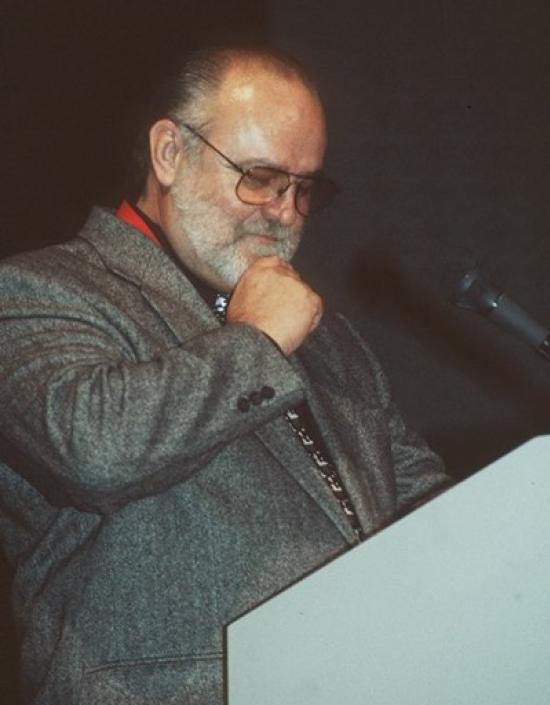

Jim Moody
Your favorite USITT memory?
The great friendships with members of the institute-- especially the other fellows
Career Highlights:
- 300 theatre projects as lighting designer
- 1800 hours of TV including Director of Photography at Entertainment Tonight, Wheel of Fortune and Jeopardy
- 12 years on the road as lighting director for concert artists such as John Denver, Linda Ronstadt, and The Eagles
- Fellow of USITT and Hong Kong Academy of Performing Arts
Short list of USITT involvement:
- Lighting Commission Chair
- Board Member
- Publications Committee Member
USITT member who have made a difference to you:
- Steve Shelley
- Will Bellman
About being a Fellow?
It will always stand out as a highlight of my career.
What does USITT means to you personally?
Meeting industry notables and discussing our industry one-on-one.
Your publications:
- The Business of Theatrical Design (2 editions)
- Concert Lighting: Techniques, Art and Business (4 editions)
Books you recommend about the field?
- The Assistant Lighting Designer’s Tool Kit by Anne E. McMills
- Lighting and the Design Idea by Linda Essig
- Scene Design and Stage Lighting by R. Craig Wolf and Dick Block
- Concert Lighting: Techniques, Art and Business by James Moody
Mentoring? Lighting, of course.

Jan Musson
(1936-2015)
USITT Fellow Jan Musson passed away suddenly on Dec. 21,2015.. At home in Goshen, KY. She was a fourth-generation Californian and graduated from Stanford University in 1957 with a BA in speech and drama. This was followed by over 10 years’ work in personnel management and small business accounting in what would become Silicon Valley.
Never satisfied withstanding still, she worked actively as a lighting designer for well over 20 years for all the leading performing arts groups in the South Bay. Next, she decided a master’s degree in stage lighting would move her career forward. She completed that degree at San Jose State University in 1974.
Jan was always the entrepreneur and in 1975 began a small stage lighting rental company in Monte Sereno, CA. That company was one of the first theatre lighting rental, sales, service, and installation firms founded, funded, and managed by a woman. It survived a major fire after moving from Los Gatos to San Jose but again, never one to be discouraged, Jan grew the firm into Musson Theatrical, Inc.--today one of the largest and most successful supply houses in the country.
Jan’s USITT work began in 1972 as a founding member of the Northern California Regional Section and a key member of the San Francisco Conference Committee. She remained active in USITT where she served as Treasurer 1984-88 and was elected a Fellow in 1996. That USITT survived some very difficult financial times during the mid-1980s is a tribute to Jan’s skill as a responsible steward of the Institute’s funds. She was also an honorary member of IATSE Local 134.
All who worked with Jan remember her as a woman with an infectious smile, unlimited generosity, and continuous support for the performing arts. She was also a strong mentor for young women and brought many into the firm helping them develop their professional careers. “No” was a word that didn’t appear in her vocabulary.

Glenn E. Naselius
(1921-2013)
When Glenn E. "Nick" Naselius died, the entertainment industry lost one of the unsung heroes of theatre and theatre education.
Bob Shook of Schuler Shook Theatre Consultants put it best, "Nick was the best kind of mentor to lighting designers. You never had to 'prove' anything to him, only that you had the right combination of inspiration, perspiration, and determination. Nick truly loved lighting, and it was contagious. He had a wonderful affinity for using color in layers that we were all in awe of. I remain in love with colored light to this day although I will never approach his level of genius with it. I was blessed to be part of Nick's 'family' at the Goodman."
I first met Nick in 1962 as a student at the Goodman Memorial Theatre and School of Drama. While Nick and I had very different approaches to lighting design (I had already designed the lighting on a number of shows), he never tried to mold me to his approach but worked with me to improve without changing how I worked. He taught and guided by example, not by direction.
We were similar in that there was nothing in our backgrounds that suggested theatre would become our life's work. Nick was a math teacher, and I was studying mechanical engineering. I graduated with a BFA in 1965 and spent the next year in Phoenix and then Detroit. By the fall of 1966, I was back at the Goodman as Nick's assistant, head electrician, and completer of the famous "other duties as assigned."
Over the next six years I designed between two and three shows for the six-show Main Stage series. During this time, he never reviewed my designs or, for that matter, ever directly commented on a design, leaving me to rise or fall on my own. Somehow I always knew, after the show opened, what he thought.
Nick became a Fellow of the Institute in the second class of Fellows in the late 1970s. It was at his urging that I became a USITT member at the 1968 convention that took place in Chicago. Even though Nick could have gone out on his own as an extremely gifted lighting designer, he chose to remain as a teacher and mentor to theatre lighting designers and technicians. He will be sorely missed by those who studied under him, and the theatre will be poorer for his passing.
Remembrance by Jerry Gorrell

Forrest Newlin
(1938-2002)
Education/Training:
- Kansas State Teachers College (later renamed Emporia State College): BA in Theatre and Art; BA in Education; MA and MS in Speech and Theatre
- Idaho State University, graduate work
- University of Nebraska-Lincoln, PhD in Speech and Dramatic Art
Educational History:
- Faculty, Idaho State University
- Faculty, KSTC (renamed Emporia State University)
- Faculty, Texas Tech University
- Faculty, Southern Methodist University, Dallas TX
- Faculty, University of Nebraska-Lincoln
- Faculty, University of Oklahoma
- Fulbright Scholar at the National Institute of the Arts and the National Taiwan University in Taipei (1985-1986)
- Faculty and Department Chair, Texas Christian University (1993-2002)
- Faculty, TCU’s London Center, several summer terms
- Editor’s note: Dr. Newlin was also an active freelance theatrical designer throughout his career with dozens of credits at such diverse venues as: 1992 World’s Fair in Seville, Spain; Musicals at the Burt Reynolds Dinner Theatre; and the Golden Hills Theatre where he designed a production of “Annie Get Your Gun” directed by Joshua Logan.
Design Exhibitions:
- USITT Biennial Design Expos
- Solo Exhibits: USITT Texas Design Showcase; University of Minnesota; Morehead State University, Kentucky; University of Arkansas: Tarkio College; Chico State University
- A special retrospective of his work at the USITT Conference in Minneapolis (2003)
USITT involvement and offices held:
- Chair, USITT National Conference, Ft. Worth, TX (1996)
- Programming Chair, USITT National Conference, Corpus Christi, TX (1983)
- Board of Directors
- Vice Commissioner for Heritage for the Scene Design Commission
- Treasurer, Texas Section (1978-1979)
- Board of Directors, Texas Section
- Presenter at numerous USITT national and sectional conferences
Awards and Honors:
- Elected USITT Fellow (posthumously, 2004)
- Received two Outstanding Service Awards from USITT Southwest
- Past President and Fellow of the Southwest Theatre Association
- Lifetime Achievement Award, Southwest Theatre Association
- Distinguished Achievement Award, Southwest Theatre Association
- College of Fellows, ATHE
- Distinguished Alumni Award, Emporia State University
- Award of Appreciation, University of Oklahoma

Ronald Olson
(1938-1989)
Education/Training:
- Moorhead State University, Minnesota, BA (1959)
- University of Nebraska, MA (1963)
- New York University, PhD (1978)
Employment History:
- Staff, Century Lighting (1964-1970)
- Assistant Director of Marketing, Strand Century Lighting (1970-1978)
- Director of Marketing, Kliegl Bros., (1978-1995)
- Faculty, Pima Community College, Tucson, AZ (1985-1989)
Publications:
- Masters Thesis, “The Lighting Theory and Practice of Jean Rosenthal” (1963)
- Doctorial Dissertation, “Edward Kook: Link Between the Theatre Artist and Technician” (1978)
- Editor’s note: Dr. Olson was a prolific author whose vita lists many pages of additional articles, criticisms, essays, papers, and reviews stretching over more than 20 years.
USITT involvement and offices held:
- President, (1982-1984)
- Vice President for Liaison and Relations (1978-1980)
- Secretary (1975-1977)
- Treasurer (1974-1975)
- Board of Directors
- Finance Committee
- Chair, USITT New York Section (1973-1975)
- Vice Chair of the National Conference, New York (1974)
- National Newsletter Editor (1985-1988)
Awards and Honors:
- Elected USITT Fellow (1978)
- Joel E. Rubin Founders Award (1979)
- Moorehead State University Distinguished Alumni Award (1980)

W. Oren Parker
(1911-2007)
Education/Training:
- University of Michigan, School of Architecture, BS of D, (1934)
- Yale University School of Drama, MFA, (1940)
Employment History:
- Faculty, University of Texas (1945)
- Faculty, Yale University (1946 -1963)
- Faculty, Carnegie Institute of Technology (now Carnegie Mellon University, Pittsburgh, PA), (1963-1976)
- Freelance Designer, more than 150 sets for plays, ballets, and television shows for CBS, Westport Country Playhouse, Pittsburgh Civic Light Opera, Pittsburgh Opera, Goodspeed Opera House, and for industrial productions for Coca-Cola, American Motors and General Motors
- Architectural and Theatre Consultant for numerous theatres in the Pittsburgh area.
Publications:
- Author, Scenic Design and Stage Lighting 1963, with Harvey K Smith (8 editions since); R. Craig Wolf oversaw the stage lighting portions of the text after the 3rd edition
- Author, Sceno-Graphic Techniques (1957, 2nd edition 1964); Editor’s note: This was the first text to standardize drafting for theatre.
USITT Involvement and Offices Held:
- Member since 1963
- Board of Directors
- Long-time Chair of the USITT Graphic Standards Committee
Awards and Honors:
- Elected USITT Fellow (1986)
- USITT Award for outstanding lifetime contribution to the Profession (1986)
- Professor emeritus of drama, Carnegie Melon University
- Namesake of Carnegie Melon University, School of Drama’s W. Oren Parker Award for Excellence in Design and Production
- Rockefeller Fellowship (1938-1939)
- Member, United Scenic Artists, AETA, Michigan M Club, Michigan Union, Yale Dramatic Assn, and Yale Drama Alumni Assn

Edward Peterson
(1932-2009)
Read a memorial of Edward Peterson
Education/Training:
- Princeton University, BA in American Civilization (1954)
- Graduate studies, Yale University, School of Drama
Employment history:
- U.S. Army Television Center, Korean War
- National Sales Representative, Kliegl Bros Stage Lighting (1964-1975)
- National Sales Representative, Berkey Colortran (1975-1976)
- Partner, Peterson/Vine Associates, (1976-2007) Editor’s note: P/V Assoc. was a full service licensed stage, equipment and installation contractor (rigging, lighting, audio, draperies, electro-mechanical stage equipment and controls, facility coordination — for theatrical, television, gaming industry: show rooms, lounges, and public areas, churches, and other illumination projects.)
- Projects of note included: Las Vegas: Mirage (1500-seat cabaret-configured show room with 116’ wide proscenium with passerelle opened with Siegfried & Roy’s new act; Caesar’s Palace (day-to-night-to-day sky feature at The Forum was considered by Time Magazine to be one of Las Vegas’ most unique hightlights); Treasure Island, and The Bellagio
- Lighting consultant, IBM tradeshow exhibits
USITT Involvement and Offices Held:
- Founding member
- Treasurer (1965-1966 & 1973)
- 2nd Vice President (1967-1968)
- Special Liaison, Board of Directors (1968-1969)
- Technical Secretary (1969-1970)
- Director at Large, Board of Directors (1968-1969; 1971-1973; 1975-1977)
- Chair, Awards and Resolutions Committee (1974-1979) Editor’s note: It was during Mr. Peterson’s term as Chair that he was instrumental in the creation of the Fellows of the Institute.
- Vice President for Conferences (1981)
Awards and Honors:
- Elected USITT Fellow (1977)
- Member, Key and Seal Club and Triangle Club, Princeton University

George F. Petterson
(1920-1989)
Education/Training:
- Illinois Institute of Technology, graduate
Employment history:
- Volunteered as a stage hand at Mundelein College at age 14 (1935)
- Set Designer, Mundelein College at age 19 (1939)
- U.S. Army Air Corps, (World War II; see decorations below)
- Technical director, and Theatre department head, Mundelein College, (1942-1989) Editor’s note: In addition to his production and administrative duties Mr. Petterson also taught scene design and stagecraft courses.
- Production Manager and Scenic Director for the first WGN-TV broadcasts (January, 1948-1963) Editor’s note: Mr. Petterson started WGN’s production department with a drawing board and a clothes closet for an office. From this beginning he supervised set and prop creation, makeup design and lighting. His commitment to innovative set designs won him acclaim as one of the nation’s first television production designers and technicians.
- Designer, Art Drapery Studios, (1963-1989) Editor’s note: This company was a leading manufacturer and supplier of theatrical soft goods throughout the Midwest. Mr. Petterson was the owner and president of the company at the time of his death.
USITT Involvement and Offices Held:
- Long-time Commercial Member
- Treasurer, both National organization and Midwest Section
- Founding member, Midwest Section
Awards and Honors:
- Elected USITT Fellow (1978)
- Military Honors: Purple Heart, Distinguished Flying Cross, and Air Medal
- Honored for 50 years of service and association with Mundelein College (1985)

Cynthia Poulson
(1948-2006)
Read a memorial of Cynthia Poulson
Education/Training:
- Concordia College, Moorhead, MN, BA in English (1970)
Employment History:
- Teacher, Dawson County High School, Glendive, MT (1970-1971)
- Personnel Manager, Manpower Temporary Services, Fargo, ND (1971-1975)
- Freelance Stage Manager/Theatre Technician, New York, NY (1975-1980)
- Box Office Manager, Pocono Playhouse, Mountainhome, PA (summers) (1977-1979)
- Stage Manager, Pocono Playhouse, Mountainhome, PA (summers) (1980-1982)
- Stage Manager, Syracuse Stage, NY (1980-1984)
- Production Stage Manager, Syracuse Stage/Syracuse University Drama Department, NY (1984-1987)
- Adjunct Faculty, Syracuse University, NY (1983-1987)
- Production Stage Manager, Milwaukee Repertory Theatre, WI (1987-1990)
- Associate Professor/Head of Stage Management, Professional Theatre Training Program, University of Wisconsin-Milwaukee (1991-2006)
Publications/Research:
- Co-Researcher & Co-Author (with Travis DeCastro and Rachel Durkin) of the Survey: “Stage Management Education in USITT Member Colleges and Universities”
- Report on Methodology presented USITT Conference Las Vegas (1995)
- Report on Curricula and Syllabi presented Ft. Worth Conference (1996)
- Report on Curricular Guidelines and Outcomes presented Pittsburgh (1997)
USITT involvement and offices held:
- Programming Presenter and Mentor for the Stage Management Mentoring Program
- Vice –Commissioner/Education, Management Commission
- Vice-Chair for Programming, Midwest Section (1995-1997)
- Board of Directors
Awards and Honors:
- Elected USITT Fellow (Posthumously, 2011)
- USITT Distinguished Achievement in Theatre Management Award (Posthumously, 2008)
- Namesake (Posthumously), The Cynthia Poulson Memorial Theatre Scholarship, University of Wisconsin-Milwaukee Department of Theatre

Horace Robinson
(1909-2009)
Horace Robinson, professor emeritus at the University of Oregon and theatre education pioneer, died recently in Eugene, Oregon. Mr. Robinson joined the university faculty as technical director and scene designer, and became the director of the University Theatre between 1946 and 1970. In 1949, he designed a new, innovative theatre building for the campus. It was named for him when he retired in 1975, after 42 years of teaching and directing over 100 productions.
Joel Rubin, USITT Co-Founder and Past President, remembered Mr. Robinson clearly. “He had always seemed to me to be a giant in educational theatre. He was already president of AETA when I met him and, unlike most of his predecessors, took great interest in the theatre architecture and technical development committees. "Horace published definitive arguments for including working theatres in schools rather than the then prevalent 'gymnatoriums' and 'cafetoriums.' He nurtured our interest in theatre architecture, particularly the design of theatres on a scale proper for student training. I also remember Horace in board meetings of AETA. He had a stentorian voice that commanded attention, and he was normally brief and always very logical. Horace was a great mentor to those seeking to make theatre our profession, and particularly helpful to those of us who wanted to work in the more technical areas.”
USITT recognized Mr. Robinson’s contributions to the field with a Special Citation in 2008 for his “pioneering and enduring contribution to the establishment of educational theatre in America and prodigious efforts advocating for design excellence in the theatre architecture for these programs, … and extraordinary lifetime of leadership and inspiration for generations of theatre students and faculty.”
A memorial was held for Mr. Robinson on the University of Oregon campus in the Robinson Theatre, a place he had not only built but instilled with his long-standing
commitment to theatre and education.
Remembrance by Alexandra Bonds

John Rothgeb
(1928-1986)
Education/Training:
- Knox College, BA (1950)
- Studied in New York under Mordecai Gorelik
- University of Michigan, MA (1954)
- Western Reserve University, MFA (1965)
- Case-Western Reserve University, PhD (1972)
Employment history:
- Assistant to Mordecai Gorelik (1951-1952)
- Kalamazoo Civic Theatre, Designer and Technician (1955-1957)
- Faculty, University of Texas at Austin, (1958-1986)
- Fine Arts Consultant, UT Performing Arts Center (1979-1981)
- Consultant and buyer, Robert Tobin Collection
Publications:
- Co-author (with Walter R. Volbach), Problems of Opera Production, (1967)
- Guest Editor, Theatre Design and Technology, Fall issue (1976) on the Prague Quadrennial
- Contributor, Oxford Companion to the American Theatre
USITT Involvement and Offices Held:
- Founding member
- Co-founder, Texas Regional Section (1969)
- Board of Directors
- Vice President & Conference Chairman (1970, Dallas, TX)
- Member, International Liaison Committee; represented USITT at OISTAT and Prague Quadrennials on numerous occasions
- Arranged purchase prizes for the first Design Expos (1980-1986)
Awards and Honors:
- Elected USITT Fellow (1985)
- Member, United Scenic Artists, Local 350
- Founding board member, National Design Archives of the Performing Arts
- Member, American Society for Theatre Research


Joel Rubin
Your earliest memories of the institute?
Sometime in late 1959 Tom DeGaetani and I met for coffee at the suggestion of designer David Hays. That was the beginning of a series of meetings which gradually involved additional "founders" and resulted in the formation of USITT at a first conference in February of 1961.
Does anything stand out as your favorite USITT memory?
Two events stand out from the earliest years of USITT. The dinner to honor the retirement of Prof. Stanley McCandless (in collaboration with the Illuminating Engineering Society) at the 2nd conference, was the occasion of USITT's first important "award". The opening week of the New York State Theatre at Lincoln Center (1964) where USITT was given the hall on the Sunday night and attracted an audience of over 2,000 to hear the architects, designers and consultants talk about their role in the design of the facility. Architect Philip Johnson (aware of the press that the theatres "acoustics" was receiving) stepped out in front of the podium and (sans microphone) asked of the audience in a normal voice "can you hear me?" which received a standing ovation on the spot.
Subsequently the events that are highlight memories are the Josef Svoboda Scenography Master Classes in the United States; the U.S. Embassy in Prague hosting the official delegates from all countries to a celebration of the U.S. Gold Triga Winner at PQ87; many trips to "iron curtain" countries as U.S. Delegate to various international meetings.
Short list of your career highlights?
At Kliegl Bros. Lighting:
- designing the architectural lighting for the lobbies and audience chamber of the Metropolitan Opera House at LIncoln Center;
- designing the production lighting system for the New York State Theatre;
- providing the production lighting systems for the Dorothy Chandler Pavilion at the Los Angeles Music Center, and the Juilliard School at Lincoln Center to the designs of Jean Rosenthal;
- working with George C. Izenour on the production lighting systems for the Sala des Conciertos in Caracas;
- working with Abe Feder on the floodlighting of the RCA (now GE) building at Rockefeller Plaza in New York City;
- At Artec Consultants: working internationally on more than a dozen projects in Finland, Switzerland, England, France, Russia, Italy, Australia, as well as numerous projects in the United States.
- At Joel E. Rubin & Associates: providing consulting services in theatre planning, theatre equipment planning and architectural lighting.
Short list of your involvement in the institute?
- Co-Founder, 1961
- Technical Secretary, 1961-1963
- 2nd President, 1963-1965
- Board of Directors, 1965- until ?
- Founding Chair, International Liaison Committee, 1965- until ?
- U.S. Delegate to Founding of OISTAT (with Gary Gaiser), 1968
- 2nd President of OISTAT, 1971-1979
- Awards Committee
- Finance Committee
- Co-Chair (with Patricia MacKay) of USITT Exhibit to PQ87
- Co-Chair (with Eric Fielding) of USITT Exhibit to PQ1991
- Delivered first USITT Fellows Address 1982
- Delivered subsequent Fellows addresses at 40th (2001) and 50th (2010) USITT Conferences. Fellow
- Lifetime Member
- Recipient, 1990 USITT Award (for PQ87 Steering Committee)
- Recipient, Founder's Award 1972 and 1976 (award later re-named in my honor)
- 50th Anniversary Citation 2010.
A short list of the memorable USITT characters that have made a difference to you, who would they be?
Harold Burris-Meyer; Thomas DeGaetani; C. Ray Smith; Gary Gaiser; Ben Schlanger; Jo Mielziner; Edward F. Kook; Russell Johnson; Will Bellman; Sam Scripps; Dick Devin; Patricia MacKay; Arnold Aronson; Eric Fielding; Sarah Nash Gates; Christine Kaiser; Richard PIlbrow; Bob Scales Steve Terry; Sonny Sonnenfeld; Richard Stephens; Donald H. Swinney; Ned Bowman; Richard D. Thompson; and, Lael Cortesi Armstrong-- among others.
Anything you want to say about being a fellow?
It is a grand feeling because the company is so good!
What the USITT means to you personally?
The opportunity to join with other professionals in advancement of the theatre arts makes one feel especially humble with the great body of knowledge that is available in the membership. That, plus the opportunity to make a small dent in the "iron curtain" through USITT's work in OISTAT during the "cold war".
Your publications?
- Theatrical Lighting Practice, with Leland H. Watson
- The Technical Development of Stage Lighting Apparatus in the United States, 1900-1950
- Numerous articles and papers in national and international journals.
· List of books that you recommend?
Robert Edmond Jones’ The Dramatic Imagination
Mentoring?
I have had some success as mentor in the past and would be pleased to be of continuing service
· Contact information?
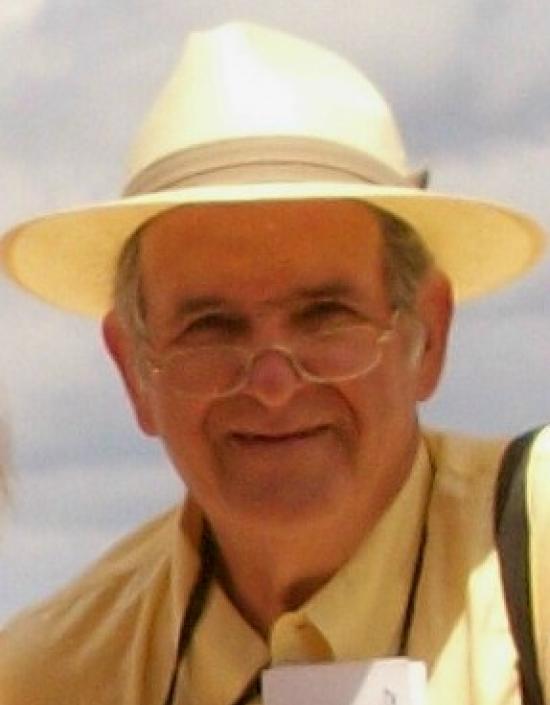

Jack Schmidt
Earliest memory of the Institute –
signing up for a student membership as an undergrad at Colorado State College (Now the University of Northern Colorado), encouraged by Dr. Welby Wolfe, chairman of the Theatre Department.
After graduation, lost track of the Institute until I joined Strong International (now Strong Entertainment Lighting) as spotlight sales manager, and went to the Oakland Conference in 1986. I began to be really involved at and after the 1989 Calgary conference.
Favorite memories:
Visiting Fallingwater with Rick Stephens, Joe Aldridge, hosted by David Will after the Pittsburgh conference, the board meeting in Nashville in '93, I think, and an informal bull session in Wichita that should have been taped for the gender issues forum.
Career Highlights:
MA, University of Northern Colorado, 1970.
Technical Director, Omaha Playhouse, 1970-73.
Designer/Production Manager, Omaha Ballet 1974-84.
Product Sales Manager, Spotlight Division, Strong International, 1985-2005
Member IATSE Local 42, Omaha - Fremont - Council Bluffs - Sioux City 1979-present. Current 1st Vice President.
Involvement:
Appointed to the USITT Board by Sarah Nash Gates to represent exhibitors, Member of the board 1992-94, concurrently a board member of TDA/ESTA, served as a liaison between the two organizations. Served on various committees including conference site selection.
Memorable Characters:
Wil Bellman, Van Phillips, Dr. Doom, Gino Montgomery, Sarah Nash Gates, Rick Stephens, Joy Emery, Dave Will, Carolyn Satter - the list is endless
About being a Fellow:
A humbling honor, which I'm still trying to live up to.
What USITT means to me
I don't know where to start. A forum for meeting the most fascinating, involved and involving, passionate people I can imagine. A place to make the best friends a person could possibly have.


Samuel H Scripps
(1927-2007)
Read a Memorial of Samuel H. Scripps
Employment history:
- Assistant Technical Director, old Globe Theatre, San Diego and the Berkeley Shakespeare Festival (later became California Shakespeare Festival) (1950s)
- Photographer and filmmaker, San Diego Zoo and Scripps Institute of Oceanography, including a four-month expedition to the Fiji Islands and Tahiti
- Lighting Designer, Riverside Shakespeare Festival, New York (1980s)
- Part Owner and Director, AVAB America, Inc (a lighting company and USITT Sustaining Member)
- Co-founder, with his wife Luise Scripps, American Society for Eastern Arts, a non-profit organization that brought classical performing artists from Asia to America for performances and workshops
- Board Member for various arts organizations including: Paul Taylor Dance Company; American Dance Festival in Durham, NC; Brooklyn Academy of Music; Theater for a New Audience; Rhinebeck Performing Arts Center
- Major Contributor to the Globe Theatre project in London
- Namesake of Samuel H Scripps American Dance Festival Award for Lifetime Achievement in Choreography. Editor’s note: This award, established in 1981, is given annually and administered by the Association for the American Dance Festival.
- World-renowned Philanthropist to the Performing Arts. Editor’s note: Mr. Scripps was a descendent of the Scripps newspaper family. His grandfather, Edward W Scripps, founded United Press International (UPI) and the Scripps-Howard newspaper chain, which at one time was the nation’s largest. His father, Robert P Scripps was a reporter and correspondent, as well as editorial director of various Scripps-Howard and Scripps-McRae newspapers,
USITT Involvement and Offices Held:
- Mr. Scripps Company, AVAB American, became the First Contributing Member when the category was established in 1982
- Member, Steering Committee of prize-winning 1987 PQ Exhibit
- Member, Steering Committee of the International Liaison Committee (the U.S. Center of OISTAT)
- Board of Directors
- Mr. Scripps’ first Philanthropic donation toward USITT activities was a sizeable grant to the Institute’s Third Scenographic Exposition, an annual, national design exhibit. (1984)
Awards and Honors:
- Editor’s note: Mr. Scripps received far too many honors and accolades for his philanthropic activities to list here. What is included below are the honors bestowed upon Mr. Scripps for his USITT activities.
- Elected USITT Fellow (1991)
- USITT Award (as member of ’87 PQ Steering Committee) (1990)
- Namesake of USITT Samuel H Scripps International Fund. Editor’s note: This fund was named in Mr. Scripps’ honor in recognition of his initial donation to support 1987 Prague Quadrennial exhibit and annual donations thereafter which supporting PQ, international OISTAT meetings, and student travel abroad.
Special resolutions and commendations by the USITT Board of Directors
- April 1984 resolution expressed the Board’s gratitude and appreciation to Scripps as a benefactor to the Scenographic Exposition
- April 1989 resolution acknowledged the continued support of Scripps through his participation on the PQ 87 committee, his hosting a reception for Swedish OISTAT quests and his major contributions for the support of international projects
- The first Honorary Lifetime Membership was awarded in 1992 to Samuel H Scripps and in 1996 the Institute began using Honorary Lifetime Memberships as a way to recognize “a lifetime of continuous service to the Institute”

Donald C. Shulman
(1949-2003)
Education/Training:
- New York University (1967-1968)
- Emerson College, Boston, Massachusetts, BA in Tech and Lighting (1970)
- Goodman School of the Arts, Art Institute of Chicago, MFA in Management (1973)
- Internship, Milwaukee Repertory Theatre (1973)
Employment history:
- Freelance Lighting Designer, Miss America Pageant (1970-1971)
- Lighting Designer, Colorado Shakespeare Festival (1972)
- Assistant Director, Arts Council of Tampa, FL (1973-1978)
- Director, State Arts Council of Delaware, (1978-1980)
- Director, Greater Kansas City Arts Council, (1980-1984)
- President, Arts Communication, Inc. and President, Shulman Consulting, Inc (1984-2002): Editor’s note: These companies specialized in facilities design, fund-raising, and management for more than 50 arts and not-for-profit projects; facilities consultant on numerous projects including the $6 million Ocala Civic Theater.
- Adjunct Faculty (Arts Management), University of South Florida
- Adjunct Faculty (Arts Management), University of Tampa
- Editor’s note: Mr. Shulman was also very well known for his volunteer activities, most notably for the Florida Holocaust Museum.
USITT involvement and offices held:
- Student member
- Board of Directors
- Commissioner, Arts Administrative Commission (1976-1978)
- Treasurer (1978-1984)
- Vice-President for Development: worked to establish an Institute development program; introduced concept of Advisory Board members to broaden the management approach and augment the diversity and expertise on the Board of Directors
- Chair, Finance Committee
- Chair, Edward F Kook Endowment Fund
- Member, Conference Policy Committee, Nominations Committee, Planning and Priorities Committee, Membership Committee, Awards and Resolutions Committee and several special task forces
- President (1990)
Awards and Honors:
- Elected USITT Fellow (1996)

C. Ray Smith
(1929-1988)
Education/Training:
- The Choate School
- Kenyon College, Gambier, Ohio, BA in English (1951)
- Royal Academy of Dramatic Art, London, (1956-1957)
- Yale University, MA in English (1958)
Employment history:
- U.S. Army, served in Europe (1952-1954)
- Assistant Editor, Interior Design magazine (1959-1960)
- Associate Editor to Senior and Features Editor, Progressive Architecture magazine (1961-1970)
- Guest Lecturer: The American Institute of Interior Designers, the American Studies Institute at Lincoln University, The Architectural League of New York, Art Institute of Chicago, Cornell University, The Fashion Group, Institute for Architecture and Urban Studies, the New York School of Interior Design, Parsons Schools of Design, Pratt Institute, Tulane University, University of Houston, Henry Francis DuPont Winterthur Museum and Yale University (1971-1976)
- Account Executive (part time), David S Wachsman Associates, public relations (1972-1974)
- Executive Director (volunteer), Aston Magna Foundation for Music (1972-1975)
- Editor, Theatre Crafts Magazine (1969-1974)
- Editor-in-Chief, Interiors and Residential Interiors magazines (1974-1977)
- Instructor, New Jersey School of Architecture (1976)
- Instructor, Parsons School of Design, New York City (1978 – 1986)
- Instructor, Fashion Institute of Technology, New York City(1985 - 1986)
Publications:
- Freelance Author: numerous articles published in A+U (Japan), Architectural Record, Arts in America, Domus, Industrial Design, Interior Design, Interiors, New Standard Encyclopedia, The New York Times, New York Magazine, Progressive Architecture, Residential Interiors, Theatre Design and Technology, & The Village Voice (1961-1976)
- Editor, The Shapes of Our Theatre, by Jo Mielziner (1970)
- Author, The American Endless Weekend (1972)
- Author, 25 entries on architecture and architects from 1960 to 1970 for The Britannica Encyclopedia of American Art (1973)
- Editor, The Theatre Crafts Book of Costume (1973)
- Editor, The Theatre Crafts Book of Makeup, Masks, and Wigs (1974)
- Author, Supermanerism: New Attitudes in Post-Modern Architecture (1977)
- Author, AIGA Graphic Design USA: I (1980)
- Co-author (w/ Allen Cares), Interior Design in the 20th Century (1986)
- Author, Interior Design in 20th Century America: A History, 1987
USITT Involvement and Offices Held:
- Member and Chair, Architecture Committee
- Chair, Advisory Committee for the revisions of NYC building codes: Editor’s note: Mr. Smith first came to the Institute through work on its Architecture Committee with Ben Schlanger. Both were deeply involved in gathering material for the revision of the NYC Building Code then in progress. Both Schlanger and Smith, in an attempt to broaden the resources of the committee, recruited important practitioners from the Institute’s membership to participate in this important work, thus raising the profile of the Institute within the theatrical community.
- Vice President (1966-1967)
- President (1968): Editor’s note: Mr. Smith greatly broadened USITT’s influence by involving previously uncommitted members from architecture and arts communities in Institute activities.
Awards and Honors:
- Elected USITT Fellow, (1977)
- Fellow, American Institute of Architects
- Special Citation from USITT Board of Directors: To C. Ray Smith for his contributions to the advancement of USITT and to American Theatre Architecture through Institute leadership and ongoing editorial leadership in a series of distinguished publications directed to the unique requirements of a distinctive developing American theatre architecture (1988)
- National Endowment for the Arts grants (1972 & 1977)
- Graham Foundation grants (1971 & 1985)
- Facilities Lab grant (1980)

Hans Sondheimer
(1901-1984)
Education/Training:
- Institute of Technology, Munich, Germany; Diploma Ingenieur in Mechanical and Electrical Engineering (1925)
- Assistant to Professor Adolf Linnebach, Bavarian State Theatre, Munich, Germany, (1924-1926)
Employment history:
- Technical Assistant, Die Konigs Kinder, State Theatre, Munich, Germany (1925)
- Construction Supervisor, Hamburg Opera House, Germany (1925-1927)
- Technical Director, State Theatre Darmstadt, Germany (1927-1929)
- Technical Director; Berliner, German Art Renaissance, Lessing and Schiller Theatres, (1929-1933)
- Technical Director, Berliner Theatre in Kommandantern St, Berlin (1933-1939)
- Editor’s note: Mr. Sondheimer emigrated to USA in 1939 and became a naturalized citizen in 1944.
- Instructor and Technical Director, Erwin Piscator’s Dramatic Workshop of the New School, NYC (1939-1957) Editor’s note: Mr. Sondheimer also taught classes in stagecraft, design and production.
- Technical Director, St Joan, Civic Theatre, Washington DC (1940)
- Technical Director, North Shore Playhouse, Marblehead, Mass (Summer 1940)
- Projection Consultant, Second Sound Show at Stevens Institute, Hoboken, NJ (1941)
- Technical Director, Children’s Christmas Story, New York City Center (1943)
- Technical Director, St Matthew Passion, Metropolitan Opera, NYC (1943)
- Lighting Director, Innocent Voyage, Theatre Guild, Belasco Theatre, NYC (1943)
- Lighting Consultant, South Pacific, Cort Theatre, NYC (1943)
- Lighting Director, Jacobowsky and the Colonel, Martin Beck Theatre, NYC (1944)
- Technical Advisor, Lighting Designer, Stage Manager Technical Director, and Production Coordinator: New York City Opera Company (1944-1980)
- Technical Director, American Opera Company, Academy of Music, Philadelphia, PA, (1945-1951)
- Designer, Construction Supervisor, and Technical Director, Lennox Theatre, Mass (Summer 1946)
- Theatrical Consultant, White Barn Theatre, Westport, Connecticut (1949)
- Production Stage Manager, Peer Gynt, ANTA, New York City (1951)
- Production Manager, Die Fledermaus tour, New York City Opera (1951)
- Technical Director, La Boheme and The Marriage of Figaro, Central City Opera Company, Colorado (Summer 1951)
- Technical Director and Production Manager, Industrial shows, Music Corporation of America, New York City (1952-1966)
- Production Designer and Lighting Director, The Abduction of Seraglio, Katonah, New York (1953)
- Consultant, New York City Opera Company, 1980 – 1984
- Theatre Consultant on new performing spaces in the U.S. Projects of interest include: John F Kennedy Center for Performing Arts, Washington DC; Music Hall, Cincinnati; New York State Theatre at Lincoln Center; Opera House, Sydney, Australia; Wolf Trap Farm Park, Vienna, Virginia
- Technical Advisor to European companies touring in the U.S. Companies include: Hamburg Schauspielhaus; Hamburg State Opera; Munich Residenz Theater; Stuttgart Ballet; Vienna Burgtheater
- Lecturer on theatrical technique at City College of New York, the New York Public Library, and Cooper Union in New York City.
USITT Involvement and Offices Held:
- Founding member and signer of Certificate of Incorporation, 1960
- Board of Directors
- First Chairman, Engineering Committee (1960-1964)
- Founding member, U.S. Center of the International Organization of Scenographers and Theatre Technicians (1967)
- Frequent U.S. delegate to international meetings of the OISTAT
Awards and Honors:
- Elected USITT Fellow (1977)
- Joel E. Rubin Founders Award (1978)
- Gold and Honorary Pin of the German Organization of Technical Directors (Deutsche Technische Gesselshaft) (1979)
- Decorated Officers Cross, Order of Merit, Federal Republic of Germany, 1967

Donald Stowell
(1940-1995)
Education/Training:
- Davidson College, Davidson NC, BA in Speech/Drama (1961)
- University of Miami, FL, MA in Costume Design (1965)
- University of Texas, PhD in Theatre, History and Criticism (1970)
- Member, United Scenic Artists, Local 350
Employment history:
- Faculty, Southwest Missouri State University, Springfield, MO (1965-1967)
- Costume Designer, Professor, and Associate Dean for Instruction, Florida State University, School of Theatre (1970-1983)
- Principal, Don Stowell and Associates, freelance designer (1983-1990)
- Director of the Division of Fine Arts, North Dakota State University, Fargo (1990-1994) Editor’s note: Dr. Stowell was named Professor Emeritus upon his retirement (1994)
Publications:
- Author, The New Costuming in America: The Ideas and Practices of Robert Edmond Jones, Norman Bel Geddes, Lee Simonson and Aline Bernstein, 1915-1935; PhD diss., University of Texas at Austin (1972)
- Numerous articles for Theatre Design and Technology
USITT Involvement and Offices Held:
- First Commissioner, Costume Design and Technology Commission (1975)
- Commissioner, Scenography (1977-1978)
- Initiated the Scenographic Heritage section of Design Expo and served as the coordinator for several exhibits
- Board of Directors
- Arranged and coordinated joint meetings with Costume Society of America as post-conference events
- Inaugurated and coordinated numerous pre and post-conference events
- Created the summer USITT Costume Symposia and coordinated several such events
- Coordinated “The Art of Stage Costuming” for Orlando Conference
- Namesake of the Costume Commission Donny Award and was the first recipient for his contributions to Costume Design and Technology
Awards and Honors:
- Elected USITT Fellow (1985)
- Fulbright Scholar to pursue research in Brazil, 1993
- Board of Directors, Costume Society of America
- North Dakota Council on the Arts (by gubernatorial appointment)

John C Suesse
(1943-2007)
Education/Training:
- Carnegie Institute of Technology (1961-62)
- Syracuse University (1963-1964)
- Carnegie Institute of Technology, BA in Technical Theatre, (1964-1967)
Employment history:
- Assistant Technical Director, Guthrie Theatre, Minneapolis, MN (1965-1966)
- Faculty, Onondaga Community College, Syracuse, NY (1967-1968) Editor’s note: This position also included the job of Staff Supervisor of WCNY Television’s production department.
- Owner and President, Syracuse Scenery & Stage Lighting (1968-1970)
- Project Manager, J. R. Clancy, Inc. (1970-1980)
- Owner and Principal Consultant, Scenassure Theatrical Systems (1980-1986) Editor’s note: This firm offered independent coordination for construction projects around the world.
- General Manager, Partner and President, J.R. Clancy, Inc. (1986 – 2005) Editor’s note: During Mr. Suesse’s tenure with Clancy he consulted and oversaw over 100 projects. Some of the most interesting and complicated include:
- Avery Fisher Hall at Lincoln Center in New York City; The Peace Center in Greenville, SC; the Chicago Opera House; the United State Naval Academy at Annapolis (This last project was especially noteworthy, as it was built on a very small footprint of land. The existing facility had no space to the side of the arena, so J.R. Clancy, Inc. raised — via a fail-safe design — the stage, many of the seats, the orchestra shell, all the lighting, all the stage draperies (over 150,000 pounds of equipment) up into the truss ceiling space over the arena, allowing the space to convert from basketball court to concert hall or theatre).
- Owner and Principal Consultant, J Suesse & Associates, South Carolina (2005-2007)
USITT Involvement and Offices Held:
- Contributing/Sustaining Commercial Member since 1970
- Commercial exhibitor since 1975
- Co-presenter (along with Jay Glerum) of the program session “Rigging 101” (1984). Editor’s note: This is generally considered the beginning of the educational training and codification of standards in and for the overhead rigging profession in the U.S.. In the years since, Mr. Suesse and J. R. Clancy. Inc., spearheaded the creation of standards, destruction testing certification of components, and have ultimately led to the establishment of the ETCP certification in rigging programs. Whether it was through donations of financial support to translate foreign language documents, serving as a workshop presenter, or in his contributions as an ESTA subject matter expert for the ETCP program, Mr. Suesse’s contributions helped change the industry.
- Panelist at the popular annual “Stump the Rigger” conference sessions
Awards and Honors:
- Elected USITT Fellow (1993)
- Member ESTA, served as Entertainment Technician Certification Program (ETCP) subject matter expert
- Life-long Member, International Alliance of Theatrical Stage Employees (IATSE), Local 9
- Volunteer and honoree, Habitat for Humanity
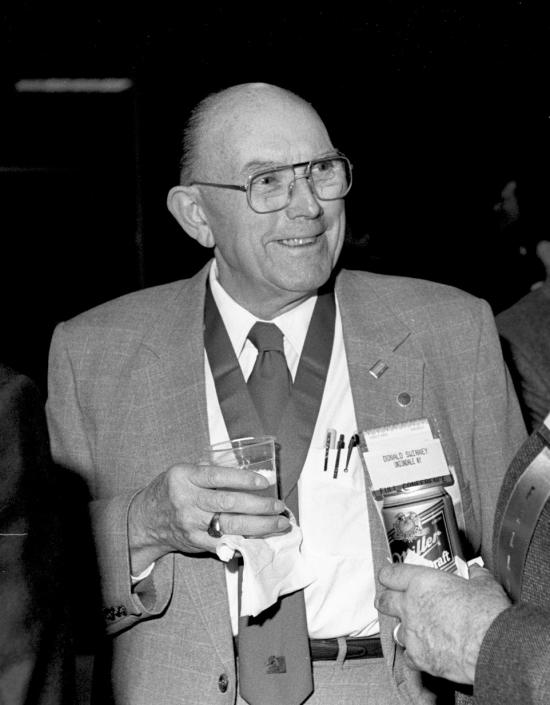

Donald H. Swinney
(1919-1994)
Education/Training:
- University of Idaho, BA (1939)
- University of Idaho. MA (1940)
- University of Indiana, PhD (1948)
Employment history:
- Designer, Tent Players, Moscow, Idaho (summers)
- U.S. Army Medical Corps (WWII)
- Designer and Technical Director, Indianapolis Civic Theatre (1947)
- Designer and Technical Director, Indiana University Opera Department (1948)
- Professor, Designer, and Technical Director, University of Denver (1948-1950)
- Professor, Designer, Technical Director, and Department Chair, Hofstra University, Hempstead, New York, 1950 – 1991. Editor’s note: During his tenure at Hofstra, Dr. Swinney designed and equipped a new theatre, the John Cranford Adams Playhouse and later became its Director. This theatre became rather famous as a “beta test site” for, among other things, the installation of the first of George C Izenour’s synchronous winch systems as well as the first generation of Century Lighting’s SCR dimmers.
- Worked with John Cranford Adams on his portable, but otherwise authentic, Shakespearean platform stage
- Designer, Technical Director, Stage Manager, and General Production Manager, Caramoor Festival of Music and Art, Katonah, New York (34 summers) — often working in association with Maestro Julius Rudel
- Theatre Consultant numerous theatre projects around the world including the John F Kennedy Theatre in the East-West Center at the University of Hawaii and national theatres in Nicaragua and Guatemala.
- Special Advisor and Consultant, Jean Rosenthal and Associates
Publications:
- Managing Editor, Theatre Design and Technology
- All printed material of the Institute, except for the Journal, produced at Hofstra under Swinney’s supervision, 1968-1977)
- Business Manager, Educational Theatre Journal
USITT Involvement and Offices Held:
- Founding member
- Founding Member, Engineering & Architecture Commissions Editor’s note: Dr. Swinney proposed working commissions be charged with originating and completing specific research tasks so the Institute would become a collaborate, high-level theatre information base of working professionals. To that end Dr. Swinney was the author of the first USITT research paper, “The exploration of the potential and application of point winches to stage rigging technology”
- Chair of the Finance, Nominating, Awards, & Policy committees
- Board of Directors (first elected at 3rd conference)
- Worked as part of a group of early conference planners and organizers for all of the early NY conferences in the 1960s
- Technical Secretary (1964-1965)
- Third President, 1965 – 1968
- Member, President’s Council and/or President’s Task Force. Editor’s note: This was a group of all of the former Presidents of the Institute that acted as an advisory board for the current Presidents
- Director, Domestic Liaison activities
- Board Member, New York Section
Awards and Honors:
- Elected USITT Fellow (originating class 1977)
- USITT Special Citation, 1968
- USITT Joel E. Rubin Founders Award (1977)
- Founding Member, President, and Member of Accreditation Panel, National Association of Schools of Theatre (NAST) (1976-1981)
- Board of Directors, ATA
- Idaho Centennial Homecoming Award (given by Governor Cecil Andrus) for “impressive record of achievement in the fields of theatre design, directing, and theatre administration,” (1989)
- Hofstra University Distinguished Service Medal (1990)
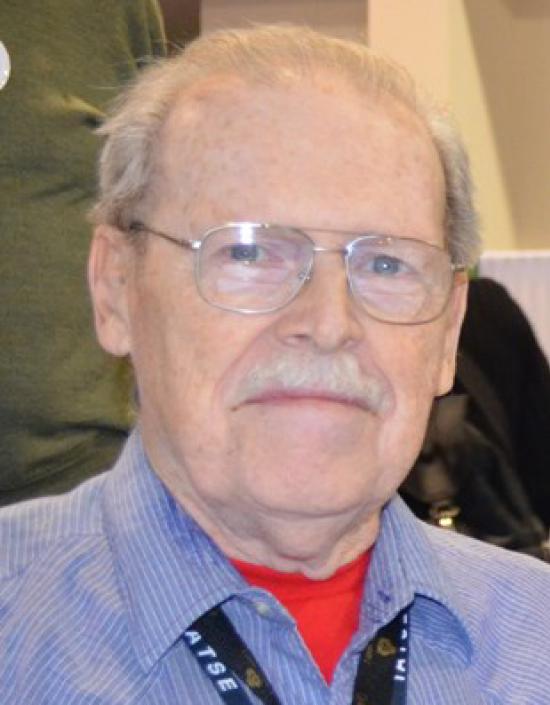

Henry E. Tharp
(1932-2021)
Your earliest memories of the Institute?
Touring the (then) new opera house at Indiana University during the 1965 Conference in Bloomington, Indiana (the first one held outside NYC) and being particularly impressed with the elevator(s) all the way to the grid.
Favorite USITT memory?
A great sound and light show at the Goodman Theatre during the 1968 Conference in Chicago
My first visit ever to San Francisco for the 1972 Conference at the Mark Hopkins Hotel (ruining all other cities for me ever since).
Career highlights:
- 1950-1952 & 1956-1958 Earned BA & BS in Ed in Speech and Theatre at Emporia (KS) State
- 1952-1956 Service in USAF (Korean Veteran)
- 1958-1959 Earned MA in Theatre at University of Illinois with Graduate Assistantship teaching Public Speaking and as a scene shop assistant
- 1959-1960 Assistant Technical Director (under Don Swinney, TD) At Hofstra College, Hempstead, NY
- 1960-1962 & 1964-1966 Instructor, University of Louisville, and Designer / TD, Belknap Theatre
- 1962-1964 Doctoral studies at University of Illinois with Graduate Assistantship as the Assistant Costumer for the University Theatre
- 1966-1974 Designer / TD for Louisville Children’s Theatre
- 1974-1977 Assistant Professor University of Missouri, and Designer / TD. University Theatre
- 1977-1997 Director (supervisor) of Performance Services University Theatres, University of Missouri
- 1997 Retired
Short list of your involvement in the Institute:
- 1965 - Joined and have been a member continuously ever since
- 1977 - Helped form HOA regional section and elected its first (Charter) President
- 1980 - Chaired USITT National conference in Kansas City
- 1981 - Elected to USITT Board of Directors
- 1982 - Elected Secretary of USITT
- 1985 - appointed Vice President for Conferences of USITT
- 1986 - Elected Vice President for Conferences
- 1993 - Chaired USITT National conference in Wichita
If you were to make a short list of the memorable USITT characters that have made a difference to you, who would they be?
Herb Greggs, the one-man national office, who was of great help putting together the 1980 Conference. Ron Olson, President during one of my terms as Secretary, who referred to me as the Secretary General.
Anything you want to say about being a Fellow?
Being elected a Fellow was probably the greatest surprise and honor I have received in my life. Being associated with the Fellows has been and continues to be a source of great satisfaction and pride.
Past or Present Memberships:
- NCP
- SSA
- AETA
- ATHE
- Mensa
- IATSE
Memorable to others as:
The person with the USITT vanity license plates -- for more than three decades.

Richard D. Thompson
(1933-2007)
Education/Training:
- University of Texas at Austin, BFA in Technical Production (1955)
- Yale University School of Drama, MFA in Technical Production and Lighting (1961)
Employment history:
- IATSE Stagehand, local 205, Austin, TX.
- U.S. Army, NIKE missile program specializing in fire suppression systems (1956-1958) Editor’s note: This experience was to prove extremely valuable and eventually changed the course of Mr. Thompson’s career. The NIKE missile program used a number of fire suppression systems including a “deluge curtain” of water that could instantly protect crewmen if a fire broke out while working on the missiles. Following his discharge from the army Mr. Thompson attended the Yale School of Drama. While there he wrote a paper for legendary technical director Ed Cole describing the concept and suggesting it as an alternative to the traditional asbestos fire curtain that was required by code. Following Mr. Thompson’s graduation, USITT Vice President and Architect Ben Schlanger was asked to chair the panel examining “places of assembly” for a rewrite of the NYC building codes. Mr. Cole remembered Mr. Thompson’s paper and suggested that he be included on the panel. The resulting work of the committee, based on Mr. Thompson’s theories, changed the code and allowed theatre productions in New York City to “burst through the proscenium and come forward into the audience chamber,” forever changing the face of the New York Theatre.
- Stagehand, at various theatres in the New Haven area during grad school (1959-1961)
- Sales Engineer, Ward Leonard Electric Company, NYC (1961-1965)
- Manager, Theatre and Television Lighting Division, Lighting and Electronics, Yonkers, NY (1965-1967)
- Director, Theatre and Television Studio Facilities Planning, Imero Fiorentino Associates, Inc., New York, NY (1968-1972)
- Senior Consultant, George Thomas Howard & Associates, Hollywood, California (1972)
- Owner and Principal Consultant, Richard Thomas and Assoc., Los Angeles, CA (1972-2007) Editors note: Over the years Mr. Thompson not only worked on numerous performance facility projects throughout the country, but early in his consulting career he developed an association with Milton Forman, then the doyen of motion picture studio design. This relationship introduced Mr. Thompson into the middle of Hollywood studio practice and opened a new field in which to practice his skills.
Publications:
- Author, “Preliminary Architectural Study of a Music Theatre Project for the Connecticut Performing Arts Foundation, Inc.” Master’s Thesis, Yale School of Drama (1961)
- Author, “A Proposed System for Fire Protection of the Proscenium Arch in the Flexible Theatre” Journal of the American Institute of Architecture (1961)
- Author, “Guides to Stage Lighting Control Systems for High Schools, Colleges and Television Studios” Journal of the Illuminating Engineering Society, New York, NY (1966)
- Author, “Lighting Control Systems for Television” Broadcast Journal, Los Angeles, CA (1970)
- Author, “Market Analysis in the Performing Arts: You Have to Know the Territory” Theatre Crafts, New York, NY (1970)
- Author, “Architectural and Space Allocations for Management and Industrial Television Studios” Journal of the Society of Motion Picture and Television Engineers, New York, NY (1971)
- Associate Editor, “Recent Developments” feature, Theatre Design and Technology, (1972-1973)
USITT Involvement and Offices Held:
- Engineering Commission
- Chair, Membership Committee (1962-1963 Editor’s note: Mr. Thompson’s position with Ward Leonard involved considerable travel, and he took to carrying a stack of USITT membership brochures and signed up new members at every opportunity. His efforts drew immediate attention, and he was soon approached by then president Tom DeGaetani. Dick’s efforts had single-handedly almost doubled the Institute’s membership; would he consider becoming the membership chair? As chair, Dick set up a file card system, which continued to be used until the records were transferred to computers in the 1980s.
- Secretary-Treasurer (1963-1964 & 1966-1968)
- Technical Secretary (1965)
- Conference Chair, New York City (1964) Editor’s note: This conference coincided with the opening of the 1964-1965 New York World’s Fair, The conference included a pre-conference tour beginning at 7:00 a.m. at Radio City Music Hall, then to the World’s Fair Grounds to for a 9:00 a.m. test ride of the Bell Telephone exhibit (designed by Jo Mielziner, managed by David Mintz, who was at that time Jo’s assistant), to the GE Pavilion (Olaf Sööt was the engineer), to the IBM exhibit, breaking for lunch in Greenwich Village; regrouping after lunch at the ANTA Washington Square Theatre; and ending at the New York State Theatre. It was also the genesis of commercial exhibits that would later grow into Stage Expo.
- Board of Directors
- Anaheim Conference Exhibits Chair (1975) Editor’s note: This was the first full blown Stage Expo and generated largest conference profit to date ($10,000+).
- NEC Standards Committee, USITT representative for 30+ years
Awards and Honors:
- Elected USITT Fellow (1978)
- USITT International Health and Safety Award (1988)
- Sustaining Member, American Theatre Association (ATA)
- Member, Illuminating Engineering Society (IES); Theatre, Television and Film Lighting Committee; Industrial Television Association (ITVA); Society of Motion Picture and Television Engineers (SMPTE)
- Panelist, National Fire Protection Association’s National Electric Code Panel 70
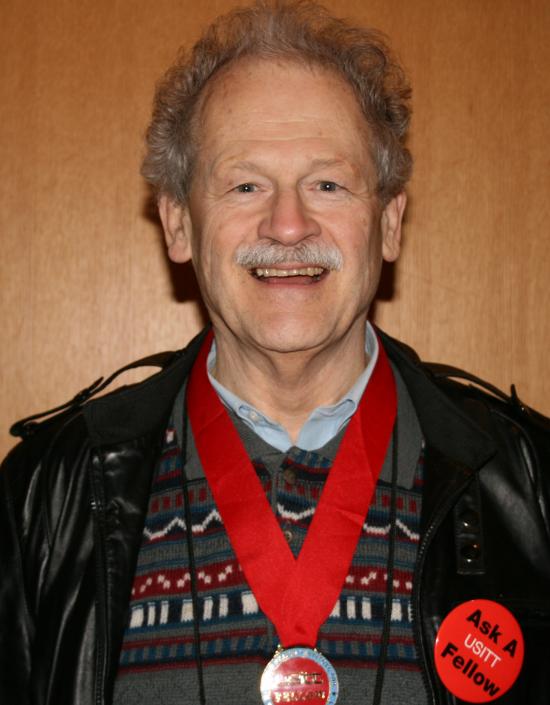

Kenneth Vannice
(1944-2018)
Read a remembrance of Kenneth Vannice
Your earliest memories of the institute?
As a new student member I received a copy of the first TD&T,
May 1965. My first conference was at the Barbizon Plaza Hotel, probably 1967. Worked on first West Coast conference with George Howard, Will Bellman, Will Crocken, Mert Cramer and Tom Lehman, L. A. 1969
Favorite USITT memory?
Leading the charge to revise the NEC including adding the requirements for single-conductor feeder systems
Short list of your career highlights:
- Technical Director for MSU Student Union Theatre and The Loft Theatre (summer stock)
- Degrees in Electrical Engineering and Theatre Arts from Montana State University
- Engineer/Manager for Kliegl Bros. Western Corp., Colortran Inc. (with and without prefixes), NSI Corp. and Leviton Manufacturing Co. Inc.
- Stage lighting system and equipment designer
- Registered Professional Engineer, Electrical
- Member of several codes and standards bodies
- ETCP Certified Entertainment Electrician and Recognized Electrical Trainer
Short list of your involvements in the Institute:
- Officer, Southern California Section (CATT Inc.)
- Conference Committee member, 1969, 1975 and 1988 (when local sections produced the conference)(facilitated first AIDS awareness exhibit)
- Principal Member, NEC CMP 15; Engineering Commission Vice-commissioner for NEC Aairs;
- Chair, Engineering Commission NEC Committee
- Member, Standards Committee
- Co-chair, Engineering Commission Electrical Safety Workshop
- Member, Board of Directors
- Fellow
Short list of the memorable USITT characters that have made a difference to you?
- Past – Joel Rubin, Bob Benson, Ed Peterson,
- Present – Mitch Hefter, Jerry Gorrell, Louis Bradfield, Steve Terry
- Most Significant – George Howard (I owe most of my practical knowledge of the theatre and engineering to George.)
Being a Fellow means:
I consider it a great honor to be included in such an august group.
What does USITT means to you?
USITT has always been a place for me to shared ideas and hone skills. Furthermore, many of my extended family members are Institute members.
Publications:
- Monthly column Code Corner in Sightlines
- Articles in TD&T
- Articles in Protocol
- Articles in IAEI
List of books that you recommend:
- National Electrical Code Handbook

Walter H. Walters
(1917-1982)
Education/Training:
- Troy State University, Troy AL, BS in Education (1939)
- University of Wisconsin – Madison, PhM in English Literature (1947)
- Western Reserve University, Cleveland, Ohio, MFA in Drama (1949)
- Western Reserve University, Cleveland, Ohio, PhD in Literature and Drama (1950)
Employment history:
- Teacher, Alabama Public School System (1939-1942)
- Lieutenant, U.S. Naval Reserve on the staff of Fleet Admiral Chester W Nimitz (1942-1946); received Citation for Meritorious Service from the Chief of Naval Operations
- Faculty, University of Wisconsin (1946-1948)
- Faculty, Pennsylvania State University, 1950-1982)
- Chairman, Department of Theatre Arts and Film, Pennsylvania State University (1954-1966) Editor’s note: During his tenure, the Playhouse and Pavilion theatres were designed and opened, and a master of fine arts degree was added.
- Associate Dean, College of Arts and Architecture, Pennsylvania State University (1966-1968)
- Acting Dean, College of Arts and Architecture, Pennsylvania State University (1968-1969)
- Dean, College of Arts and Architecture, Pennsylvania State University (1969-1982) Editor’s note: Under Dr. Walter’s leadership the Museum of Art opened, the University Resident, Pennsylvania State Festival Theatre, and the Nitanny Mountain Summer Theatre companies established, and the Angels Program launched.
- Director, University Arts Services, 1973 - 1982
Publications:
- Editor, Books in Review
- Editor, AETA Journal
- Editor, USITT newsletter, 1966 - 1968
USITT Involvement and Offices Held:
- Board of Directors (1966-1970 & 1976-1978)
- First Vice President (1970-1971)
- President (1971-1972)
- Chairman, Executive Council
Awards and Honors:
- Elected USITT Fellow (1977)
- Chairman, Theatre Management and Administration Project, American Theatre Association (1965-1967)
- Advisory Council, American Academy, Rome (1968-1982)
- Chairman, Founding Committee & first President, University and College Theatre Association (a division of ATA, 1970-1971)
- Citation in recognition of distinguished contributions to the advancement of education, presented by the Secretary of Education, Commonwealth of Pennsylvania on behalf of the Governor (1972)
- Chairman, Theatre Advisory Panel; responsible for the development and advancement of theatre in the Commonwealth (1972-1973)
- Vice Chairman & Chairman, International Council of Fine Arts Deans (1973-1974)
- Discussion leader, international conference in Florence on professional education and career entry of artists (1984)
- Chairman, Fine Arts Commission, National Association of State University and Land Grant Colleges (NASULGC) (1975-1981); Led steering committee that produced report on “The State of the Arts at State Universities and Land-Grant Colleges”- the first and only such assessment
- Steering Committee, Board of Directors & Secretary/Treasurer, American Research Institute for the Arts (1975-1982)
- Chairman, Caucus on the Arts in Higher Education (1978)
- Fellow, American Theater Association

Leland H. Watson
(1926-1989)
Education/Training:
- State University of Iowa, B.A., Phi Beta Kappa (1948)
- Yale University School of Drama, Master of Fine Arts (1951)
Employment history:
- Technical Director, Eastern Illinois State Teachers College (1940) Editor’s note: Age 14 while still in high school
- U.S. Army Infantry (1944-1946) — Wounded in the Battle of the Bulge
- Lighting Designer, Earth Spirit, Provincetown Playhouse, NYC (1950) — professional debut
- Editor’s Note: Mr. Watson’s professional credits for the legitimate theatre numbered more than 400 productions, mostly in Lighting Design, but he also sometimes designed Scenery and occasionally Costumes. Although obviously too numerous to list, some of the highlights of his career are listed below:
- Lighting Director-Television:
Numerous programs, CBS Television (1951-1955)
(And Scenic Designer), Get Set, Go, U.S. Army Signal Corps (1956-1957)
Numerous programs, MGM Telestudios (1959-1963)
Commercials, Videotape Productions, 1960 - 1963
- Lighting Designer for more than 40 Broadway Shows and more than 60 Operas. Significant productions include:
The Traveling Lady, Playhouse Theatre (1954) — Broadway Debut
Arthur Miller’s A View from the Bridge, Coronet (1955) — world premiere
The Diary of Anne Frank, Cort (1955) — world premiere
A Moon for the Misbegotten, Bijou, (1957)
The Cave Dwellers, Bijou (1957)
Lost in the Stars, New York City Opera, New York City Center (1958)
Good Soldier, New York City Opera, New York City Center (1958)
The Rape of Lucretia, New York City Opera, New York City Center (1958)
On the Town, Carnegie Hall Playhouse (1959)
Free and Easy (European production), Amsterdam, Netherlands (1959)
Maria Golovin, New York City Opera, New York City Center (1959)
The Bolshoi Ballet tour of the United States and Canada, (1959)
The Pretenders, Cherry Lane (1960)
Machinal, Gate (1960) — Note: Obie Award
The Blacks, St. Marks Playhouse (1961)
Second Hurricane (the opera), Museum of Modern Art (1961)
Turn of the Screw, New York City Opera, New York City Center (1962)
Carmen, New York City Center (1962)
- Costume, Scenic and Lighting Designer:
The Next President, Bijou, (1958)
The-A Musical Salamagundi (1958)
The Importance of Being Oscar, Lyceum (1961)
Moby Dick, Madison Avenue Playhouse (1961)
Scenery and Lighting Designer, A Lovely Night, Hudson (1960)
- Lighting Designer, Industrial Shows:
The Pontiac Industrial Show, Detroit, Michigan (1960)
Vive La Femme, Latin Quarter (Nightclub), New York City (1960)
The Chevrolet Industrial Show, Detroit, Michigan (1961)
The Coca-Cola Industrial Show, Miami, Florida (1961)
Century 21 Industrial Show, Seattle World’s Fair (1962)
Chevrolet Industrial Show, Detroit, Michigan (1962)
- Lighting Designer and Supervisor, The Father, Miss Julie, and Long Day’s Journey into Night, Swedish Royal Dramatic Theater, Seattle World’s Fair, 1962
- Interim Faculty and/or Instructor: Brooklyn College, Lester Polakov’s Studio, University of Houston, CW Post College, and Forum of Stage Design
- Associate Professor, Purdue University, 1975 – 1981
- Full Professor, Purdue University, 1981 - 1989
Publications:
- Senior Contributing Editor, Critic of Broadway Lighting Design, Lighting Dimensions, (1980-1986)
- Critic, Lighting Design + Application
- Co-Author (with Joel E. Rubin), Theatrical Lighting Practice (1955)
- Author, A Handbook of Lighting Design (1990)
- Author, numerous articles for Educational Theatre Journal, Player’s and Theatre Design and Technology
USITT Involvement and Offices Held:
- President (1980-1982)
- Chair, Awards Committee
- Chair, New York Section
- Vice President, Liaison and Relations (1978)
Awards and Honors:
- Elected USITT Fellow (1978)
- USITT Joel E. Rubin Founders Award (1983)
- Board Member and Vice President (1961-1963), United Scenic Artists, Local 829
- Obie Award for Machinal, 1960
- Board of Directors, International Association of Lighting Designers
- Purple Heart, U. S. Army Infantry (WWII)
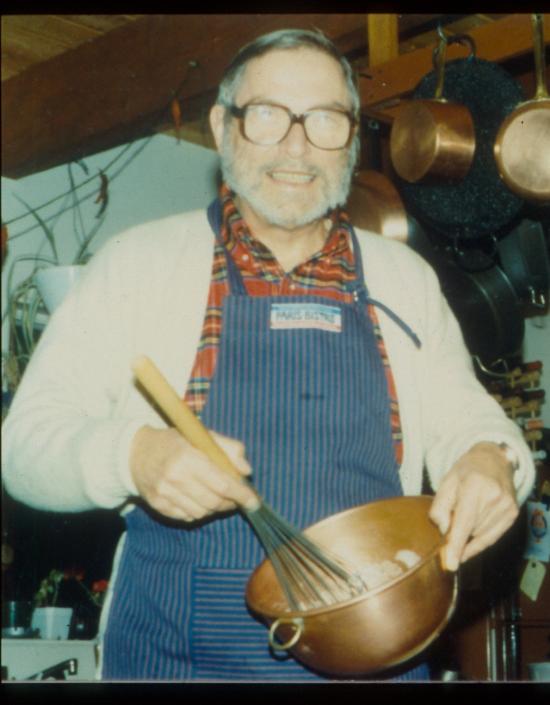

Tom Watson
(1924-2016)
Tom Watson -- inducted as a USITT Fellow in 1977, editor of TD&T from 1972 to 1977, and recipient of the USITT Honorary Lifetime Member Award -- died on May 20, 2016.
Born May 2, 1924, in Cleveland, Ohio, Thomas Stoneman Watson spent most of his childhood in the village of Aurora, OH, then finished high school in Shaker Heights, OH. On graduating high school in 1943, Tom enlisted in the U.S. Army and served in an Army Engineer pipeline company in France after the D-Day invasion.
Returning to Cleveland after the war, Tom attended Western Reserve University, earning his B.A. with a major in Theatre Arts. He returned to Western Reserve twice, first completing his M.A., and in 1963 completing his Ph.D. Although Tom tried his hand at acting and appeared on stage at various times throughout his career, his interests and skills centered on technical theatre, particularly lighting and set design. His career included summers as Technical Director/Designer for the American Dance Festival at Connecticut College, where he worked with such modern dance greats as Martha Graham, Paul Taylor, and Alvin Ailey. He taught on the faculties of Western Reserve University, SUNY at Buffalo, and the University of Delaware, where he chaired the Theatre Department for six years.
In 1950, Tom married Lois Warnshuis. They raised two daughters and enjoyed 51 years together until her death in 2001. Upon retirement, Tom and Lois moved to a house on Block Island, Rhode Island, which he had a major hand in building and renovating. He kept busy and active fishing, gardening, working in community theatre, singing with the Block Island Ecumenical Choir, and serving as an EMT. Several years after Lois's death, Tom moved to Orono, Maine where he met Frances T. Hunter who became his devoted partner and who made his last years at the Dirigo Pines Retirement Community some of the happiest of his life.

Bernard J. Weiss
(1925-2003)
Education/Training:
- Industrial Arts Education, Ohio State University
Employment history:
- Torpedo man, U.S. Navy (1943-1946)
- Crew Head, Cain Park Theatre, Cleveland Heights, Ohio, 1946 Editor’s note: Dr. Joel E. Ruben was a teenaged crew member for the Cain Park Theatre that summer. He fondly recalled Mr. Weiss in those days: “Bernie was the Crew Head for an open-air, 3, 000-seat theatre with an 80-foot –wide proscenium and a 10-week summer season of 10 shows, half of which were musicals. That was a lot of scenery to generate and paint every week, and Bernie made sure every thing was on stage for the dress rehearsal and the paint was dry by opening night. Bernie also taught us the trick of cutting quarts of ice cream in half on the band-saw for our summer mid-afternoon breaks.”
- Senior Technical Director for Broadway and television productions over a period of nearly 45 years from the 1950s to the 1990s. Editor’s note: This period is now known as “The Golden Age of Broadway.” Mr. Weiss worked with virtually every Broadway designer of the period and counted Ralph Alswang, Lemuel Ayers, Donald Oenslager, Max Gorelik, Jo Mielziner, Boris Aronson, and Oliver Smith among his favorites. His special skill was translating designer renderings (not elevations) into technical drawings for the scenic studios and supervising a production through initial put-in to make sure that everything worked and fit perfectly. He was considered by his colleagues to be one of the great Technical Directors of the professional theatre.
- Project Manager, Nolan Studios (1950s)
- Principal & Partner, Feller Studios (1960s & 1970s) supervised much of the early scenery automation and worked as principal planning consultant for backstage technologies in renovations for Broadway theatres, roadhouses, and new performing arts centers around the country and the world.
- Owner and Operator, Metro Scenic Studios (1970s & 1980s)
- House carpenter and manager of technical activities for the Shuberts
- Supervisor, Cort Theatre
- Stage consultant with Peter Feller, design and construction of theatres in Mexico City, a State Department assignment in the Soviet Union, and the backstage consultation on the Segerstrom Performing Arts Center in Costa Mesa, CA
- Design and fabrication, Olympic torch for the Winter Games in Lake Placid (1976)
USITT Involvement and Offices Held:
- Founding member (1961)
- Chair (1964-1969) & long-time member of the Engineering Commission
- Board of Directors, 1960s and 1970s
- Technical Advisor to the Chair, USITT Exhibit, Prague Quadrennial, 1987 — Gold medal winner
- Represented International Alliance of Theatrical Stage Employees (IATSE) at Stage Expo booth for over 20 years as a long-time member, first in Cleveland, then in New York
Awards and Honors:
- Elected USITT Fellow (2001)
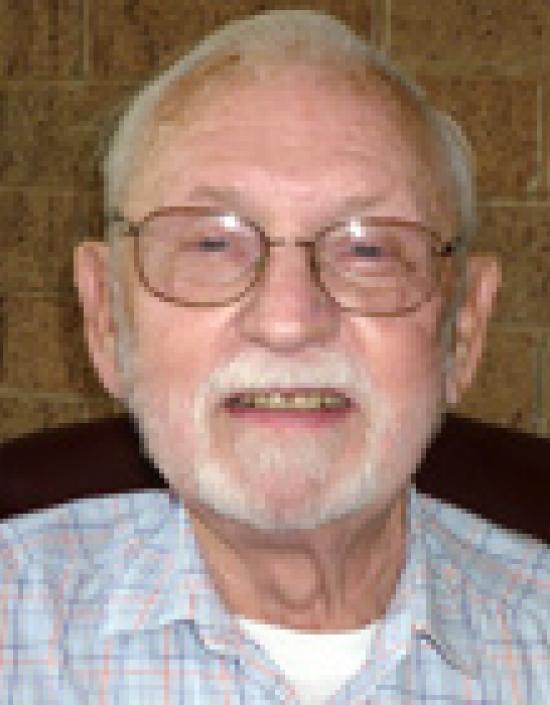

Chuck Williams
Inducted as Fellow: 1978
I first heard of USITT when a graduate student at Stanford in 1963. The TD at Stanford, Derek Hunt, described the group as “a bunch of New York theatre types that gathered in someone’s living room and gossiped.” Nonetheless, I joined the organization and promptly forgot about it. However, I took a job as TD/Lighting Designer with a Stanford classmate at the new branch campus of the University of Alberta, at Calgary, Alberta, Canada in September, 1965. I soon learned that USITT would hold a national conference in Toronto, Canada, in the spring of 1966. I determined to attend and did so, and thus began many long term friendships with many USITT members, including Don Swinney, Joel Rubin, Tom DeGaetani, Walt Walters, Lee Watson, and many, many others.
The next important event in my USITT career came in 1970 at the National Conference in New York when I was elected to the Board of Directors. By this time, I had left the now University of Calgary to become TD at San Francisco State and the then Executive Director of USITT, Tom DeGaetani, wanted to establish a USITT section in Northern California. He wanted me to be the catalyst for the new section. That happened in 1971 and the National Conference came to San Francisco in 1972. It was a big success which was important because the previous year’s conference in Dallas, Texas, had revealed that USITT was in serious financial trouble. San Francisco was a financial success, had over 300 attendees (compared to 71 in Dallas) and inaugurated the first student design show and the biggest manufacturer’s show USITT had ever had. One of the by-products of the 1972 Conference was that the By-Laws got completely re-written and the President’s term was changed from one year (repeatable) to two years (not repeatable).
In 1977, I was elected President of USITT and served until 1980. I was elected a Fellow of USITT in 1978 and awarded the Founders Award at the Calgary Conference (fittingly) in 1989.
In addition to the list of “founding fathers” of USITT mentioned above, I should note the long and enduring friendships that I developed with major USITT figures such as Dick Arnold, Randy Earle, Ed Koch, David Hand, Chris Kaiser, Will Bellman, Oren Parker, Sarah Nash Gates, and so many more that it would take the next 20 pages to list them all.
I can’t say enough good things about my experiences as a USITT member. Being recognized by my fellow USITT members when elected as a Fellow, was priceless. The plaque I received has a prominent place on the wall in the living room of my apartment and greets visitors as they enter.

Frederick M. Wolff
(1910-1999)
Education/Training:
- Phillips Academy, Andover MA (1928)
- Yale University Sheffield School of Science, BS in Electrical Engineering (1932)
- Yale University School of Drama, MFA (1935) Editor’s note: Mr. Wolf was the Chair of student branch of AIEE. He often told the story that he was referred to by class mates at the School Of Drama as one of the “over specialized and under cultured engineers.”
Employment history:
- Project Engineer, Commercial Engineering Department, Westinghouse Lamp Division, Bloomfield, NJ Editor’s note: Westinghouse developed state-of-the-art, remote-controlled, reactor dimming systems for Severance Hall, Radio City Music Hall, and the old Metropolitan Opera House (1935-1937)
- Lieutenant U.S. Naval Reserve, Ordnance Ship Superintendent & Executive Officer Ordnance Supply Depot, Pearl Harbor Naval Shipyard (1942-1946) Editor’s note: Mr. Wolff continued in the Naval Reserve after the war until his retirement at the rank of Captain (1970)
- Lured to Century Lighting by Louis Erhardt to become Chief Engineer (1937-1942 and 1946-1964) Editor’s note: Century eventually took on the license to manufacture the Izenour electronic lighting control system (demonstrated in 1941 at the old “Squash Court” Laboratory at Yale); George Izenour later said that is was due to Mr. Wolff’s very thorough and conservative approach to engineering that “Fred made the system practical”
- Vice President of Engineering and Construction, Century Lighting, Inc. (1964-1969)
- Interim President of Century-Strand Lighting (1969)
- Independent Consultant, Lighting and Lighting Control Systems (1969-1988)
Publications:
- Author, Electric Means for Varying the Intensity of an Incandescent Lamp, (Master’s thesis), Yale School of Drama (1935)
- Co-author with Stanley McCandless, “Electrical Control for Varying Lighting Intensities,” IES Transactions, and presented at the Illuminating Engineering Society’s annual conference (1936)
- Author, A New Trend in Window Display Lighting, published by Century Lighting, Inc. (1937)
- Author, Numerous articles for IES Transactions and other magazines
- Prepared slides for 1st sale of “Theatre Orientation Package” Editor’s note: This was one of USITT’s first educational outreach projects.
- Edited and Prepared for publication “Studies in the Projection of Light” and “Optical Characteristics of Ellipsoidal Reflectors”
USITT Involvement and Offices Held:
- Board of Directors
- Chair, Engineering Commission, 1975-1979) Editor’s note: This was one of the most productive tenures of any commission. Mr. Wolff held monthly meetings in the Belmont Board Room of the Metropolitan Opera House (courtesy of USITT Fellow Rudy Kuntner), attracting 30 to 40 members each month for presentation of “specialist” papers.
- Associate Editor for Technical Reports, Theatre Design & Technology, (1975-1988)
Awards and Honors:
- Elected USITT Fellow (1977)
- USITT Joel E. Rubin Founders Award (1986)
- Board of Directors, IES New York Section, 2 years

Bernhard R. Works
(1925-2017)
Read a remembrance of Bernhard R. Works
On Oct. 28, 2017 the last of USITT’s Midwest original founders joined the others at that USITT meeting in the sky. Bernhard Works passed away at the age of 92. His wife of 64 years, Nancy, survives him along with son Larry and daughter, Chris (Gustafson) plus two grandchildren. His loving family was present in Middleton, WI at Attic Angel where his final days were spent and memorial was held. Bernie taught at the University of Illinois, Champaign-Urbana for 34 years where was Technical Director and Professor of Theatre Design and Technology. Subsequently, he and Nancy retired to Middleton.
Bernie joined USITT in 1960 as one of our first members and continued service in a variety of assignments. In 1978 he was inducted into the Fellows and was honored with the Joel E. Rubin Founders Award in 2011. Bernie’s USITT legacy includes two major scholarships which he established and to which he made major contributions. The Frederick A. Buerki Scenic Technology Award was established in 1999 and often known as the Golden Hammer Award.
In 2014, he established the Master Craftsmanship Award for achievement in one of four craft areas (scene painting, stage properties, costume making or lighting technology).
There have been a number of tributes to Bernie and several stand out as reflecting the man we’ve all respected and known for many years. Tim Kelly speaks for many “ We should all be so lucky to have as full, productive and gentle a life as did Bernie.” Dick Devin writes “… so many positive memories of his kindness, dedicated appreciation of USITT and his wonderful support and mentorship of so many students. We’re so fortunate to have had the privilege to call him a friend and colleague.”
Recently, Andy Gibbs, one of Bernie’s PhD students sent a very touching letter which spoke to the impact on his education and mentions “Bernie’s combination of intellect, artistic sensibility, teaching methods and enlightened mentorship were only surpassed by his sense of compassion and humanity. May his spirit always live on!”
Bernie was the role model for how one lives the USITT life with dignity and generosity. He moved me to seriously consider how to give back to USITT prompting action to guarantee this important tradition established by him.

